Magic: The Gathering® – Fallout® Release Notes
Compiled by Eric Levine
Document last modified January 8, 2024
PDF Download Links:
English | 中国话,汉语;中文 | Français | Deutsch
Italiano | Português | Español | 日本語
The Release Notes include information concerning the release of a new Magic: The Gathering set, as well as a collection of clarifications and rulings involving that set's cards. It's intended to make playing with the new cards more fun by clearing up the common misconceptions and confusion inevitably caused by new mechanics and interactions. As future sets are released, updates to the Magic rules may cause some of this information to become outdated. Go to Magic.Wizards.com/Rules to find the most up-to-date rules.
The "General Notes" section includes information about card legality and explains some of the mechanics and concepts in the set.
The "Card-Specific Notes" sections contain answers to the most important, most common, and most confusing questions players might ask about cards in the set. Items in the "Card-Specific Notes" sections include full card text for your reference. Not all cards in the set are listed.
GENERAL NOTES
Card Legality
Magic: The Gathering® – Fallout® cards with the PIP set code are permitted in the Commander, Legacy, and Vintage formats. Previously printed cards with the PIP set code are also legal for play in any format where a card with the same name is permitted.
Go to Magic.Wizards.com/Formats for a complete list of formats and their permitted card sets and banned lists.
Go to Magic.Wizards.com/Commander for more information on the Commander variant.
Go to Locator.Wizards.com to find an event or store near you.
New Mechanic: Rad Counters
The Great War changed the face of the world in plenty of visible ways, but one of the wasteland's greatest dangers is largely invisible: radiation. Some cards in this set will cause players to get rad counters that measure their current dose of radiation. The more rad counters you have, the worse off you are—though some folks think radiation has plenty of benefits. At the beginning of your precombat main phase, you'll mill cards equal to the number of rad counters you have, and then you'll lose life and remove a number of rad counters from yourself equal to the number of nonland cards you milled this way.
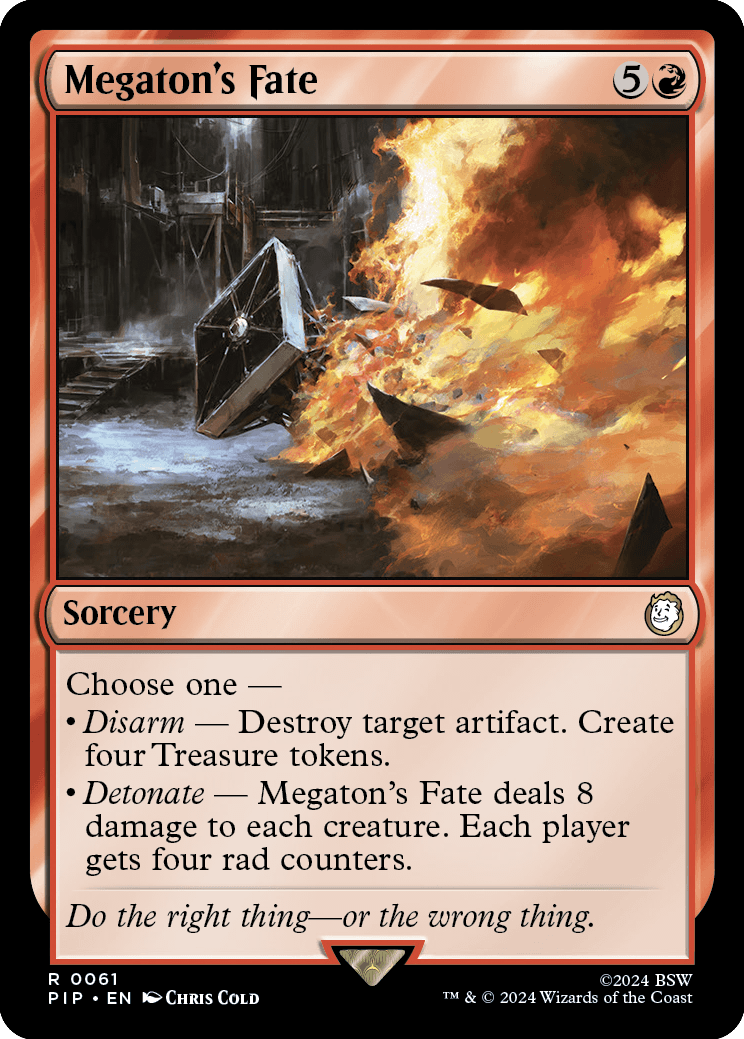
Megaton's Fate
{5}{R}
Sorcery
Choose one —
• Disarm — Destroy target artifact. Create four Treasure tokens.
• Detonate — Megaton's Fate deals 8 damage to each creature. Each player gets four rad counters.
- Rad counters are a kind of counter that a player may have. They're not associated with any specific permanents.
- Keep track of how many rad counters each player has. Potential ways to track this include writing them down on paper or using dice, but any method that is clear and mutually agreeable is fine.
- Rad counters don't go away as steps, phases, or turns end. They only go away when an effect instructs a player to remove rad counters from themselves.
- There is an inherent triggered ability associated with having rad counters. This triggered ability has no source and is controlled by the active player. The full text of this ability is "At the beginning of the precombat main phase of a player with rad counters, that player mills cards equal to the number of rad counters they have. For each nonland card milled this way, that player loses 1 life and removes one rad counter from themselves."
- In a game using the shared team turns option, such as an Archenemy or Two-Headed Giant game, the inherent triggered ability associated with rad counters triggers once for each player on the active team that has rad counters. Each instance of that ability is controlled by one of those players.
- Any effects (such as proliferate) that interact with counters a player gets, has, or loses can interact with rad counters.
- The cards are milled all at once, which means abilities that trigger "whenever one or more nonland cards are milled" will trigger exactly once as long as at least one nonland card was milled.
- If a player has fewer cards remaining in their library than the number of rad counters they have when the triggered ability resolves, they'll mill as many cards as they can.
New Mechanic: Junk Tokens
No matter where you roam in the wasteland, you'll always find Junk. It might seem useless at first, but a clever wastelander can get some use out of just about anything. As a sorcery, you can tap and sacrifice a Junk token to exile the top of your library; you'll be able to play that card this turn.
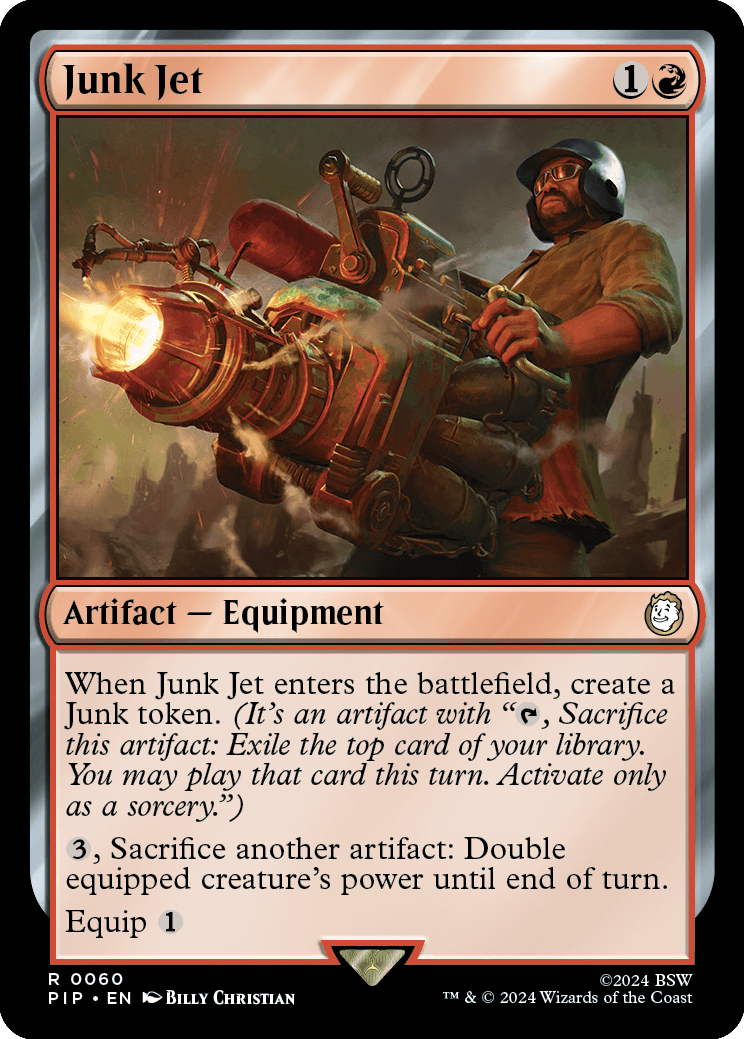
Junk Jet
{1}{R}
Artifact — Equipment
When Junk Jet enters the battlefield, create a Junk token. (It's an artifact with "{T}, Sacrifice this artifact: Exile the top card of your library. You may play that card this turn. Activate only as a sorcery.")
{3}, Sacrifice another artifact: Double equipped creature's power until end of turn.
Equip {1}
- You can't sacrifice a Junk token to pay multiple costs. For example, you can't sacrifice a Junk token to activate its own ability and also to activate the second ability of Junk Jet.
- You pay all costs and follow all normal timing rules for the card played from exile with a Junk token's ability. For example, if the exiled card is a land card, you may play it only during your main phase while the stack is empty.
- Some spells and abilities that create Junk tokens may require targets. If each target chosen is illegal as that spell or ability tries to resolve, it won't resolve and none of its effects happen. You won't create any Junk tokens.
Returning Mechanic: Energy
What do power armor, plasma weapons, and artillery satellites all have in common? They all need power sources. Rather than require you to collect fusion cores, energy cells, or large power plants, we've made it easy for you; all you need are energy counters. Just like rad counters, energy counters go on players. Unlike rad counters, they won't cause you any milling, life loss, or mutations. (At least, they haven't so far.)
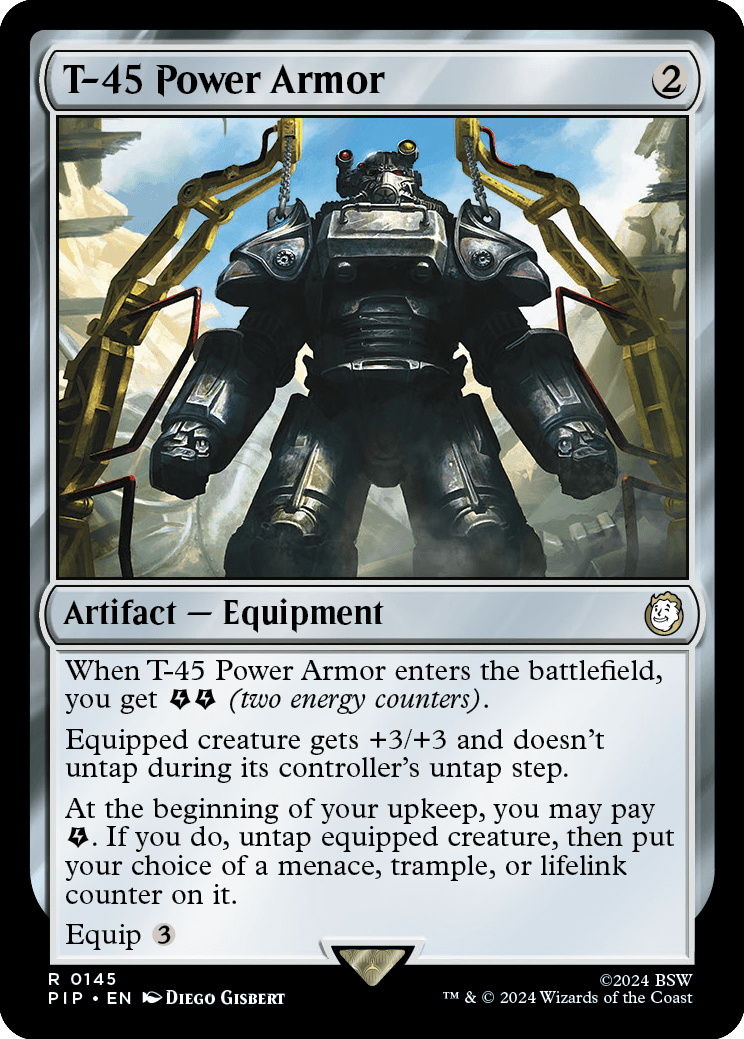
T-45 Power Armor
{2}
Artifact — Equipment
When T-45 Power Armor enters the battlefield, you get {E}{E} (two energy counters).
Equipped creature gets +3/+3 and doesn't untap during its controller's untap step.
At the beginning of your upkeep, you may pay {E}. If you do, untap equipped creature, then put your choice of a menace, trample, or lifelink counter on it.
Equip {3}
- {E} is the energy symbol. It represents one energy counter.
- Energy counters are a kind of counter that a player may have. They're not associated with any specific permanents.
- Keep track of how many energy counters each player has. Potential ways to track this include writing them down on paper or using dice, but any method that is clear and mutually agreeable is fine. (At higher levels of tournament play, dice may not be allowed for tracking counters that players have.)
- If an effect says you get one or more {E}, you get that many energy counters. To pay one or more {E}, you lose that many energy counters. You can't pay more energy counters than you have. Any effects that interact with counters a player gets, has, or loses can interact with energy counters.
- Energy counters aren't mana. They don't go away as steps, phases, and turns end, and effects that add mana "of any type" can't give you energy counters.
- Some triggered abilities state that you "may pay" a certain amount of {E}. You can't pay that amount multiple times to multiply the effect. You simply choose whether or not to pay that amount of {E} as the ability resolves.
- Some triggered abilities that state that you "may pay" a certain amount of {E} describe an effect that happens "If you do." In that case, no player may take actions to try to stop the ability's effect after you make your choice. If the payment is followed by the phrase "When you do," then you'll choose any targets for that reflexive triggered ability and put it on the stack before players can take actions.
- If a spell or ability with one or more targets states that you "may pay" some amount of {E}, and each permanent that it targets has become an illegal target, the spell or ability won't resolve. You can't pay any {E} even if you want to.
- Some spells and abilities that give you {E} may require targets. If each target chosen is an illegal target as that spell or ability tries to resolve, it won't resolve. You won't get any {E}.
Returning Mechanic: Proliferate
Resources are scarce in the wasteland, but those who are already rich tend to get richer. Similarly, those who are already irradiated tend to get more irradiated. We're representing that concept with the proliferate mechanic, which lets you add more counters to permanents and players that already have counters on them.

Atomize
{2}{B}{G}
Instant
Destroy target nonland permanent. Proliferate. (Choose any number of permanents and/or players, then give each another counter of each kind already there.)
- You can choose any permanent that has a counter, including ones controlled by opponents. You can choose any player who has a counter, including opponents. You can't choose cards in any zone other than the battlefield, even if they have counters on them.
- You don't have to choose every permanent or player that has a counter—only the ones you want to add counters to. Since "any number" includes zero, you don't have to choose any permanents at all, and you don't have to choose any players at all.
- If a player or permanent has more than one kind of counter on it, and you choose for it to get additional counters, it must get one of each kind of counter it already has. You can't have it get just one kind of counter it already has and not the others.
- Players can respond to a spell or ability whose effect includes proliferating. Once that spell or ability starts to resolve, however, and its controller chooses which permanents and players will get new counters, it's too late for anyone to respond.
- Some spells and abilities that cause you to proliferate may require targets. If each target chosen is an illegal target as that spell or ability tries to resolve, it won't resolve. You won't proliferate.
Returning Mechanic: Quest Counters
Many people in the wasteland are searching for something, be it knowledge, justice, or Nuka-Cola memorabilia. In this set, we're representing that idea with quest counters, which first appeared in the Zendikar release. Quest counters have no particular rules meaning on their own, but some cards refer to them specifically.
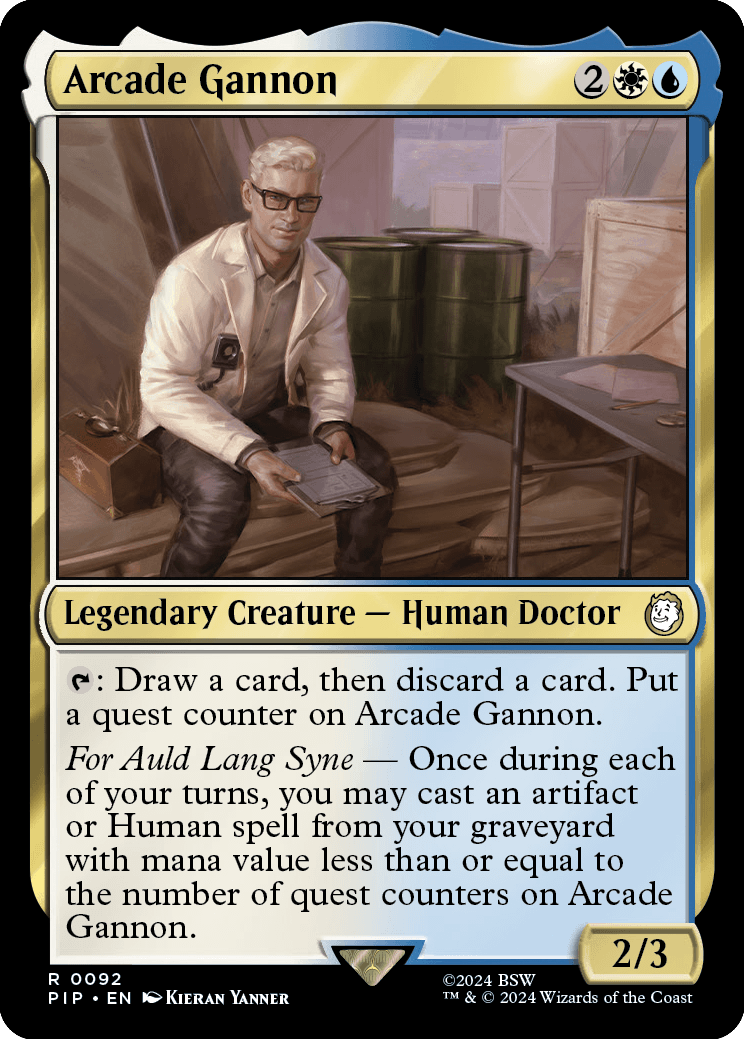
Arcade Gannon
{2}{W}{U}
Legendary Creature — Human Doctor
2/3
{T}: Draw a card, then discard a card. Put a quest counter on Arcade Gannon.
For Auld Lang Syne — Once during each of your turns, you may cast an artifact or Human spell from your graveyard with mana value less than or equal to the number of quest counters on Arcade Gannon.
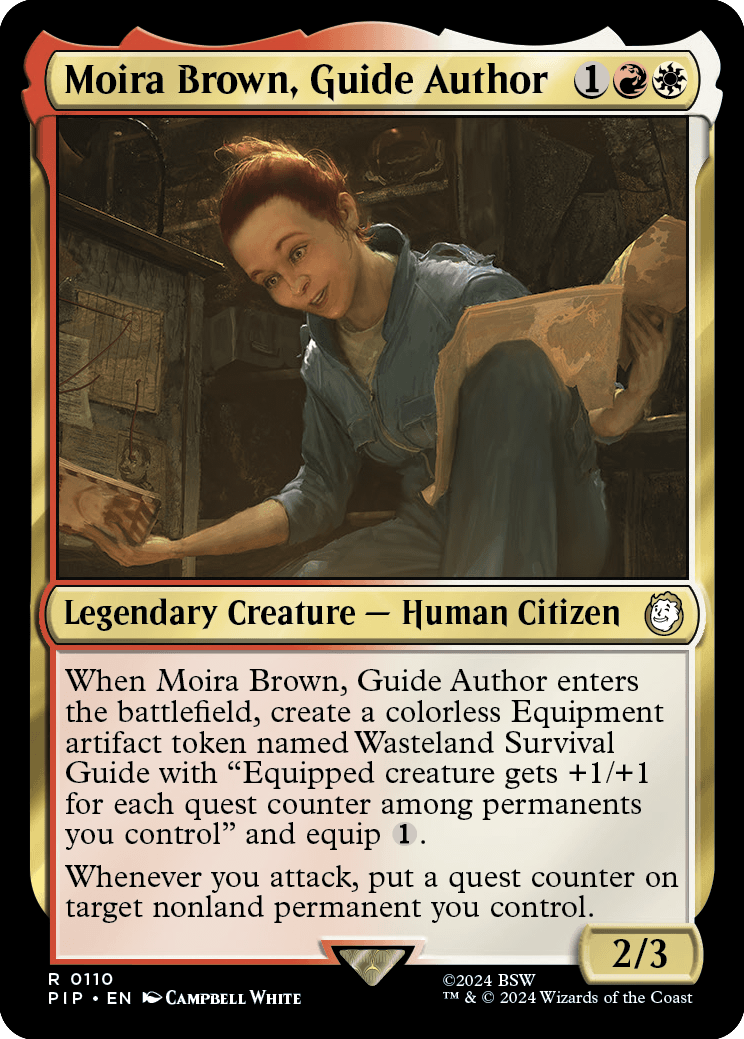
Moira Brown, Guide Author
{1}{R}{W}
Legendary Creature — Human Citizen
2/3
When Moira Brown, Guide Author enters the battlefield, create a colorless Equipment artifact token named Wasteland Survival Guide with "Equipped creature gets +1/+1 for each quest counter among permanents you control" and equip {1}.
Whenever you attack, put a quest counter on target nonland permanent you control.
Returning Mechanic: Squad
There's strength in numbers, and might makes right. These pithy aphorisms may be a bit tired, but they ring true in the wasteland, where survival is often best achieved as part of a squad. As an additional cost to cast a spell with squad, you may pay its squad cost any number of times. When that creature enters the battlefield, if its squad cost was paid, its controller creates a number of tokens that are a copy of that creature equal to the number of times its squad cost was paid.
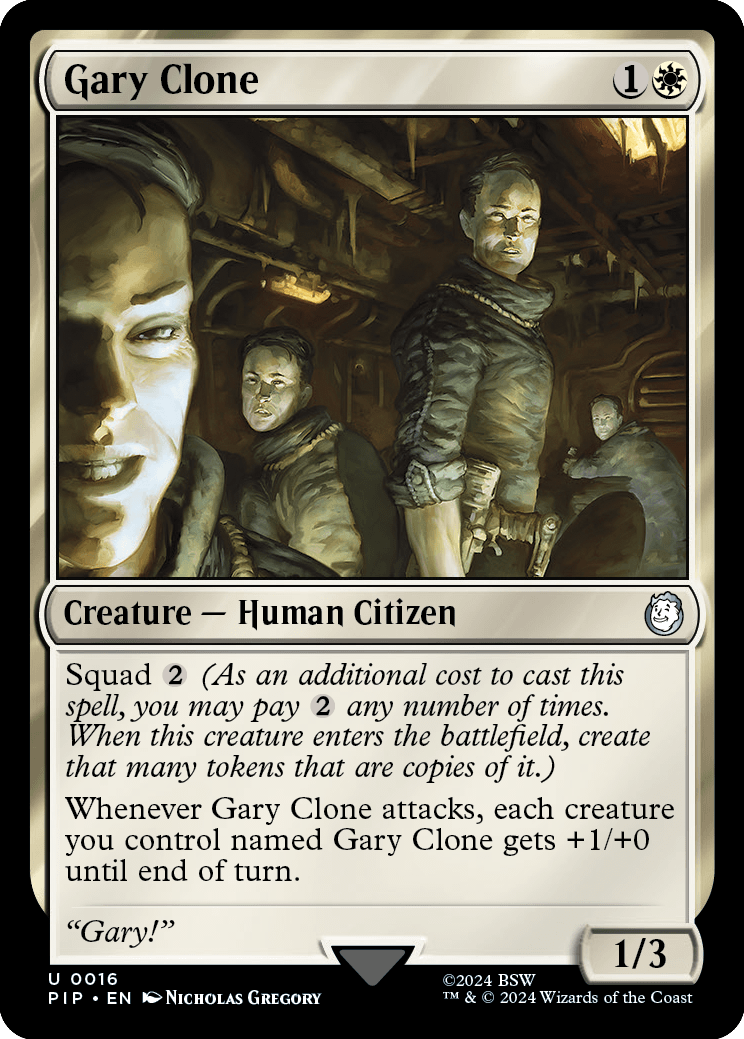
Gary Clone
{1}{W}
Creature — Human Citizen
1/3
Squad {2} (As an additional cost to cast this spell, you may pay {2} any number of times. When this creature enters the battlefield, create that many tokens that are copies of it.)
Whenever Gary Clone attacks, each creature you control named Gary Clone gets +1/+0 until end of turn.
- You may pay the squad cost any number of times. You will create a token that is a copy of that permanent for each time you paid the squad cost. If you paid the squad cost multiple times, the tokens will all enter the battlefield simultaneously.
- If the spell is countered, the squad ability will not trigger, and no tokens will be created.
- If the spell resolves but the creature with squad leaves the battlefield before its squad ability resolves, you'll still create the token copies.
- The tokens created by the squad ability aren't "cast," so any abilities that trigger when a spell is cast won't trigger for the copies.
- If, for some reason, the creature doesn't have the squad ability when it's on the battlefield, the ability won't trigger, even if you've paid the squad cost one or more times.
CARD-SPECIFIC NOTES
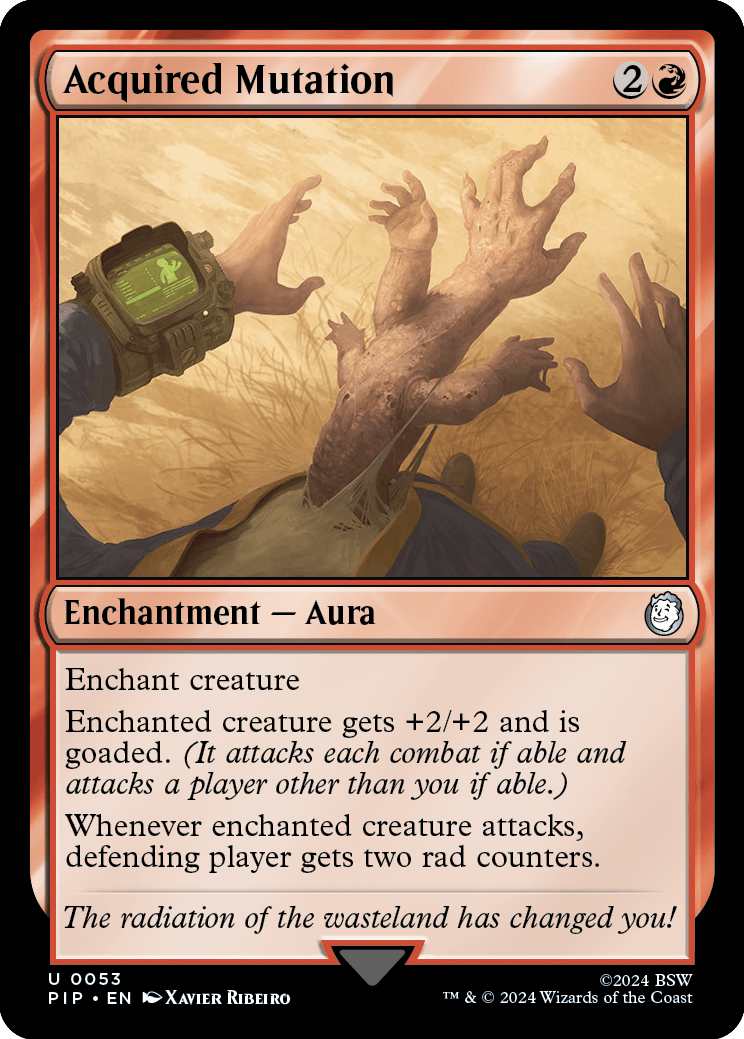
Acquired Mutation
{2}{R}
Enchantment — Aura
Enchant creature
Enchanted creature gets +2/+2 and is goaded. (It attacks each combat if able and attacks a player other than you if able.)
Whenever enchanted creature attacks, defending player gets two rad counters.
- If, during a player's declare attackers step, a creature that player controls that's been goaded is tapped, is affected by a spell or ability that says it can't attack, or hasn't been under that player's control continuously since the turn began (and doesn't have haste), then it doesn't attack. If there's a cost associated with having a creature attack a player, its controller isn't forced to pay that cost, so it doesn't have to attack that player.
- If the creature doesn't meet any of the above exceptions and can attack, it must attack a player other than the controller of the spell or ability that goaded it if able. If the creature can't attack any of those players but could otherwise attack, it must attack a planeswalker an opponent controls, a battle an opponent protects, or the player that goaded it.
- Being goaded isn't an ability the creature has. Once it's been goaded, it must attack as detailed above even if it loses all abilities.
- Attacking with a goaded creature doesn't cause it to stop being goaded. If there is an additional combat phase that turn, or if another player gains control of it before it stops being goaded, it must attack again if able.

Agent Frank Horrigan
{5}{B}{G}
Legendary Creature — Mutant Warrior
8/6
Trample
Agent Frank Horrigan has indestructible as long as it attacked this turn.
Whenever Agent Frank Horrigan enters the battlefield or attacks, proliferate twice. (To proliferate, choose any number of permanents and/or players, then give each another counter of each kind already there.)
- The ability that causes Agent Frank Horrigan to have indestructible starts to apply as soon as it's declared as an attacker. It applies for the remainder of the turn. It doesn't matter what happens to the player or permanent it attacked after that point.
- If Agent Frank Horrigan enters the battlefield attacking, it doesn't have indestructible since it was never declared as an attacker.
- While proliferating twice, players can't respond between proliferating the first time and proliferating the second time.
- If you proliferate twice, you don't have to choose the same set of players and/or permanents to get additional counters each time.
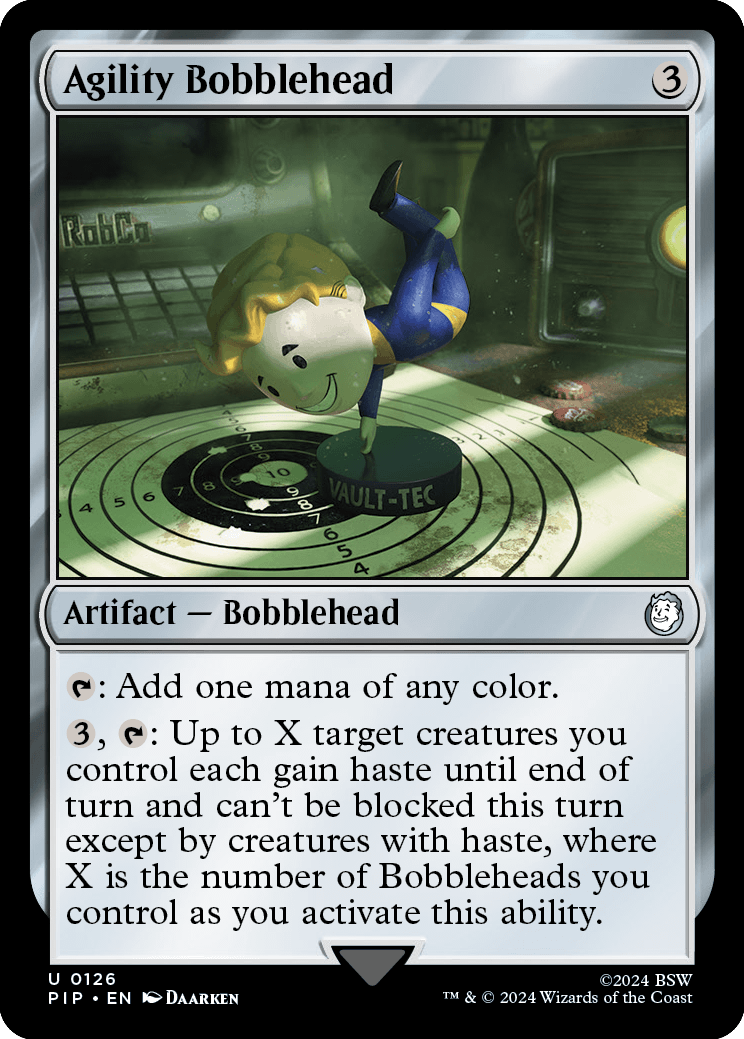
Agility Bobblehead
{3}
Artifact — Bobblehead
{T}: Add one mana of any color.
{3}, {T}: Up to X target creatures you control each gain haste until end of turn and can't be blocked this turn except by creatures with haste, where X is the number of Bobbleheads you control as you activate this ability.
- You choose how many targets Agility Bobblehead's last ability has as you activate the ability. Once you do, it doesn't matter what happens to any Bobbleheads you control.
- Activating Agility Bobblehead's last ability targeting a creature that has already been blocked by a creature without haste won't cause that creature to become unblocked.
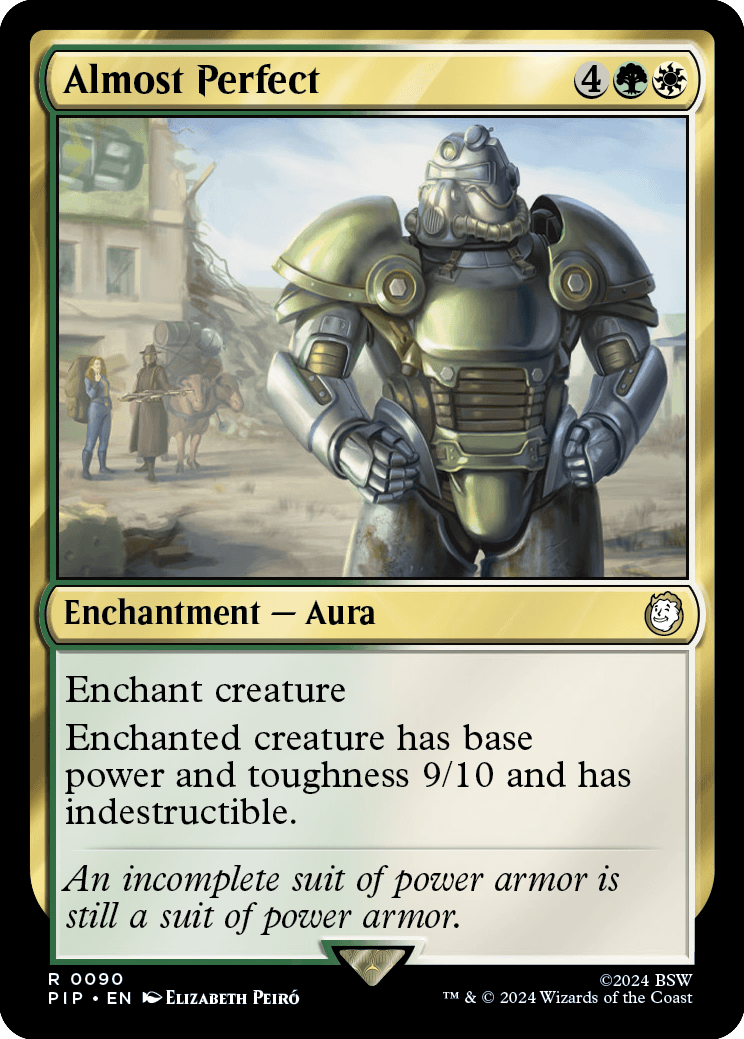
Almost Perfect
{4}{G}{W}
Enchantment — Aura
Enchant creature
Enchanted creature has base power and toughness 9/10 and has indestructible.
- Almost Perfect overwrites all previous effects that set the creature's base power and toughness to specific values. Any power- or toughness-setting effects that start to apply after the ability resolves will overwrite this effect.
- Effects that modify a creature's power and/or toughness, such as the effect of the ability granted by Idolized, will apply to the creature no matter when they started to take effect. The same is true for any counters that change its power and/or toughness and effects that switch its power and toughness.
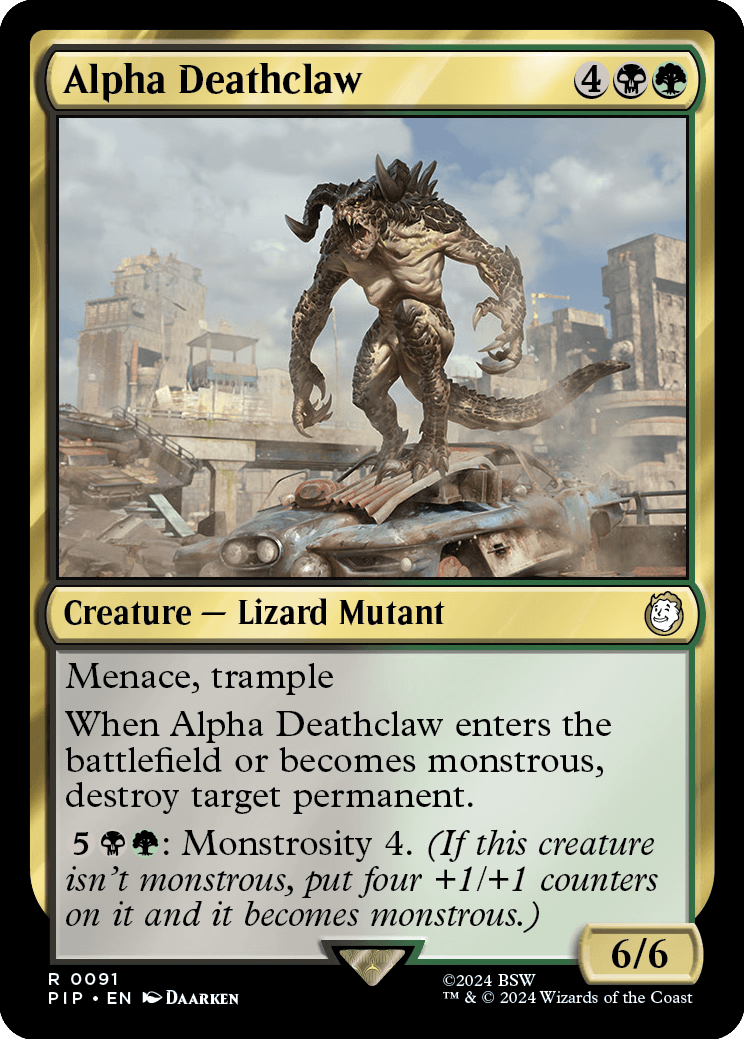
Alpha Deathclaw
{4}{B}{G}
Creature — Lizard Mutant
6/6
Menace, trample
When Alpha Deathclaw enters the battlefield or becomes monstrous, destroy target permanent.
{5}{B}{G}: Monstrosity 4. (If this creature isn't monstrous, put four +1/+1 counters on it and it becomes monstrous.)
- Once a creature becomes monstrous, it can't become monstrous again. If the creature is already monstrous when the monstrosity ability resolves, nothing happens.
- Monstrous isn't an ability that a creature has. It's just something true about that creature. If the creature stops being a creature or loses its abilities, it will continue to be monstrous.
- An ability that triggers when a creature becomes monstrous won't trigger if that creature isn't on the battlefield when its monstrosity ability resolves.
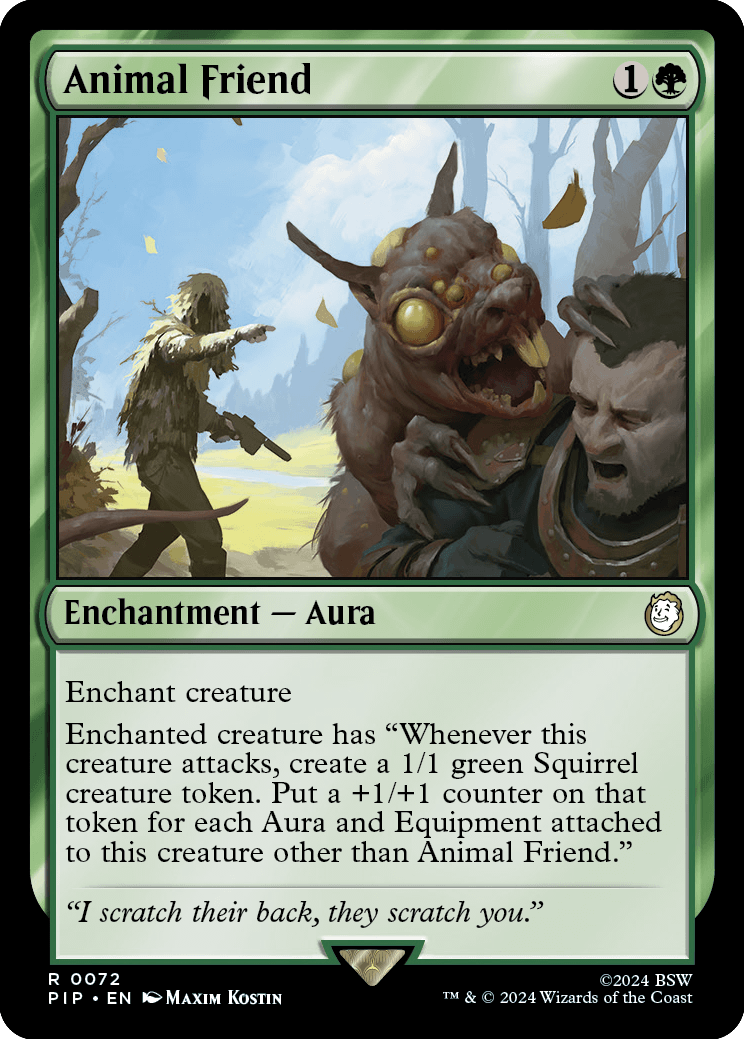
Animal Friend
{1}{G}
Enchantment — Aura
Enchant creature
Enchanted creature has "Whenever this creature attacks, create a 1/1 green Squirrel creature token. Put a +1/+1 counter on that token for each Aura and Equipment attached to this creature other than Animal Friend."
- The token will enter the battlefield and then have counters put on it. In most cases, the game will see a 1/1 creature entering the battlefield for the purposes of any abilities that may trigger, such as the first ability of Overseer of Vault 76.
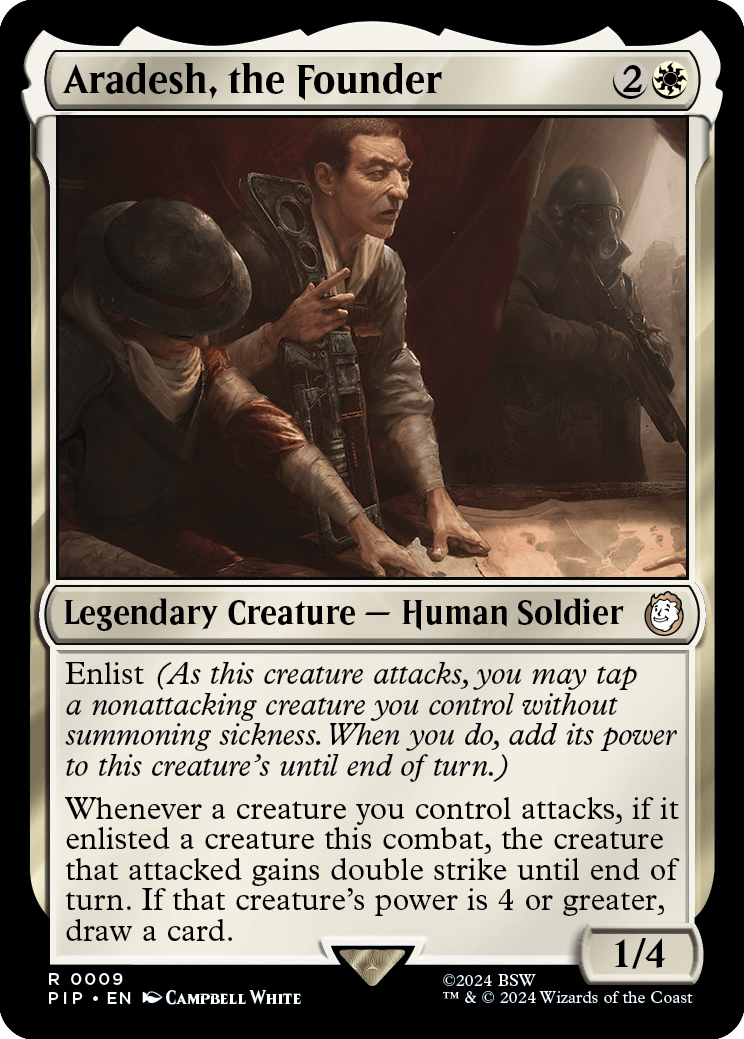
Aradesh, the Founder
{2}{W}
Legendary Creature — Human Soldier
1/4
Enlist (As this creature attacks, you may tap a nonattacking creature you control without summoning sickness. When you do, add its power to this creature's until end of turn.)
Whenever a creature you control attacks, if it enlisted a creature this combat, the creature that attacked gains double strike until end of turn. If that creature's power is 4 or greater, draw a card.
- The attacking player chooses whether to tap a creature for an enlist ability immediately after they tap the creatures that they have chosen to attack with. You can't choose to enlist a creature later.
- To enlist a creature, that creature must be untapped, it must not be attacking (even if it has vigilance), and it must have haste or have been under that attacking player's control since the beginning of their current turn.
- When a player taps a creature for an attacking creature's enlist ability, that attacking creature gets +X/+0 until end of turn, where X is the tapped creature's power. This is a triggered ability that goes on the stack immediately after attackers have been declared in the declare attackers step.
- You may tap only one creature for an enlist ability of an attacking creature, and a single creature can't be tapped for more than one enlist ability.
- Aradesh's last ability has an intervening if clause. If a creature that attacks hasn't enlisted a creature this combat, the ability won't trigger at all for that creature.
- It doesn't matter what happens to the enlisted creature after Aradesh's last ability triggers. As long as the creature that attacked enlisted a creature this combat, when Aradesh's last ability resolves, the creature that attacked will still get double strike, and if that creature's power is 4 or greater, you'll still draw a card.

Arcade Gannon
{2}{W}{U}
Legendary Creature — Human Doctor
2/3
{T}: Draw a card, then discard a card. Put a quest counter on Arcade Gannon.
For Auld Lang Syne — Once during each of your turns, you may cast an artifact or Human spell from your graveyard with mana value less than or equal to the number of quest counters on Arcade Gannon.
- You must follow the normal timing permissions and restrictions of the spell you cast from your graveyard.
- You must pay the costs to cast that spell. If it has an alternative cost, you may cast it for that cost instead.
- Once you begin to cast the spell, losing control of Arcade Gannon won't affect the spell.
- If you cast an artifact or Human spell from your graveyard using another permission, Arcade Gannon's effect doesn't apply. You can cast another artifact or Human spell from your graveyard.
- If you cast one artifact or Human spell from your graveyard and then have a new Arcade Gannon come under your control in the same turn, you may cast another artifact or Human spell from your graveyard that turn as long as that spell has mana value less than or equal to the number of quest counters on the new Arcade Gannon.
- If an artifact or Human card is put into your graveyard during your main phase and the stack is empty, you have a chance to cast it before any player may attempt to remove that card from your graveyard.
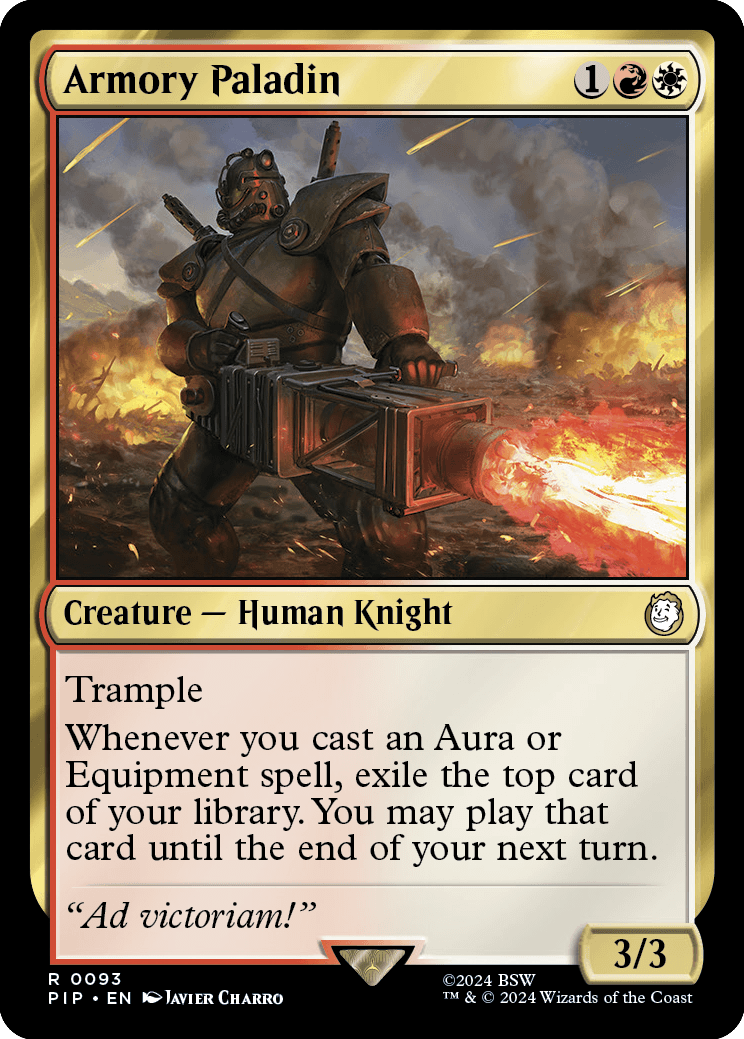
Armory Paladin
{1}{R}{W}
Creature — Human Knight
3/3
Trample
Whenever you cast an Aura or Equipment spell, exile the top card of your library. You may play that card until the end of your next turn.
- Once Armory Paladin's last ability resolves, it doesn't matter what happens to Armory Paladin after that. You'll still be able to play the exiled card until the end of your next turn.
- You pay all costs and follow all normal timing rules for a card played this way. For example, if the exiled card is a land card, you may play it only during your main phase while the stack is empty.
- If the card exiled with Armory Paladin's last ability is an Aura or Equipment card, casting it will cause Armory Paladin's last ability to trigger again.
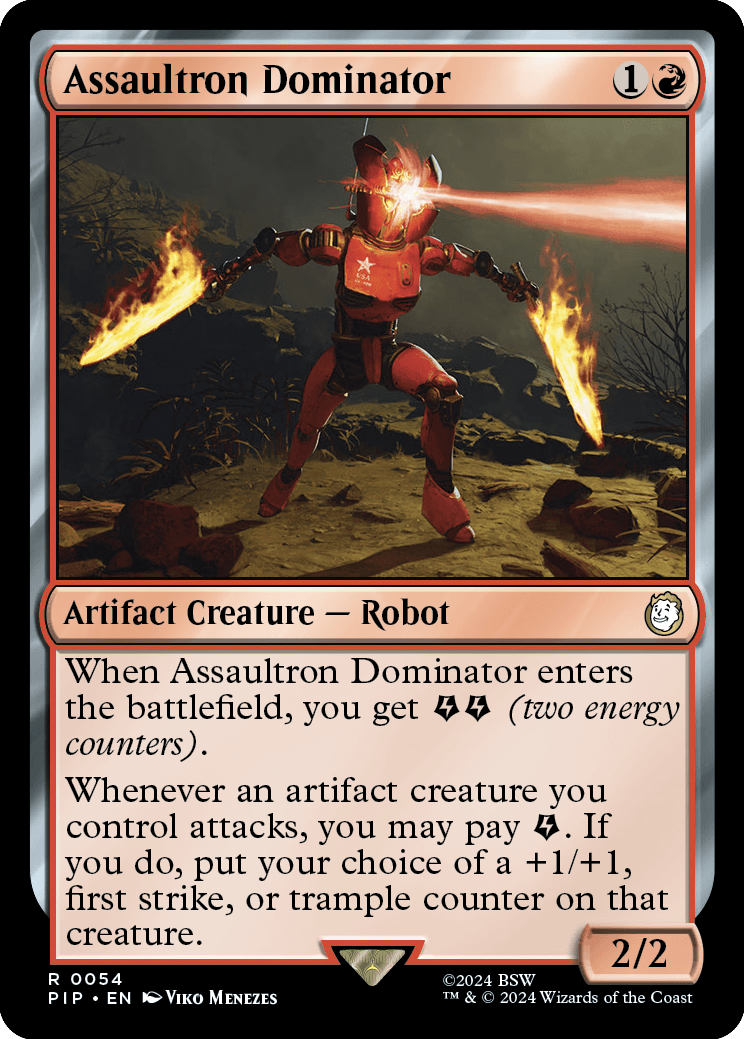
Assaultron Dominator
{1}{R}
Artifact Creature — Robot
2/2
When Assaultron Dominator enters the battlefield, you get {E}{E} (two energy counters).
Whenever an artifact creature you control attacks, you may pay {E}. If you do, put your choice of a +1/+1, first strike, or trample counter on that creature.
- If multiple artifact creatures you control attack, Assaultron Dominator's last ability triggers for each of them.
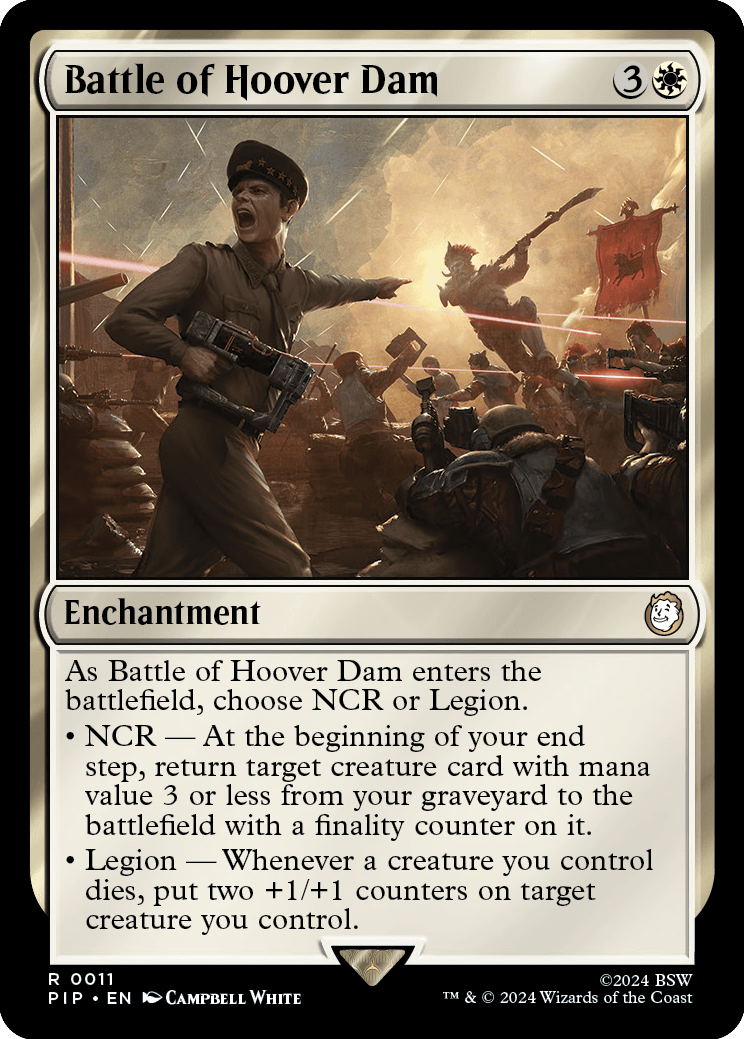
Battle of Hoover Dam
{3}{W}
Enchantment
As Battle of Hoover Dam enters the battlefield, choose NCR or Legion.
• NCR — At the beginning of your end step, return target creature card with mana value 3 or less from your graveyard to the battlefield with a finality counter on it.
• Legion — Whenever a creature you control dies, put two +1/+1 counters on target creature you control.
- Finality counters work on any permanent, not only creatures. If a permanent with a finality counter on it would be put into a graveyard from the battlefield, exile it instead.
- Finality counters don't stop permanents from going to zones other than the graveyard from the battlefield. For example, if a permanent with a finality counter on it would be put into its owner's hand from the battlefield, it does so normally.
- Finality counters aren't keyword counters, and a finality counter doesn't give any abilities to the permanent it's on. If that permanent loses its abilities and then would go to a graveyard, it will still be exiled instead.
- Multiple finality counters on a single permanent are redundant.
- If you somehow control Battle of Hoover Dam and no choice was made for it (perhaps because another permanent on the battlefield became a copy of it), it has neither of the two triggered abilities.
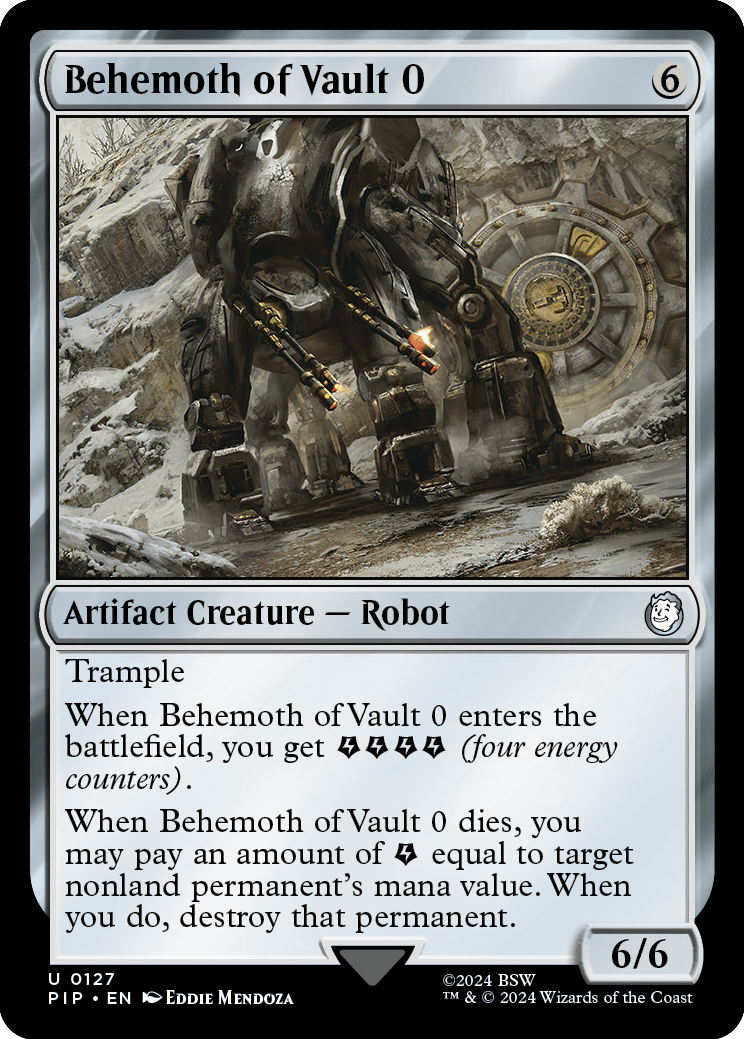
Behemoth of Vault 0
{6}
Artifact Creature — Robot
6/6
Trample
When Behemoth of Vault 0 enters the battlefield, you get {E}{E}{E}{E} (four energy counters).
When Behemoth of Vault 0 dies, you may pay an amount of {E} equal to target nonland permanent's mana value. When you do, destroy that permanent.
- You choose the target of Behemoth of Vault 0's last ability when it triggers, but you don't have to decide whether or not to pay until the ability resolves.
- When you pay {E} equal to the target nonland permanent's mana value during the resolution of Behemoth of Vault 0's last ability, a second "reflexive" ability triggers and is put onto the stack. This ability does not have a target. Each player may respond to this triggered ability as normal.
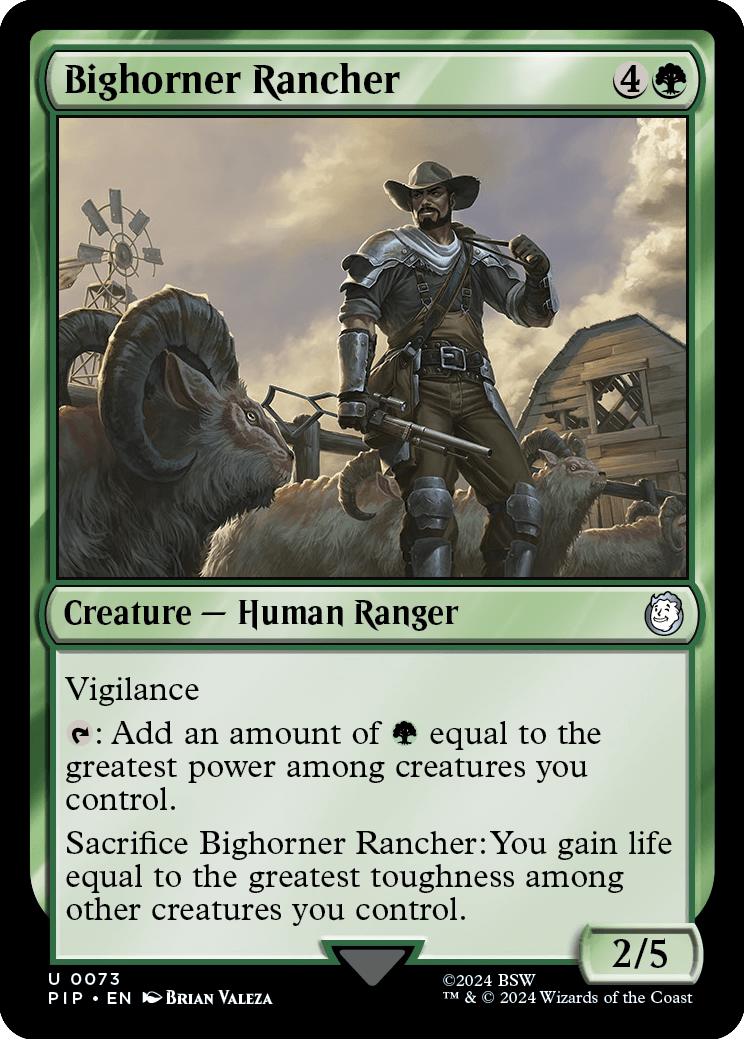
Bighorner Rancher
{4}{G}
Creature — Human Ranger
2/5
Vigilance
{T}: Add an amount of {G} equal to the greatest power among creatures you control.
Sacrifice Bighorner Rancher: You gain life equal to the greatest toughness among other creatures you control.
- Bighorner Rancher's second ability is a mana ability. It doesn't use the stack and can't be responded to. If the greatest power among creatures you control is somehow 0 or less, no mana is added.
- The amount of life you gain from Bighorner Rancher's last ability is determined when the ability resolves. If at that time the greatest toughness among creatures you control is 0 or less (probably because all of your other creatures were destroyed or otherwise left the battlefield in response), you won't gain any life.
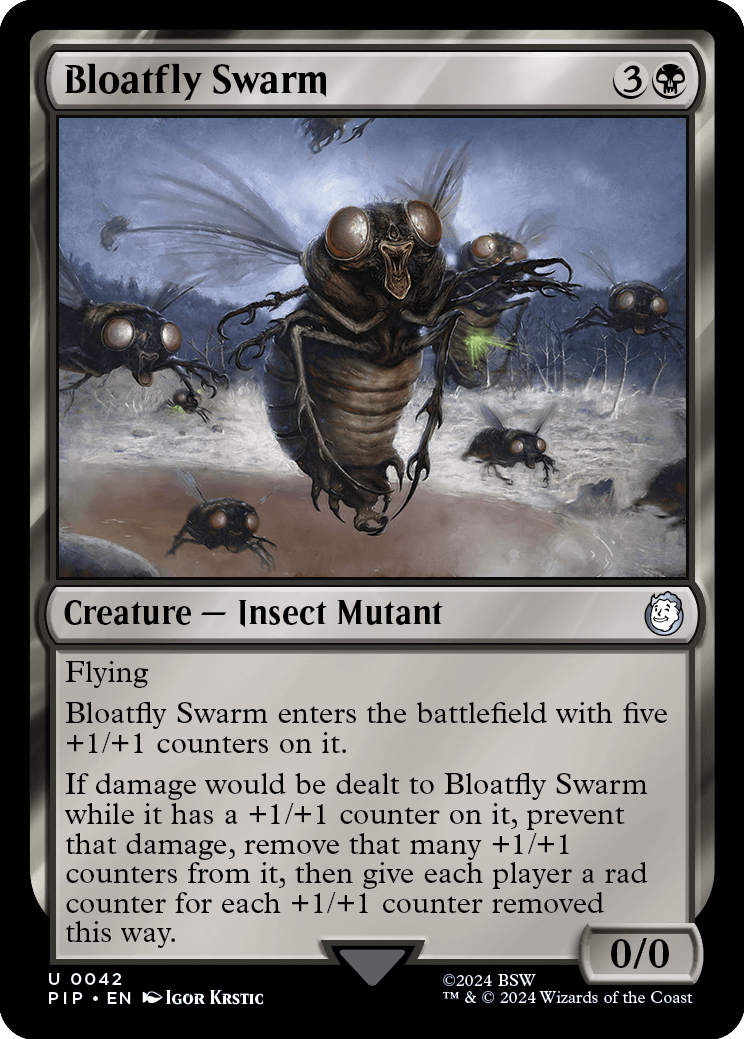
Bloatfly Swarm
{3}{B}
Creature — Insect Mutant
0/0
Flying
Bloatfly Swarm enters the battlefield with five +1/+1 counters on it.
If damage would be dealt to Bloatfly Swarm while it has a +1/+1 counter on it, prevent that damage, remove that many +1/+1 counters from it, then give each player a rad counter for each +1/+1 counter removed this way.
- If damage that can't be prevented is dealt to Bloatfly Swarm, you still remove that many +1/+1 counters from it, and you still give each player a rad counter for each +1/+1 counter removed this way.
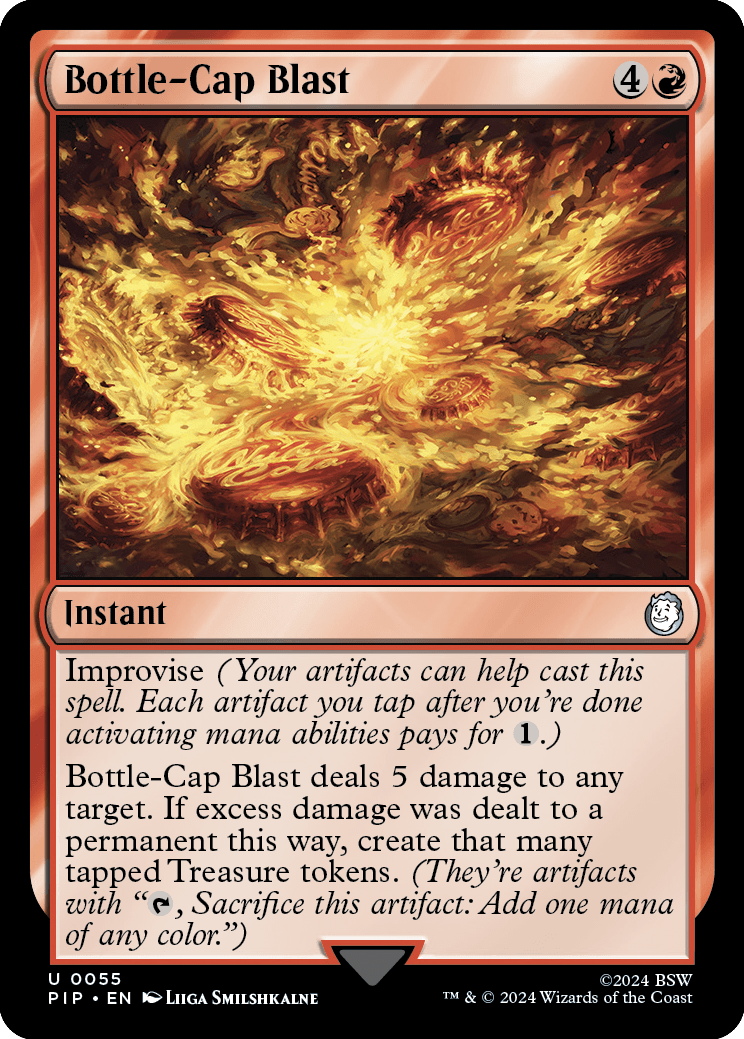
Bottle-Cap Blast
{4}{R}
Instant
Improvise (Your artifacts can help cast this spell. Each artifact you tap after you're done activating mana abilities pays for {1}.)
Bottle-Cap Blast deals 5 damage to any target. If excess damage was dealt to a permanent this way, create that many tapped Treasure tokens. (They're artifacts with "{T}, Sacrifice this artifact: Add one mana of any color.")
- Improvise doesn't change Bottle-Cap Blast's mana cost or mana value, and it can't reduce Bottle-Cap Blast's cost below {R}.
- Excess damage has been dealt to a creature if the damage dealt to it is greater than lethal damage. Usually, this means damage greater than its toughness, although damage already marked on the creature is taken into account.
- For a planeswalker, excess damage means damage in excess of the planeswalker's loyalty (the number of loyalty counters it has on it). For a battle, excess damage means damage in excess of the battle's defense (the number of defense counters it has on it).

Brotherhood Outcast
{2}{W}
Creature — Human Soldier
3/2
When Brotherhood Outcast enters the battlefield, choose one —
• Return target Aura or Equipment card with mana value 3 or less from your graveyard to the battlefield.
• Put a shield counter on target creature. (If it would be dealt damage or destroyed, remove a shield counter from it instead.)
- If an Aura is put onto the battlefield without being cast, the Aura's controller-to-be chooses what it will enchant as it comes back onto the battlefield. An Aura put onto the battlefield this way doesn't target anything (so it could be attached to an opponent's permanent with hexproof, for example), but the Aura's enchant ability restricts what it can be attached to. If the Aura can't legally be attached to anything, it remains in its current zone.
- Shield counters don't prevent players from sacrificing creatures.
- Removing a shield counter when a permanent would be dealt damage or destroyed isn't the same as regenerating a creature.
- If a permanent that would be dealt damage has more than one shield counter on it, that damage is prevented and only one shield counter is removed.
- If a permanent with a shield counter is dealt unpreventable damage, that damage will be dealt and a shield counter will still be removed.
- A creature with a shield counter on it may still be destroyed by state-based actions if it has damage marked on it equal to its toughness or has been dealt unpreventable damage by a source with deathtouch.
- "Shield" is not an ability that creatures have and shield counters are not keyword counters. If a creature with a shield counter loses its abilities, the shield counter will still protect it as normal.
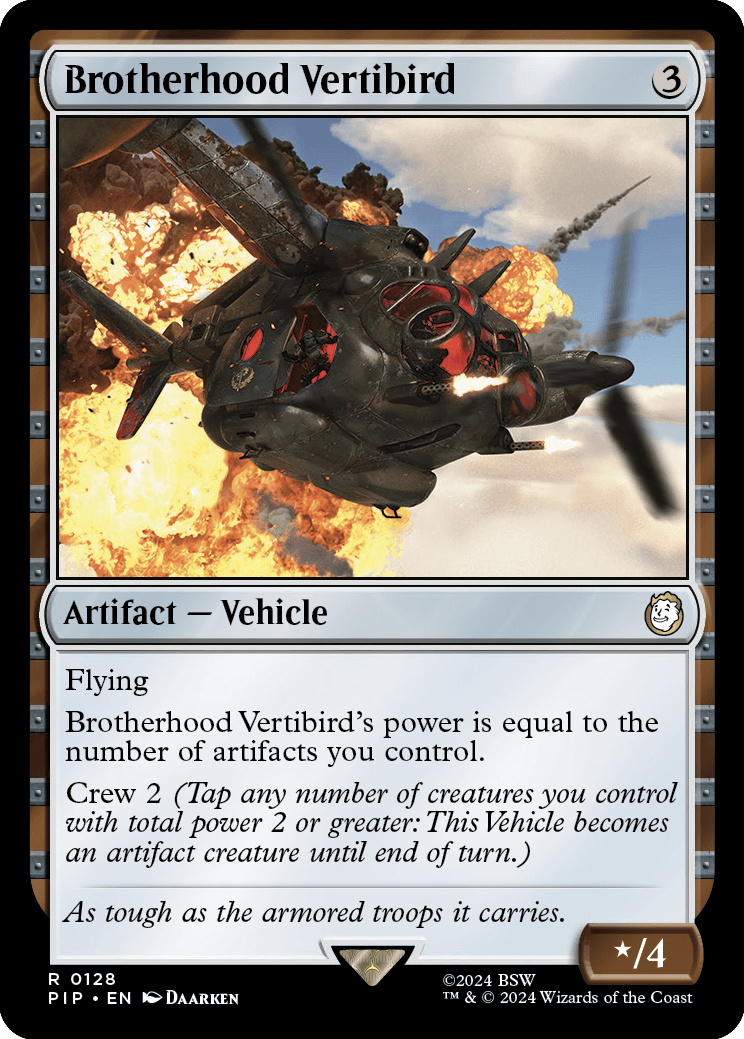
Brotherhood Vertibird
{3}
Artifact — Vehicle
*/4
Flying
Brotherhood Vertibird's power is equal to the number of artifacts you control.
Crew 2 (Tap any number of creatures you control with total power 2 or greater: This Vehicle becomes an artifact creature until end of turn.)
- The ability that defines Brotherhood Vertibird's power works in all zones, not just the battlefield. As long as Brotherhood Vertibird is on the battlefield (and still an artifact), that ability will count Brotherhood Vertibird itself.
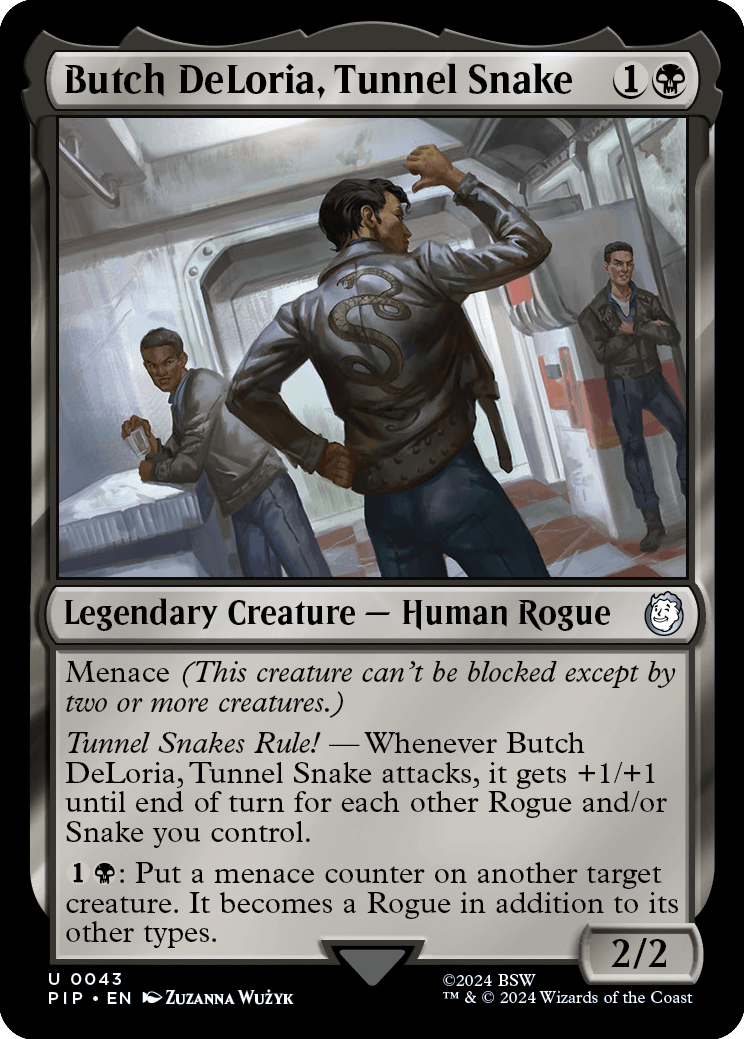
Butch DeLoria, Tunnel Snake
{1}{B}
Legendary Creature — Human Rogue
2/2
Menace (This creature can't be blocked except by two or more creatures.)
Tunnel Snakes Rule! — Whenever Butch DeLoria, Tunnel Snake attacks, it gets +1/+1 until end of turn for each other Rogue and/or Snake you control.
{1}{B}: Put a menace counter on another target creature. It becomes a Rogue in addition to its other types.
- A permanent that's both a Rogue and a Snake is counted only once for Butch DeLoria's second ability.
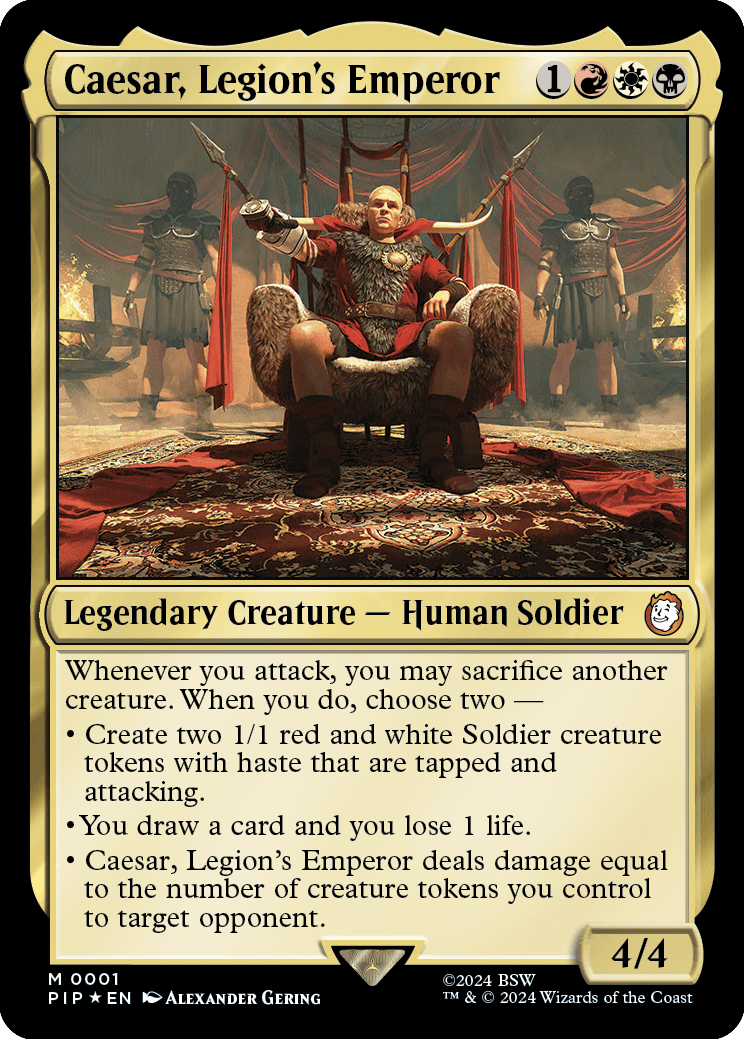
Caesar, Legion's Emperor
{1}{R}{W}{B}
Legendary Creature — Human Soldier
4/4
Whenever you attack, you may sacrifice another creature. When you do, choose two —
• Create two 1/1 red and white Soldier creature tokens with haste that are tapped and attacking.
• You draw a card and you lose 1 life.
• Caesar, Legion's Emperor deals damage equal to the number of creature tokens you control to target opponent.
- You don't choose modes or a target for Caesar, Legion's Emperor's ability at the time it triggers. Rather, a second "reflexive" ability triggers when you sacrifice another creature this way. You choose modes and, if you chose the third mode, a target for that ability as it goes on the stack. Each player may respond to this triggered ability as normal.
- The Soldier tokens created by Caesar's ability enter the battlefield tapped and attacking, but since they weren't declared as attacking creatures, no abilities that trigger whenever a creature attacks or whenever you attack (such as Caesar's own ability) will trigger.
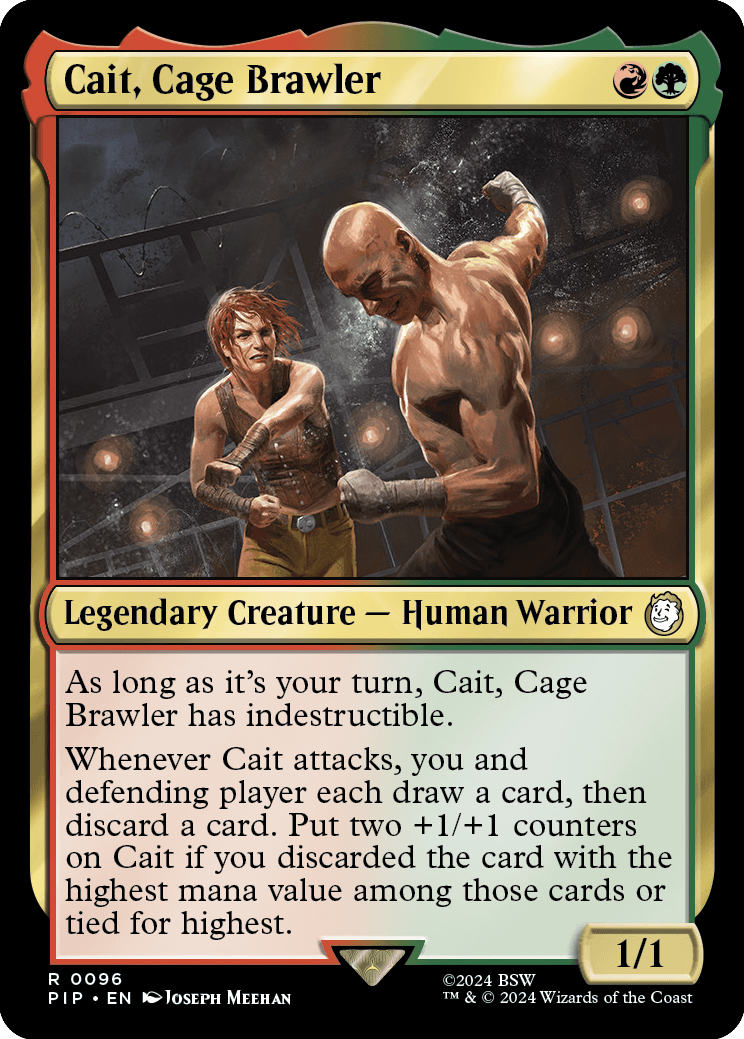
Cait, Cage Brawler
{R}{G}
Legendary Creature — Human Warrior
1/1
As long as it's your turn, Cait, Cage Brawler has indestructible.
Whenever Cait attacks, you and defending player each draw a card, then discard a card. Put two +1/+1 counters on Cait if you discarded the card with the highest mana value among those cards or tied for highest.
- If a card you discard has {X} in its mana cost, X is considered to be 0.
- If you somehow can't discard a card (probably because you had no cards in hand and another effect prevented you from drawing cards), you won't put any counters on Cait no matter whether or not the defending player discarded a card or what that card's mana value is.
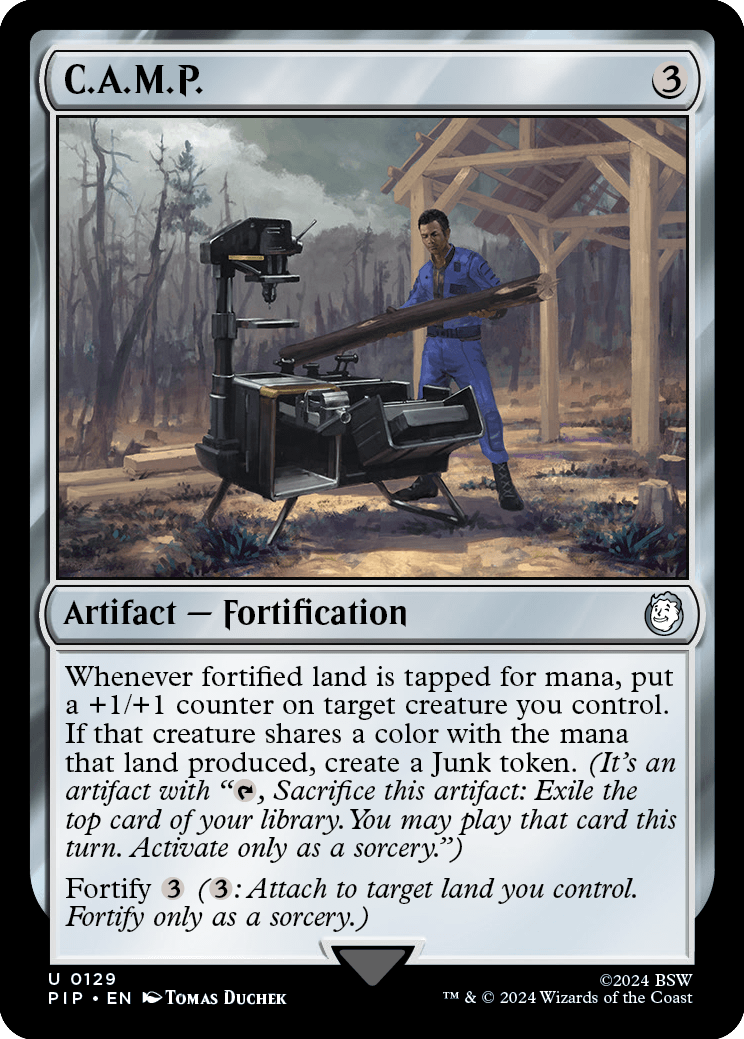
C.A.M.P.
{3}
Artifact — Fortification
Whenever fortified land is tapped for mana, put a +1/+1 counter on target creature you control. If that creature shares a color with the mana that land produced, create a Junk token. (It's an artifact with "{T}, Sacrifice this artifact: Exile the top card of your library. You may play that card this turn. Activate only as a sorcery.")
Fortify {3} ({3}: Attach to target land you control. Fortify only as a sorcery.)
- Fortification is to lands what Equipment is to creatures. Except for the difference regarding what type of permanent they can be attached to, Fortifications and Equipment follow the same rules.
- If the fortified land produced more than one color of mana, you'll create a Junk token as long as the target creature is at least one of those colors.

Cass, Hand of Vengeance
{2}{R}{W}
Legendary Creature — Human Ranger
4/3
Vigilance
Whenever Cass or another creature you control dies, if it was enchanted or equipped, return any number of Aura cards that were attached to it from your graveyard to the battlefield attached to target creature, then attach any number of Equipment that were attached to it to that creature.
- You can't return Aura cards that can't legally be attached to the target creature. For example, if the target creature has protection from red, you can't return Grim Reaper's Sprint to the battlefield with Cass's last ability.
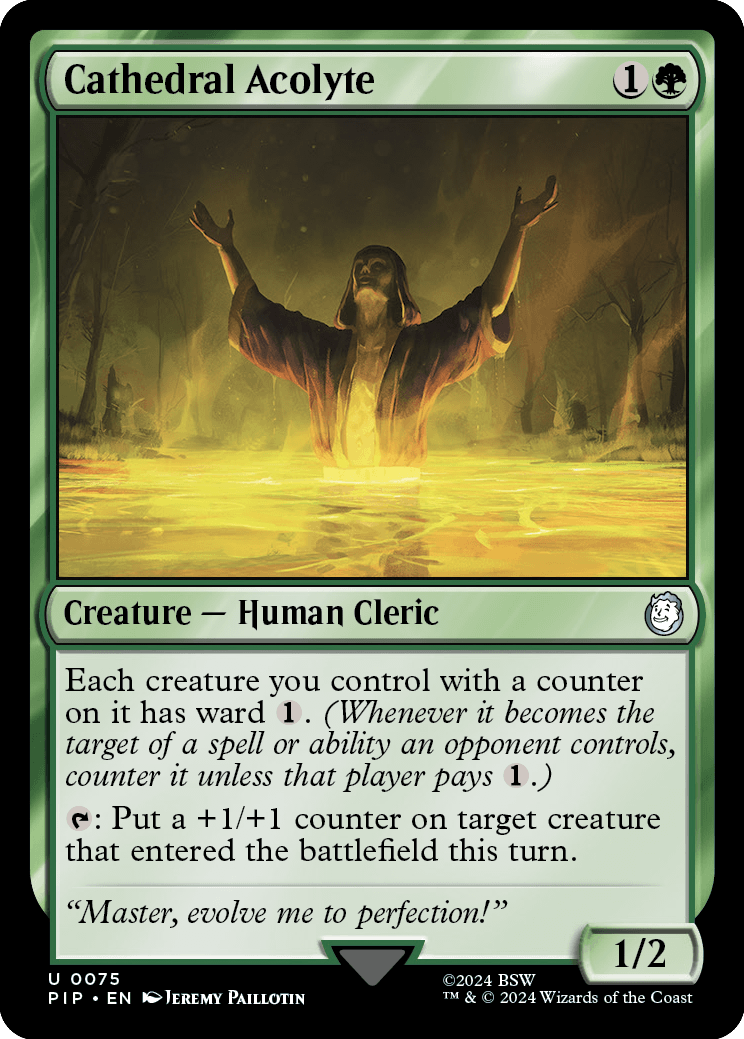
Cathedral Acolyte
{1}{G}
Creature — Human Cleric
1/2
Each creature you control with a counter on it has ward {1}. (Whenever it becomes the target of a spell or ability an opponent controls, counter it unless that player pays {1}.)
{T}: Put a +1/+1 counter on target creature that entered the battlefield this turn.
- The effect of Cathedral Acolyte's first ability applies to any creature you control with a counter on it, not just ones with +1/+1 counters.
- Once a creature's ward ability has triggered, causing that creature to lose ward by removing Cathedral Acolyte won't affect the ability. The appropriate player will still have to pay {1} or see their spell or ability countered.
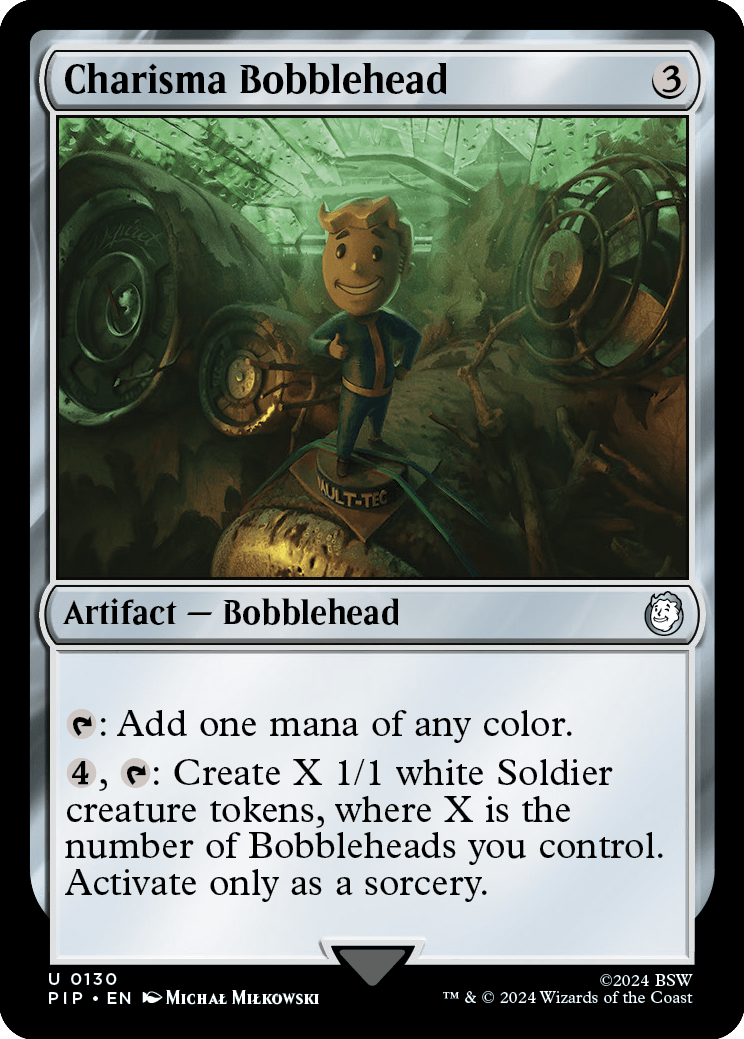
Charisma Bobblehead
{3}
Artifact — Bobblehead
{T}: Add one mana of any color.
{4}, {T}: Create X 1/1 white Soldier creature tokens, where X is the number of Bobbleheads you control. Activate only as a sorcery.
- The value of X is calculated only once, as Charisma Bobblehead's last ability resolves.
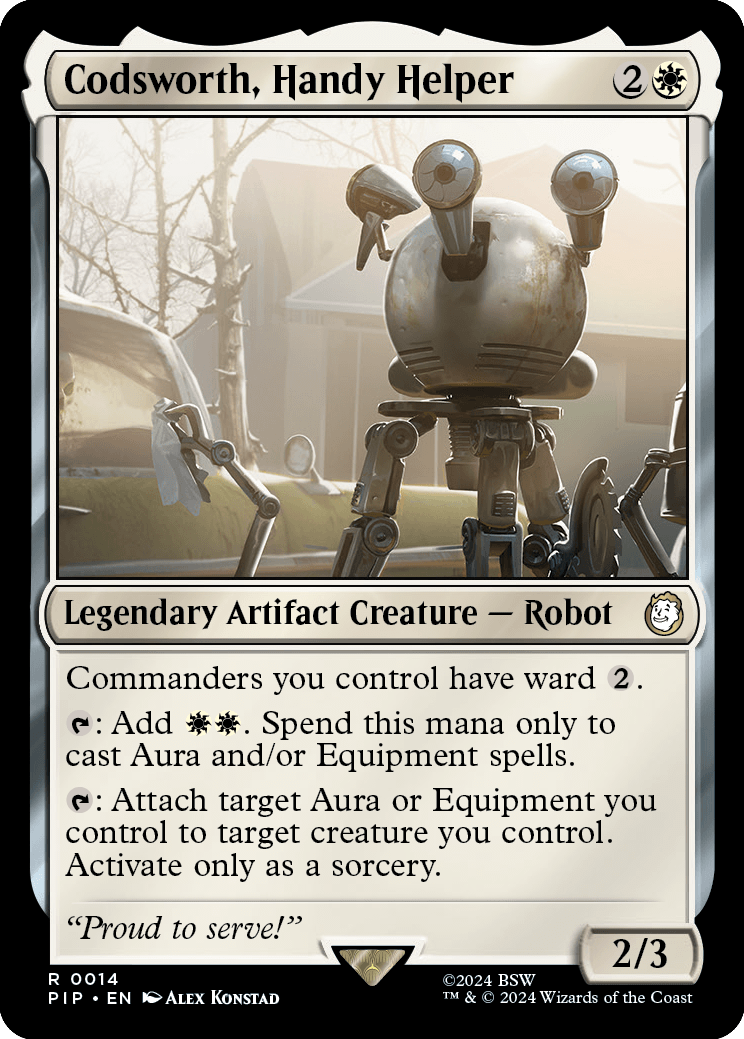
Codsworth, Handy Helper
{2}{W}
Legendary Artifact Creature — Robot
2/3
Commanders you control have ward {2}.
{T}: Add {W}{W}. Spend this mana only to cast Aura and/or Equipment spells.
{T}: Attach target Aura or Equipment you control to target creature you control. Activate only as a sorcery.
- Once a commander's ward ability has triggered, causing that commander to lose ward by removing Codsworth won't affect the ability. The appropriate player will still have to pay {2} or see their spell or ability countered.
- You can't spend mana generated by Codsworth's second ability to activate abilities of Auras or Equipment. This includes paying equip costs.
- The Aura or Equipment you target with Codsworth's last ability doesn't have to be attached to a creature you control when you target it. You just have to control the Aura or Equipment you're targeting as well as the creature you're targeting.
- If either target of Codsworth's last ability is an illegal target as the ability resolves, the ability won't do anything. If both targets are illegal, the ability won't resolve. If the target Aura or Equipment is already attached to the target creature, nothing happens.
- As Codsworth's last ability resolves, if the target Aura or Equipment can't legally be attached to the target creature (for example, because the creature has protection from enchantments or protection from artifacts), the target Aura or Equipment won't move.
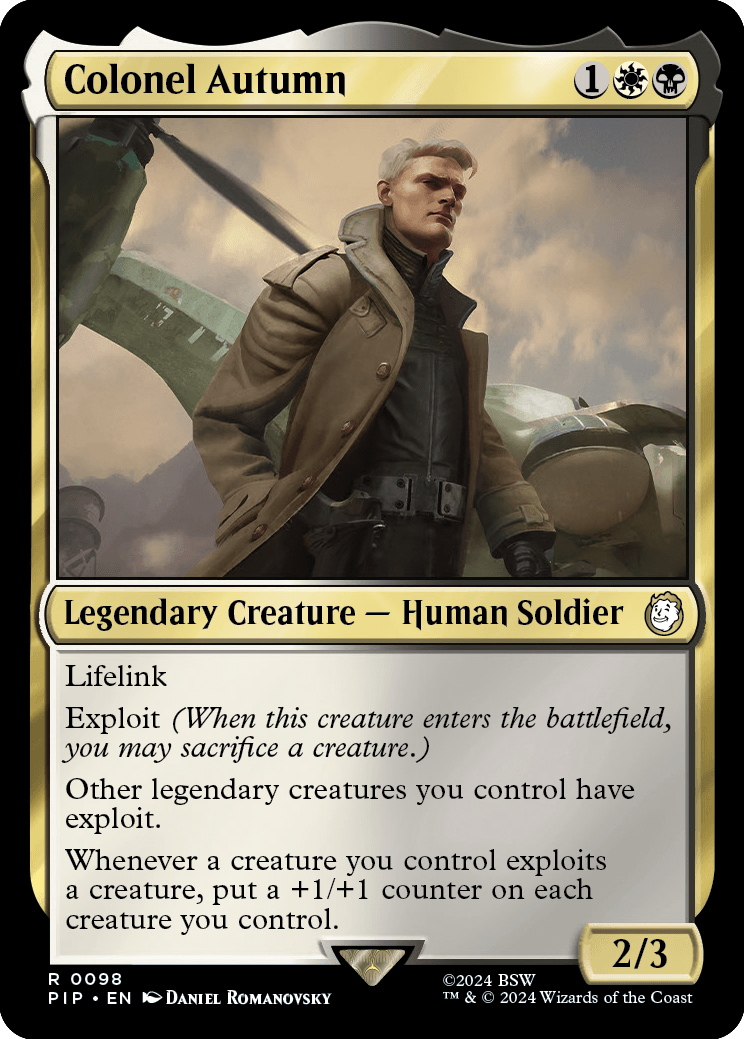
Colonel Autumn
{1}{W}{B}
Legendary Creature — Human Soldier
2/3
Lifelink
Exploit (When this creature enters the battlefield, you may sacrifice a creature.)
Other legendary creatures you control have exploit.
Whenever a creature you control exploits a creature, put a +1/+1 counter on each creature you control.
- A creature with exploit "exploits a creature" when the controller of an exploit ability sacrifices a creature as that ability resolves.
- You choose whether to sacrifice a creature and which creature to sacrifice as an exploit ability resolves.
- You can sacrifice the creature with exploit if it's still on the battlefield. If it has an ability that triggers when it exploits a creature (or, in this case, when any creature you control exploits a creature), that ability will trigger.
- If Colonel Autumn isn't on the battlefield as an exploit ability of a creature you control resolves, Colonel Autumn's last ability won't trigger. You won't get +1/+1 counters, even if you sacrifice a creature.
- You can't sacrifice more than one creature to any one exploit ability.
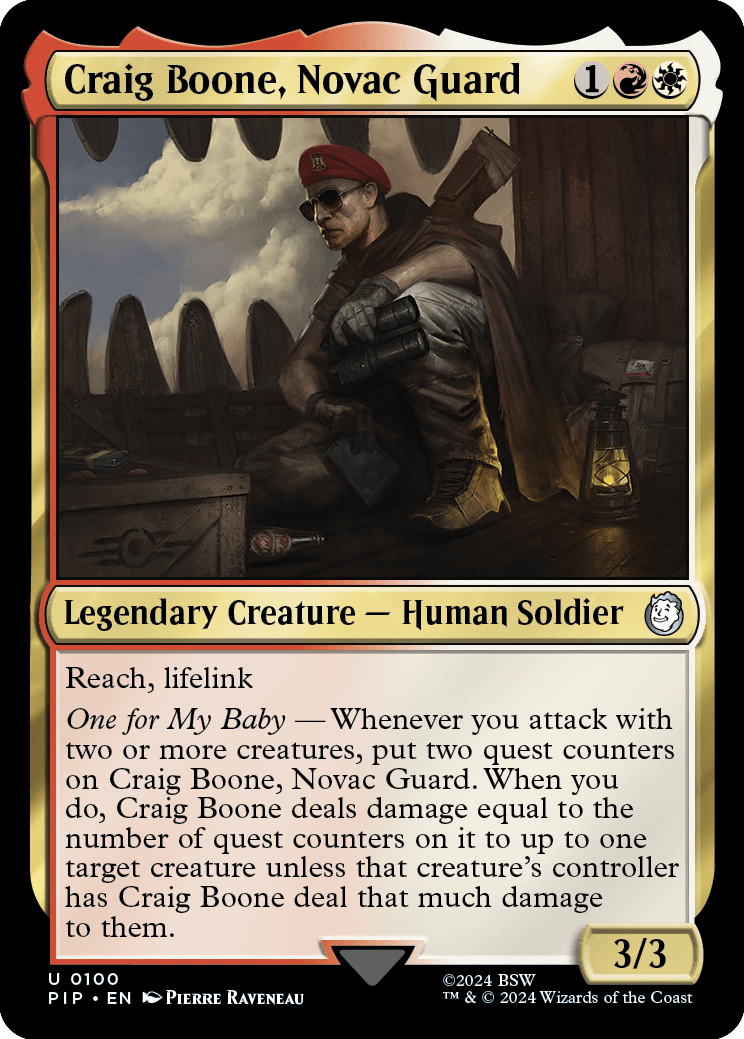
Craig Boone, Novac Guard
{1}{R}{W}
Legendary Creature — Human Soldier
3/3
Reach, lifelink
One for My Baby — Whenever you attack with two or more creatures, put two quest counters on Craig Boone, Novac Guard. When you do, Craig Boone deals damage equal to the number of quest counters on it to up to one target creature unless that creature's controller has Craig Boone deal that much damage to them.
- You don't choose a target for Craig Boone's last ability at the time it triggers. Rather, a second "reflexive" ability triggers when you put two quest counters on Craig Boone this way. You choose up to one target for that ability as it goes on the stack. Each player may respond to this triggered ability as normal.
- If Craig Boone is no longer on the battlefield when the reflexive triggered ability resolves, use the number of quest counters that were on it when it was last on the battlefield to determine how much damage it deals.
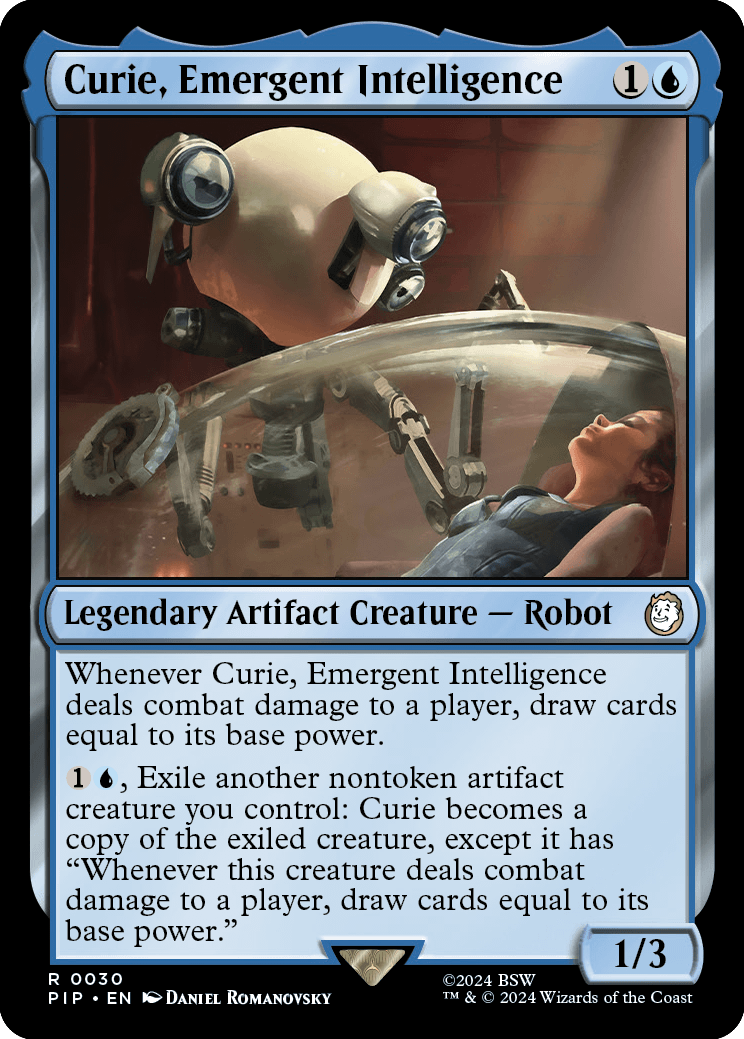
Curie, Emergent Intelligence
{1}{U}
Legendary Artifact Creature — Robot
1/3
Whenever Curie, Emergent Intelligence deals combat damage to a player, draw cards equal to its base power.
{1}{U}, Exile another nontoken artifact creature you control: Curie becomes a copy of the exiled creature, except it has "Whenever this creature deals combat damage to a player, draw cards equal to its base power."
- Normally, a creature's base power is the power printed on the card, or, for a token, the power set by the effect that created it. If another effect sets a creature's power to a specific number or value, that becomes its base power. If an effect modifies a creature's power without setting it, that is not included when determining its base power.
- If a creature has a characteristic-defining ability that sets its power, indicated with a * or similar in the power and toughness box, that ability is taken into account when determining its base power.
- If Curie is no longer on the battlefield when its first ability resolves, use its base power as it last existed on the battlefield to determine how many cards to draw.
- Curie's last ability refers to the exiled creature, not the exiled card. In most cases, this means Curie copies exactly what was printed on the original creature and nothing else, plus the additional ability. However, if the exiled creature was copying something else when it was last on the battlefield, Curie copies whatever that creature was copying, plus the additional ability.
- Curie's last ability won't copy whether the exiled creature was tapped or untapped, whether it had any counters on it or Auras attached to it, or any non-copy effects that changed its power, toughness, types, color, and so on.
- If the copied creature has {X} in its mana cost, X is 0.
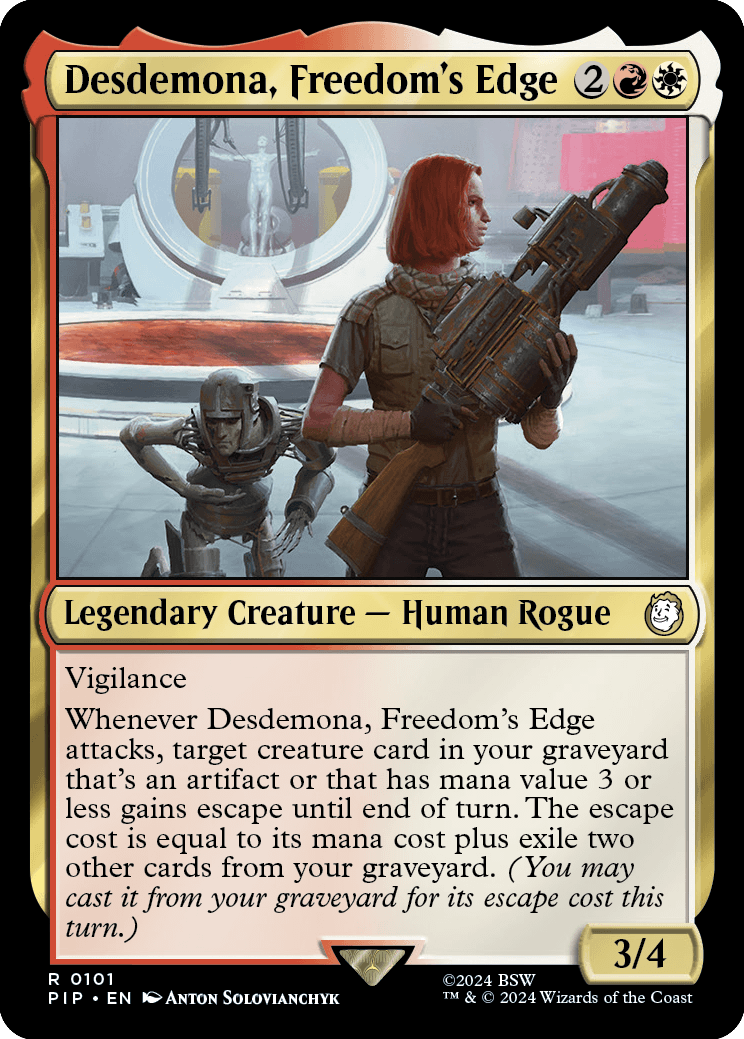
Desdemona, Freedom's Edge
{2}{R}{W}
Legendary Creature — Human Rogue
3/4
Vigilance
Whenever Desdemona, Freedom's Edge attacks, target creature card in your graveyard that's an artifact or that has mana value 3 or less gains escape until end of turn. The escape cost is equal to its mana cost plus exile two other cards from your graveyard. (You may cast it from your graveyard for its escape cost this turn.)
- If a spell you're casting with escape has an additional cost of discarding cards or sacrificing permanents, you may exile cards discarded or sacrificed this way to pay that part of its escape cost.
- Escape's permission doesn't change when you may cast the spell from your graveyard.
- To determine the total cost of a spell, start with the mana cost or alternative cost you're paying (such as an escape cost), add any cost increases, then apply any cost reductions. The mana value of the spell remains unchanged, no matter what the total cost to cast it was and no matter whether an alternative cost was paid.
- After an escaped permanent spell resolves, it enters the battlefield and will return to its owner's graveyard if it dies later.
- If a card has multiple abilities giving you permission to cast it, such as two escape abilities or an escape ability and a flashback ability, you choose which one to apply. The others have no effect.
- If you cast a spell with its escape permission, you can't choose to apply any other alternative costs or to cast it without paying its mana cost. You may pay any optional additional costs the spell has, such as kicker costs. If it has any mandatory additional costs, you must pay those.
- Once you begin casting a spell with escape, it immediately moves to the stack. Players can't take any other actions until you're done casting the spell.
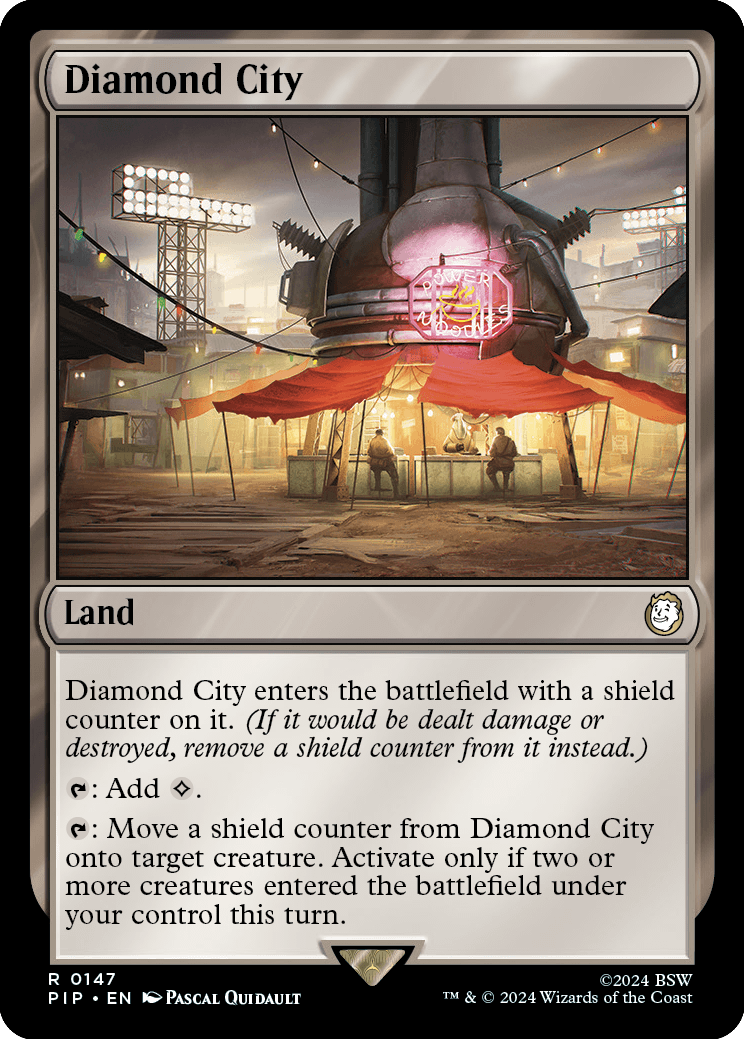
Diamond City
Land
Diamond City enters the battlefield with a shield counter on it. (If it would be dealt damage or destroyed, remove a shield counter from it instead.)
{T}: Add {C}.
{T}: Move a shield counter from Diamond City onto target creature. Activate only if two or more creatures entered the battlefield under your control this turn.
- Shield counters don't prevent players from sacrificing permanents.
- Removing a shield counter when a permanent would be dealt damage or destroyed isn't the same as regenerating a permanent.
- If a permanent that would be dealt damage has more than one shield counter on it, that damage is prevented and only one shield counter is removed.
- If a permanent with a shield counter is dealt unpreventable damage, that damage will be dealt and a shield counter will still be removed.
- A creature with a shield counter on it may still be destroyed by state-based actions if it has damage marked on it equal to its toughness or has been dealt unpreventable damage by a source with deathtouch.
- "Shield" is not an ability that permanents have and shield counters are not keyword counters. If a permanent with a shield counter loses its abilities, the shield counter will still protect it as normal.
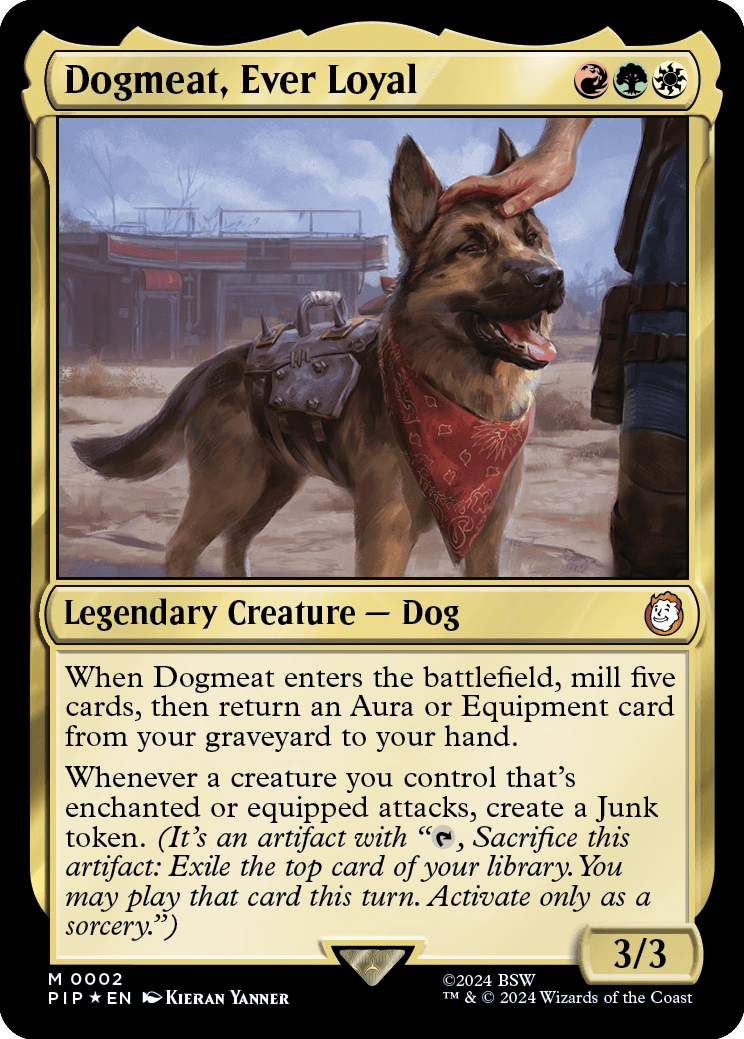
Dogmeat, Ever Loyal
{R}{G}{W}
Legendary Creature — Dog
3/3
When Dogmeat enters the battlefield, mill five cards, then return an Aura or Equipment card from your graveyard to your hand.
Whenever a creature you control that's enchanted or equipped attacks, create a Junk token. (It's an artifact with "{T}, Sacrifice this artifact: Exile the top card of your library. You may play that card this turn. Activate only as a sorcery.")
- The card you return with Dogmeat's first ability doesn't have to be one of the cards you milled with that ability.
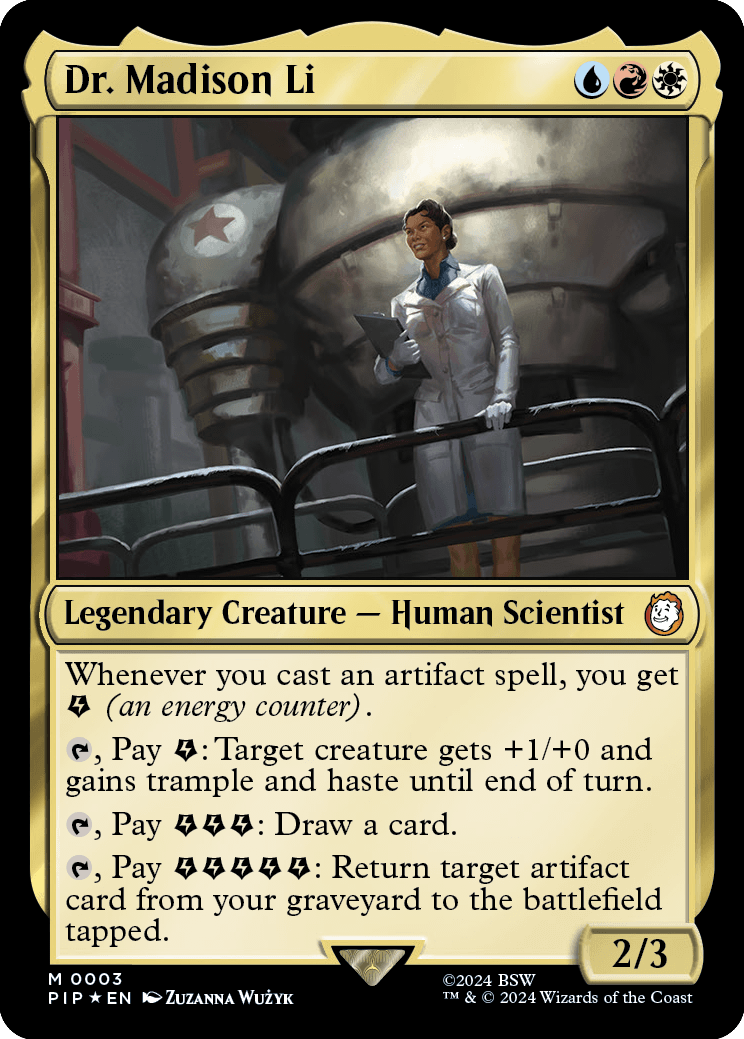
Dr. Madison Li
{U}{R}{W}
Legendary Creature — Human Scientist
2/3
Whenever you cast an artifact spell, you get {E} (an energy counter).
{T}, Pay {E}: Target creature gets +1/+0 and gains trample and haste until end of turn.
{T}, Pay {E}{E}{E}: Draw a card.
{T}, Pay {E}{E}{E}{E}{E}: Return target artifact card from your graveyard to the battlefield tapped.
- Dr. Madison Li's first ability resolves before the spell that caused it to trigger.

ED-E, Lonesome Eyebot
{3}
Legendary Artifact Creature — Robot
2/1
Flying
ED-E My Love — Whenever you attack, if the number of attacking creatures is greater than the number of quest counters on ED-E, Lonesome Eyebot, put a quest counter on it.
{2}, Sacrifice ED-E: Draw a card, then draw an additional card for each quest counter on ED-E.
- If the number of attacking creatures isn't greater than the number of quest counters on ED-E when you attack, its second ability won't trigger at all. When the ability tries to resolve, if the number of attacking creatures is no longer greater than the number of quest counters on ED-E, it won't resolve, and you won't put a quest counter on ED-E.
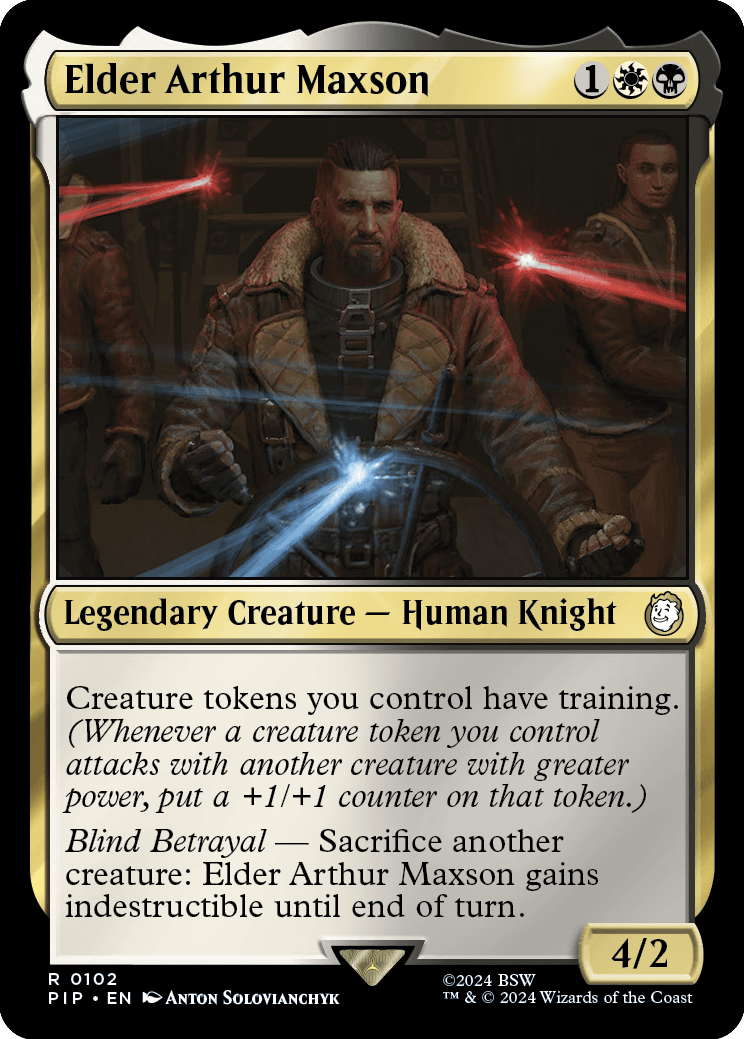
Elder Arthur Maxson
{1}{W}{B}
Legendary Creature — Human Knight
4/2
Creature tokens you control have training. (Whenever a creature token you control attacks with another creature with greater power, put a +1/+1 counter on that token.)
Blind Betrayal — Sacrifice another creature: Elder Arthur Maxson gains indestructible until end of turn.
- A creature's training ability triggers only when both that creature and a creature with greater power are declared as attackers. Increasing a creature's power after attackers are declared won't cause a training ability to trigger.
- Once a creature's training ability has triggered, destroying the other attacking creature or reducing its power won't stop the creature with training from getting a +1/+1 counter.
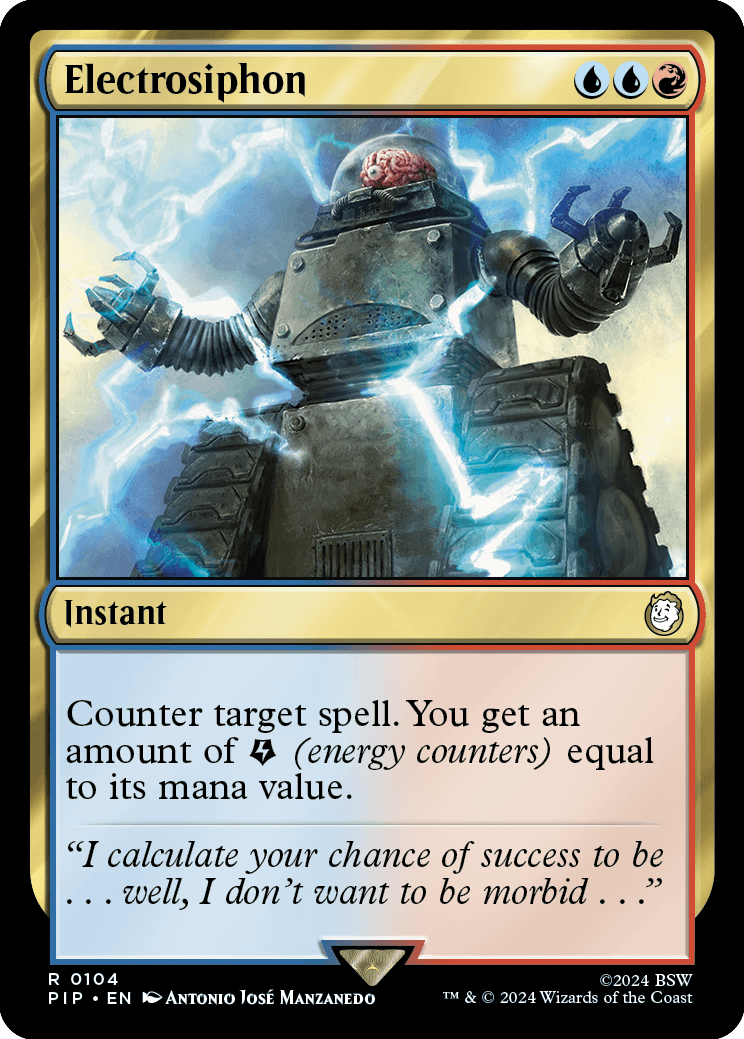
Electrosiphon
{U}{U}{R}
Instant
Counter target spell. You get an amount of {E} (energy counters) equal to its mana value.
- For spells with {X} in their mana costs, use the value chosen for X to determine the spell's mana value.

Endurance Bobblehead
{3}
Artifact — Bobblehead
{T}: Add one mana of any color.
{3}, {T}: Up to X target creatures you control get +1/+0 and gain indestructible until end of turn, where X is the number of Bobbleheads you control as you activate this ability. Activate only as a sorcery.
- You choose how many targets Endurance Bobblehead's last ability has as you activate the ability. Once you do, it doesn't matter what happens to any Bobbleheads you control.
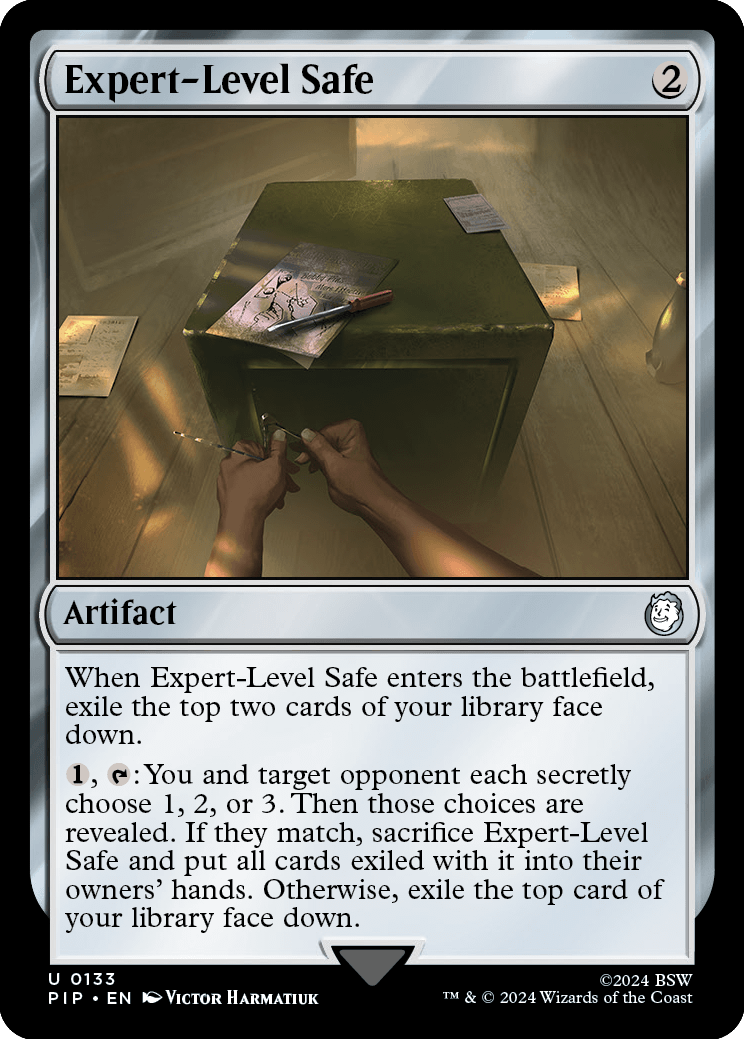
Expert-Level Safe
{2}
Artifact
When Expert-Level Safe enters the battlefield, exile the top two cards of your library face down.
{1}, {T}: You and target opponent each secretly choose 1, 2, or 3. Then those choices are revealed. If they match, sacrifice Expert-Level Safe and put all cards exiled with it into their owners' hands. Otherwise, exile the top card of your library face down.
- You don't get to look at the cards exiled by Expert-Level Safe's abilities.
- To secretly choose the numbers, you and the target opponent should each write down your choice of 1, 2, or 3 without showing them to anyone else. Keep those choices secret until they're simultaneously revealed.

Feral Ghoul
{2}{B}
Creature — Zombie Mutant
2/2
Menace
Whenever another creature you control dies, put a +1/+1 counter on Feral Ghoul.
When Feral Ghoul dies, each opponent gets a number of rad counters equal to its power.
- Use Feral Ghoul's power as it last existed on the battlefield to determine how many rad counters each opponent gets.
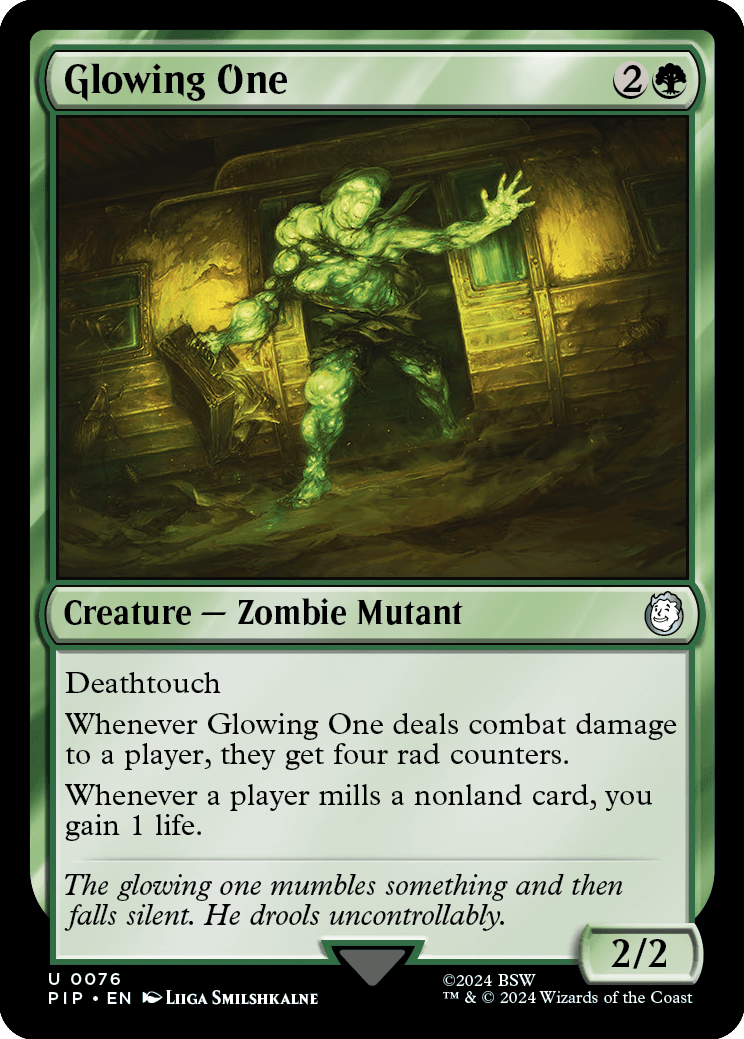
Glowing One
{2}{G}
Creature — Zombie Mutant
2/2
Deathtouch
Whenever Glowing One deals combat damage to a player, they get four rad counters.
Whenever a player mills a nonland card, you gain 1 life.
- If a player is instructed to mill more than one card, Glowing One's last ability will trigger once for each nonland card they mill during that instruction. For example, a player with four rad counters will mill four cards at the beginning of their precombat main phase. If all four of those cards are nonland cards, Glowing One's ability triggers four times.
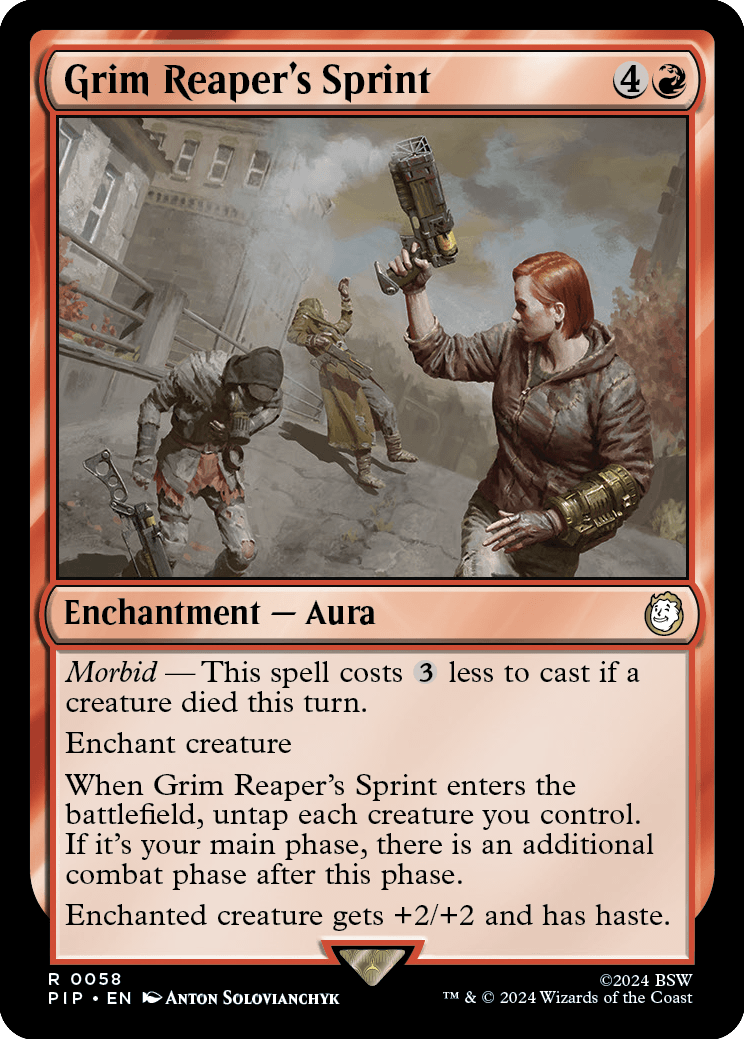
Grim Reaper's Sprint
{4}{R}
Enchantment — Aura
Morbid — This spell costs {3} less to cast if a creature died this turn.
Enchant creature
When Grim Reaper's Sprint enters the battlefield, untap each creature you control. If it's your main phase, there is an additional combat phase after this phase.
Enchanted creature gets +2/+2 and has haste.
- If the creature Grim Reaper's Sprint would enchant is an illegal target by the time Grim Reaper's Sprint would resolve, the entire spell doesn't resolve. It's put into the graveyard from the stack, so its triggered ability won't trigger, and you won't untap your creatures or get an additional combat phase.
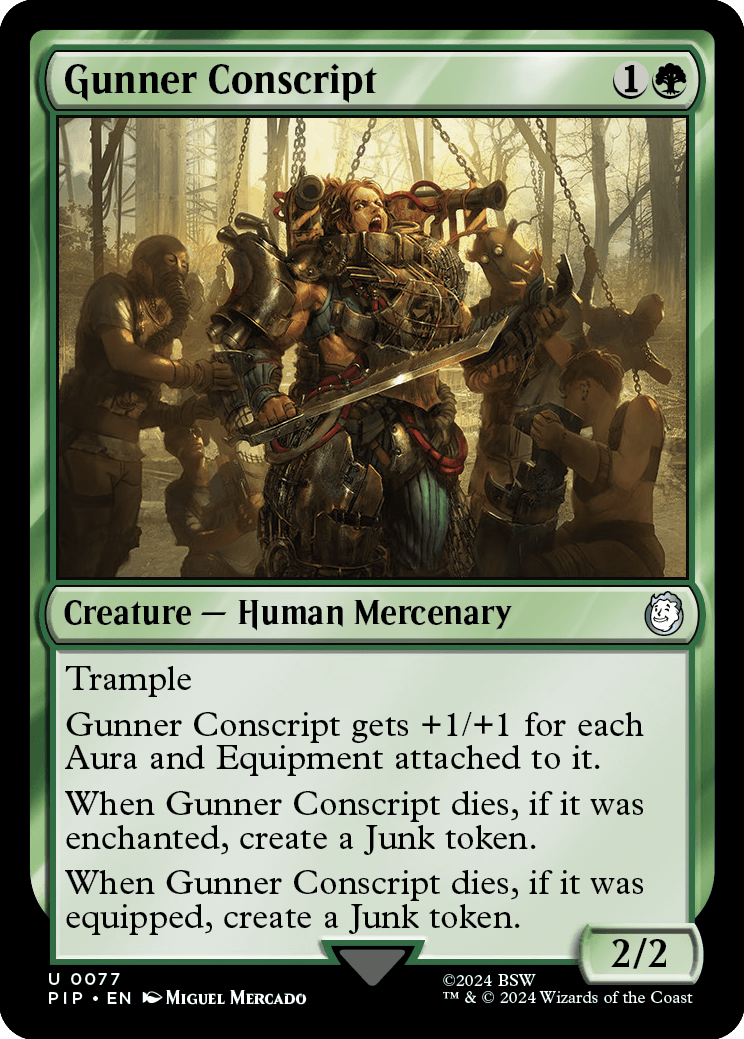
Gunner Conscript
{1}{G}
Creature — Human Mercenary
2/2
Trample
Gunner Conscript gets +1/+1 for each Aura and Equipment attached to it.
When Gunner Conscript dies, if it was enchanted, create a Junk token.
When Gunner Conscript dies, if it was equipped, create a Junk token.
- Because damage remains marked on a creature until the damage is removed as the turn ends, nonlethal damage dealt to Gunner Conscript may become lethal if an Aura or Equipment attached to it leaves the battlefield or becomes unattached from Gunner Conscript during that turn.
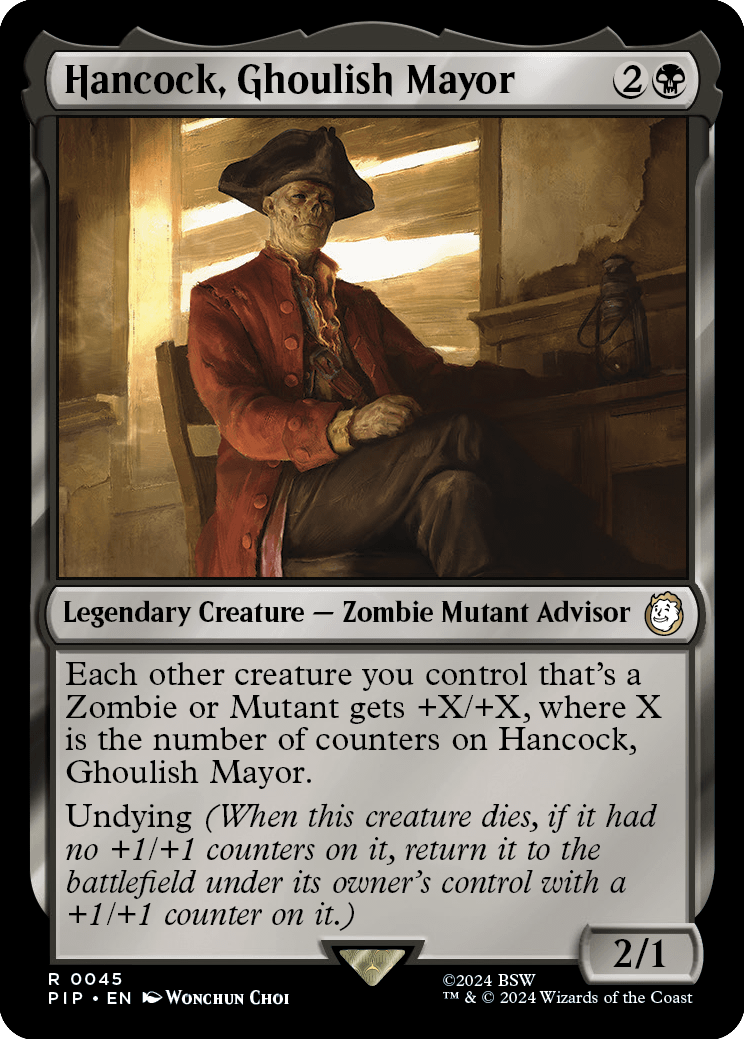
Hancock, Ghoulish Mayor
{2}{B}
Legendary Creature — Zombie Mutant Advisor
2/1
Each other creature you control that's a Zombie or Mutant gets +X/+X, where X is the number of counters on Hancock, Ghoulish Mayor.
Undying (When this creature dies, if it had no +1/+1 counters on it, return it to the battlefield under its owner's control with a +1/+1 counter on it.)
- A creature that's both a Zombie and a Mutant will get +X/+X only once from Hancock's first ability.

Harold and Bob, First Numens
{2}{G}
Legendary Creature — Treefolk Mutant
3/3
Vigilance, reach
When Harold and Bob, First Numens dies, if it was a creature, return it to the battlefield. It's an Aura enchantment with enchant Forest you control and "Enchanted Forest has '{T}: Add three mana of any one color. You get two rad counters.'" Harold and Bob loses all other abilities.
- If you control Harold and Bob, you'll return it to the battlefield when it dies while it's a creature. It doesn't matter who owns the card. You'll choose which Forest you control it will enchant as it returns to the battlefield.
- If there's nothing for Harold and Bob to legally enchant, it remains in its owner's graveyard instead of returning to the battlefield.
- A token that's a copy of Harold and Bob won't return to the battlefield from its owner's graveyard.
- If a nontoken permanent that's a copy of Harold and Bob dies while it's a creature, it will return to the battlefield as an Aura with only the abilities granted by the effect that returned it to the battlefield. It will also retain its name, colors, and supertypes, but it will be an Aura enchantment with no other types or subtypes.

HELIOS One
Land
{T}: Add {C}.
{1}, {T}: You get {E} (an energy counter).
{3}, {T}, Pay X {E}, Sacrifice HELIOS One: Destroy target nonland permanent with mana value X. Activate only as a sorcery.
- If a permanent has {X} in its mana cost, X is 0 when determining its mana value.
- A token that's not a copy of something else normally won't have a mana cost. Anything without a mana cost normally has a mana value of 0.
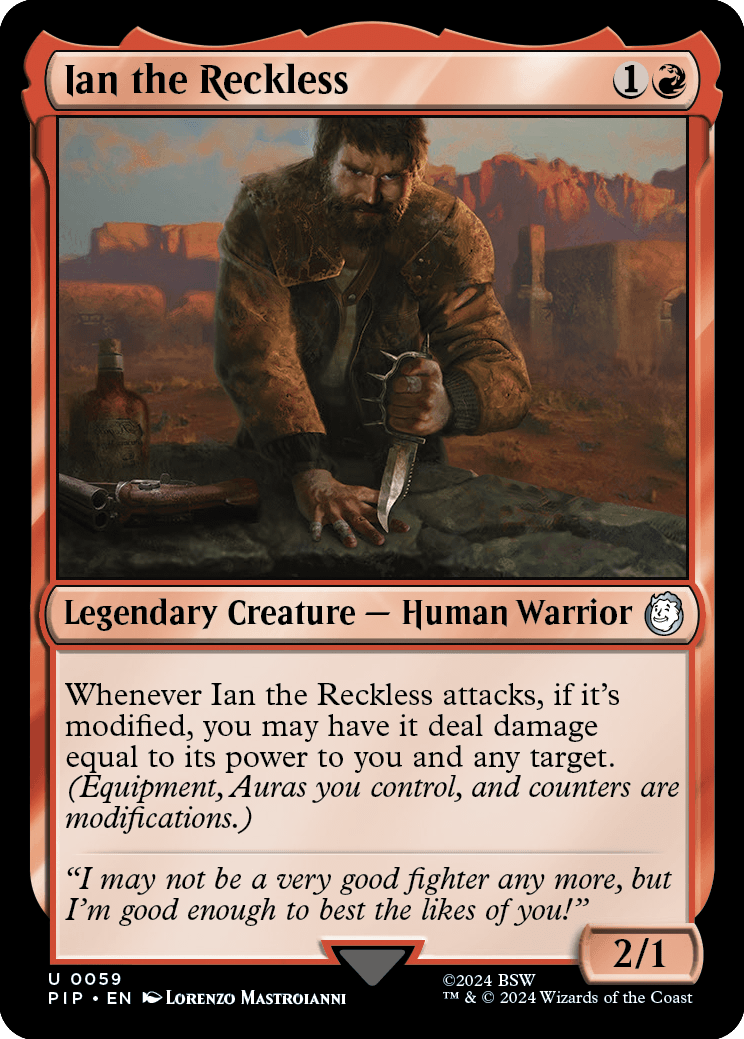
Ian the Reckless
{1}{R}
Legendary Creature — Human Warrior
2/1
Whenever Ian the Reckless attacks, if it's modified, you may have it deal damage equal to its power to you and any target. (Equipment, Auras you control, and counters are modifications.)
- If Ian the Reckless isn't modified when it attacks, its ability won't trigger at all. When its ability tries to resolve, if it isn't modified at that time, the ability won't resolve.
- If Ian the Reckless leaves the battlefield before its last ability resolves, as long as it was modified when it was last on the battlefield, use its power as it last existed on the battlefield to determine how much damage that ability deals.

Idolized
{1}{W}
Enchantment — Aura
Enchant creature
Enchanted creature has "Whenever this creature attacks alone, it gets +X/+X until end of turn, where X is the number of nonland permanents you control."
- A creature attacks alone if it's the only creature declared as an attacker during the declare attackers step (including creatures controlled by your teammates, if applicable). For example, the ability granted by Idolized won't trigger if you attack with multiple creatures and all but one of them are removed from combat. Similarly, creatures that enter the battlefield attacking later in combat won't be considered when determining whether or not a creature attacked alone.
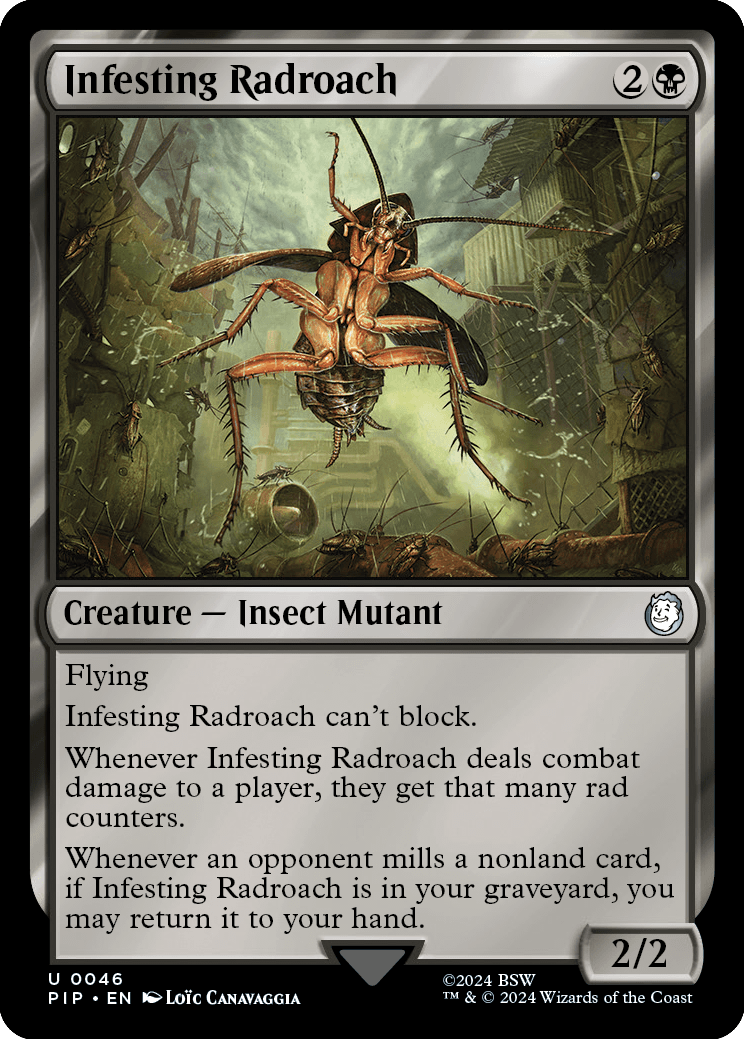
Infesting Radroach
{2}{B}
Creature — Insect Mutant
2/2
Flying
Infesting Radroach can't block.
Whenever Infesting Radroach deals combat damage to a player, they get that many rad counters.
Whenever an opponent mills a nonland card, if Infesting Radroach is in your graveyard, you may return it to your hand.
- If Infesting Radroach is milled at the same time an opponent mills a nonland card (for example, because of the activated ability of Raul, Trouble Shooter), Infesting Radroach's ability will trigger.
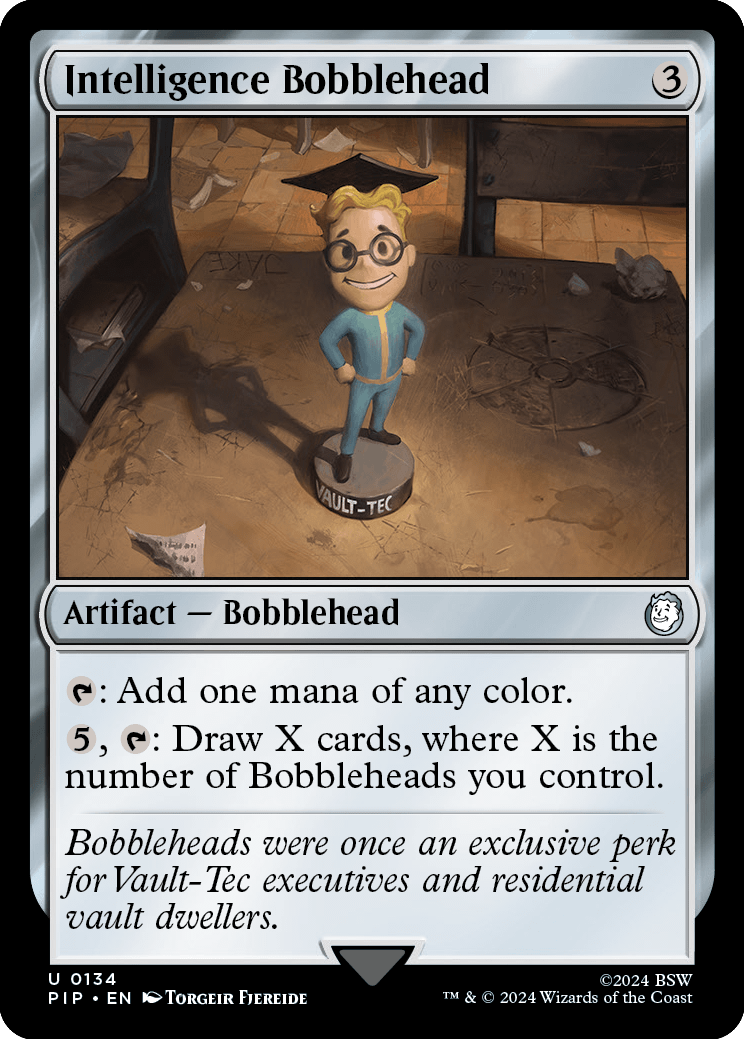
Intelligence Bobblehead
{3}
Artifact — Bobblehead
{T}: Add one mana of any color.
{5}, {T}: Draw X cards, where X is the number of Bobbleheads you control.
- The value of X is determined only once, as Intelligence Bobblehead's last ability resolves.
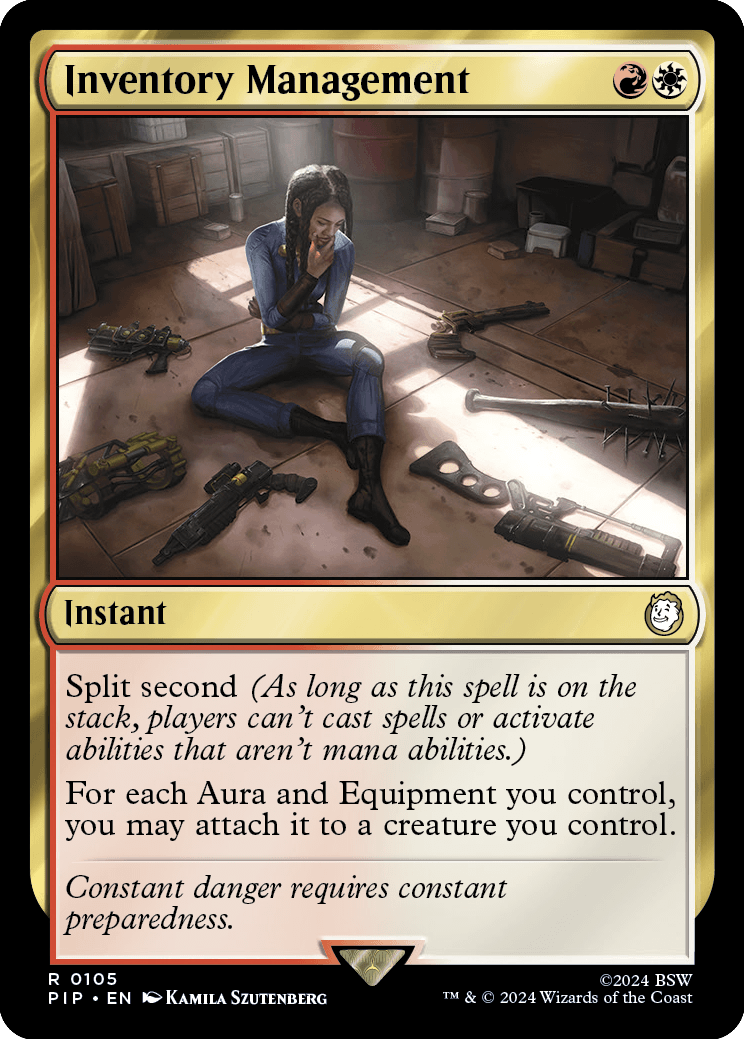
Inventory Management
{R}{W}
Instant
Split second (As long as this spell is on the stack, players can't cast spells or activate abilities that aren't mana abilities.)
For each Aura and Equipment you control, you may attach it to a creature you control.
- Players still get priority while a spell with split second is on the stack; their options are just limited to mana abilities and certain special actions.
- Players may turn face-down creatures face up while a spell with split second is on the stack.
- Split second doesn't stop triggered abilities from triggering. If one does, its controller puts it on the stack and chooses targets for it, if any. Those abilities will resolve as normal.
- Casting a spell with split second won't affect spells and abilities that are already on the stack.
- If the resolution of a triggered ability involves casting a spell, that spell can't be cast if a spell with split second is on the stack.
- After a spell with split second resolves (or otherwise leaves the stack), players may again cast spells and activate abilities before the next object on the stack resolves.
- You can't try to attach an Aura or Equipment to a creature if that Aura or Equipment can't legally be attached to it.
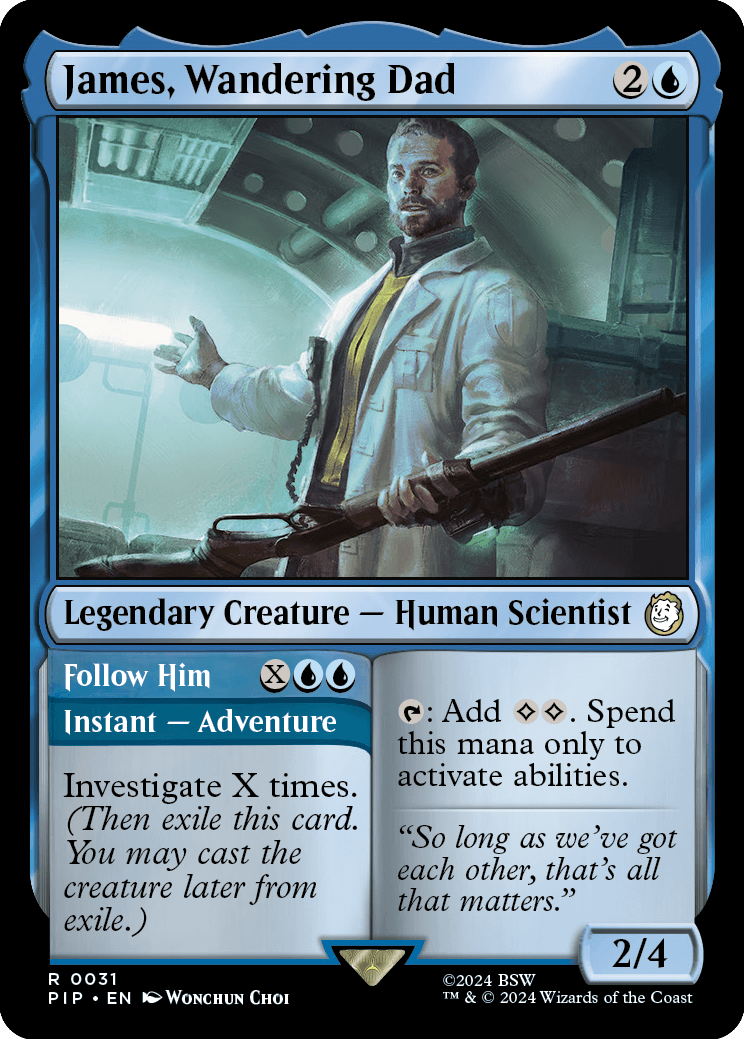
James, Wandering Dad
{2}{U}
Legendary Creature — Human Scientist
2/4
{T}: Add {C}{C}. Spend this mana only to activate abilities.
//
Follow Him
{X}{U}{U}
Instant — Adventure
Investigate X times. (Then exile this card. You may cast the creature later from exile.)
- Activated abilities contain a colon. They're generally written "[Cost]: [Effect]." Some keywords are activated abilities and may have colons in their reminder text.
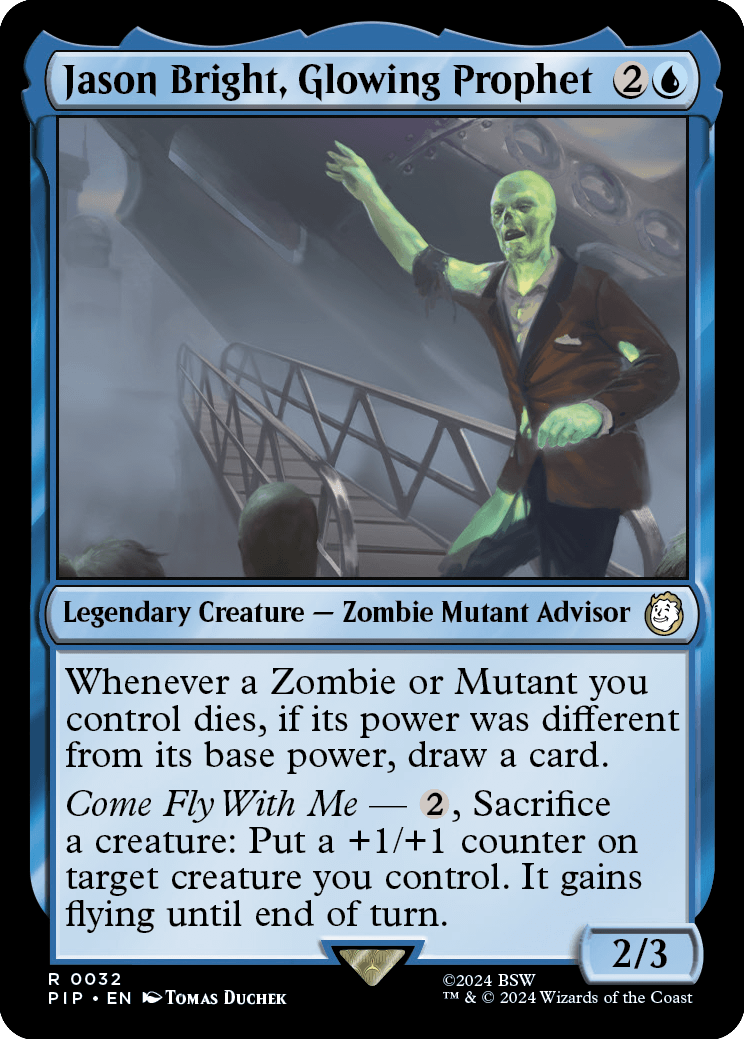
Jason Bright, Glowing Prophet
{2}{U}
Legendary Creature — Zombie Mutant Advisor
2/3
Whenever a Zombie or Mutant you control dies, if its power was different from its base power, draw a card.
Come Fly With Me — {2}, Sacrifice a creature: Put a +1/+1 counter on target creature you control. It gains flying until end of turn.
- Normally, a creature's base power is the power printed on the card, or, for a token, the power set by the effect that created it. If another effect sets a creature's power to a specific number or value, that becomes its base power. If an effect modifies a creature's power without setting it, that is not included when determining its base power.
- If a creature has a characteristic-defining ability that sets its power, indicated with a * or similar in the power and toughness box, that ability is taken into account when determining its base power.
- Some creatures have base power 0 and an ability that gives them a bonus based on some criteria. Those are not characteristic-defining abilities, and that ability doesn't change its base power. Such a creature will have power different from its base power if that ability causes its power to be anything other than 0.

Junk Jet
{1}{R}
Artifact — Equipment
When Junk Jet enters the battlefield, create a Junk token. (It's an artifact with "{T}, Sacrifice this artifact: Exile the top card of your library. You may play that card this turn. Activate only as a sorcery.")
{3}, Sacrifice another artifact: Double equipped creature's power until end of turn.
Equip {1}
- If an effect instructs you to "double" a creature's power, that creature gets +X/+0, where X is its power as that effect begins to apply.
- If a creature's power is less than 0 when it's doubled, instead that creature gets -X/-0, where X is how much less than 0 its power is. For example, suppose you control Infesting Radroach, a 2/2 creature. If an effect has given Infesting Radroach -4/-0 so that it's a -2/2 creature, doubling its power gives it -2/-0, and it becomes a -4/2 creature.
- If you "double" a creature's power more than once in a turn, each doubling effect applies independently. For example, suppose Junk Jet is attached to Infesting Radroach, a 2/2 creature. If you activate Junk Jet's second ability, Infesting Radroach will get +2/+0 when that ability resolves, making it a 4/2 creature. Doubling its power again will give it +4/+0, making it an 8/2 creature.
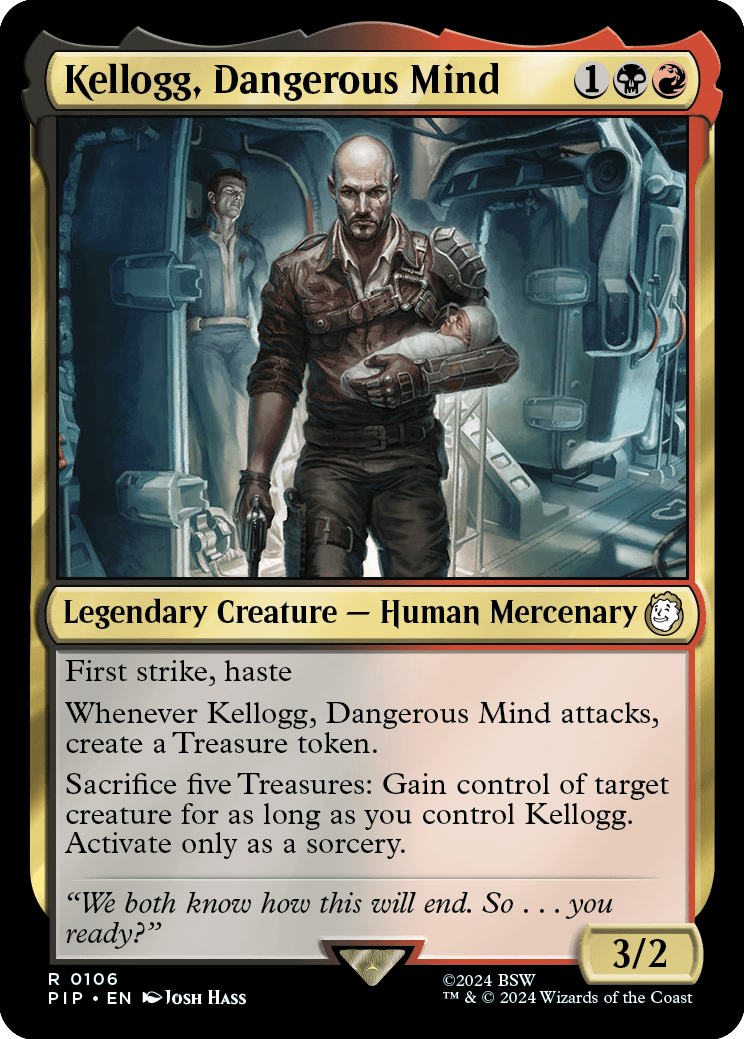
Kellogg, Dangerous Mind
{1}{B}{R}
Legendary Creature — Human Mercenary
3/2
First strike, haste
Whenever Kellogg, Dangerous Mind attacks, create a Treasure token.
Sacrifice five Treasures: Gain control of target creature for as long as you control Kellogg. Activate only as a sorcery.
- If you lose control of Kellogg before its last ability resolves, you won't gain control of the target creature at all.
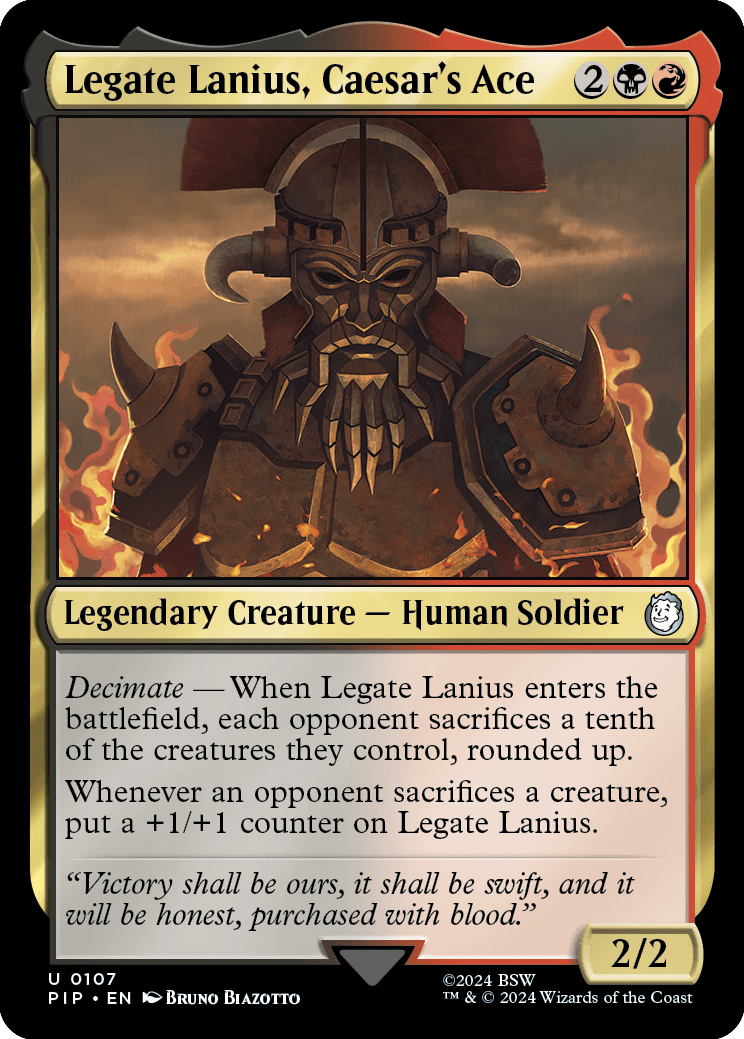
Legate Lanius, Caesar's Ace
{2}{B}{R}
Legendary Creature — Human Soldier
2/2
Decimate — When Legate Lanius enters the battlefield, each opponent sacrifices a tenth of the creatures they control, rounded up.
Whenever an opponent sacrifices a creature, put a +1/+1 counter on Legate Lanius.
- For example, when Legate Lanius's first ability resolves, an opponent who controls between one and ten creatures will sacrifice one creature. An opponent who controls between eleven and twenty creatures will sacrifice two creatures, and so on.
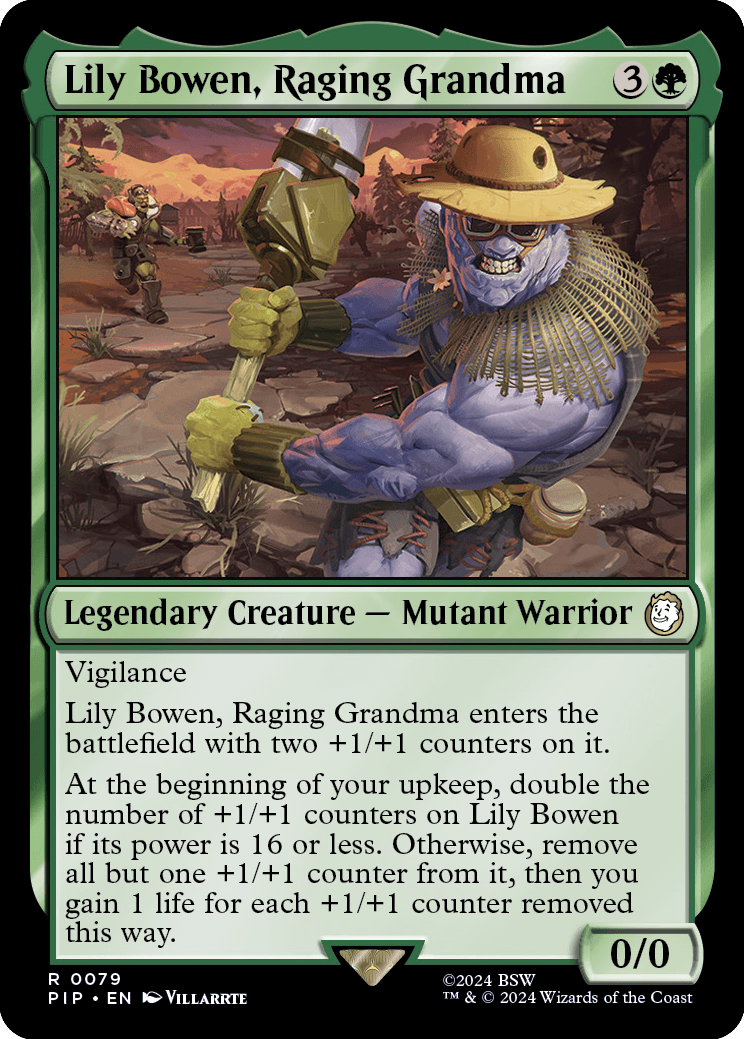
Lily Bowen, Raging Grandma
{3}{G}
Legendary Creature — Mutant Warrior
0/0
Vigilance
Lily Bowen, Raging Grandma enters the battlefield with two +1/+1 counters on it.
At the beginning of your upkeep, double the number of +1/+1 counters on Lily Bowen if its power is 16 or less. Otherwise, remove all but one +1/+1 counter from it, then you gain 1 life for each +1/+1 counter removed this way.
- To double the number of +1/+1 counters on Lily Bowen, put a number of +1/+1 counters on it equal to the number it already has. Replacement effects that modify the number of counters being placed on creatures you control, such as the effect of Branching Evolution, apply to this ability as normal.
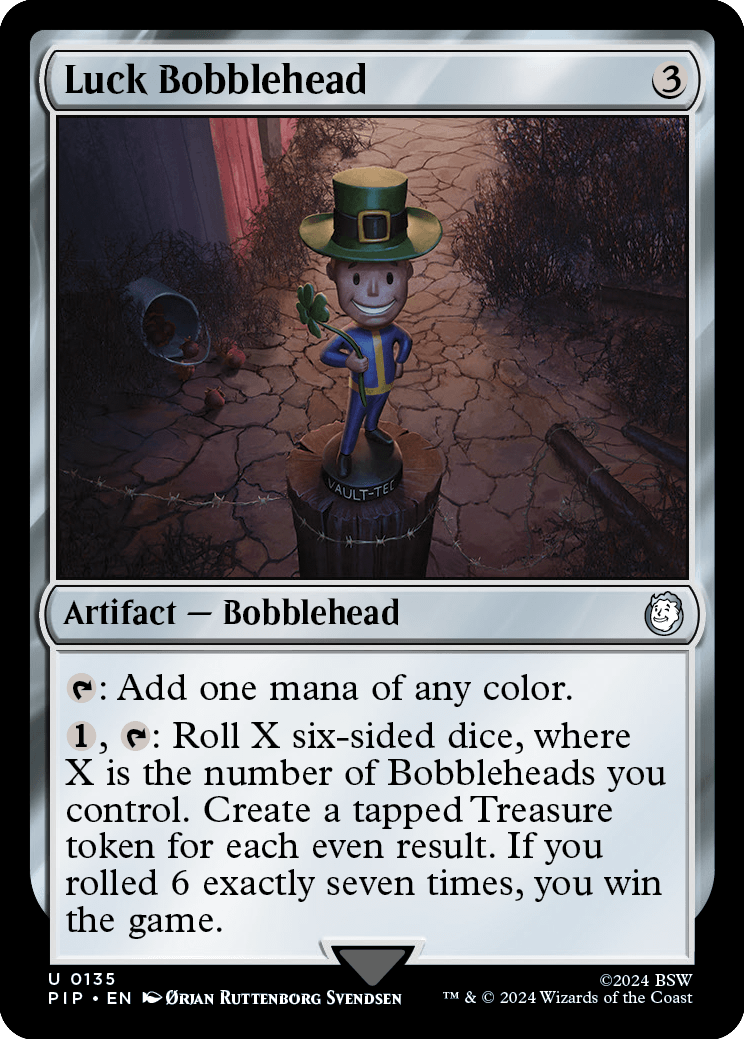
Luck Bobblehead
{3}
Artifact — Bobblehead
{T}: Add one mana of any color.
{1}, {T}: Roll X six-sided dice, where X is the number of Bobbleheads you control. Create a tapped Treasure token for each even result. If you rolled 6 exactly seven times, you win the game.
- The value of X is determined only once, as Luck Bobblehead's last ability resolves.
- If X is a very large number, you may be required to roll more dice than you physically can in a reasonable time frame. In such cases, we encourage you to use digital resources for simulating die rolls or generating random numbers.
- You win the game only if you rolled 6 exactly seven times while resolving a single instance of Luck Bobblehead's last ability. Results of previous die rolls, whether they're from previous resolutions of Luck Bobblehead's last ability or from other effects that instruct you to roll dice, don't matter for the purposes of this effect.
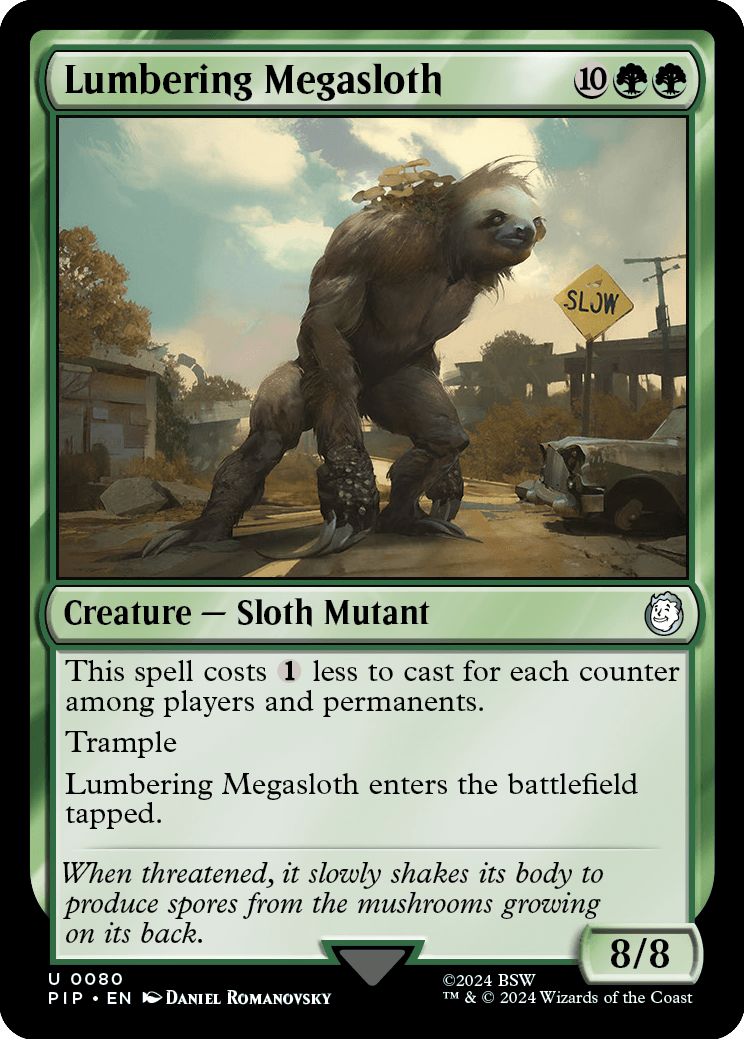
Lumbering Megasloth
{10}{G}{G}
Creature — Sloth Mutant
8/8
This spell costs {1} less to cast for each counter among players and permanents.
Trample
Lumbering Megasloth enters the battlefield tapped.
- The cost-reduction ability of Lumbering Megasloth doesn't change its mana cost or mana value, only the total cost you pay. Specifically, the mana value of Lumbering Megasloth is always 12.
- Once you announce that you're casting Lumbering Megasloth, no player may take actions until you're done casting it. Notably, opponents can't remove counters from players or permanents to try to change Lumbering Megasloth's total cost.
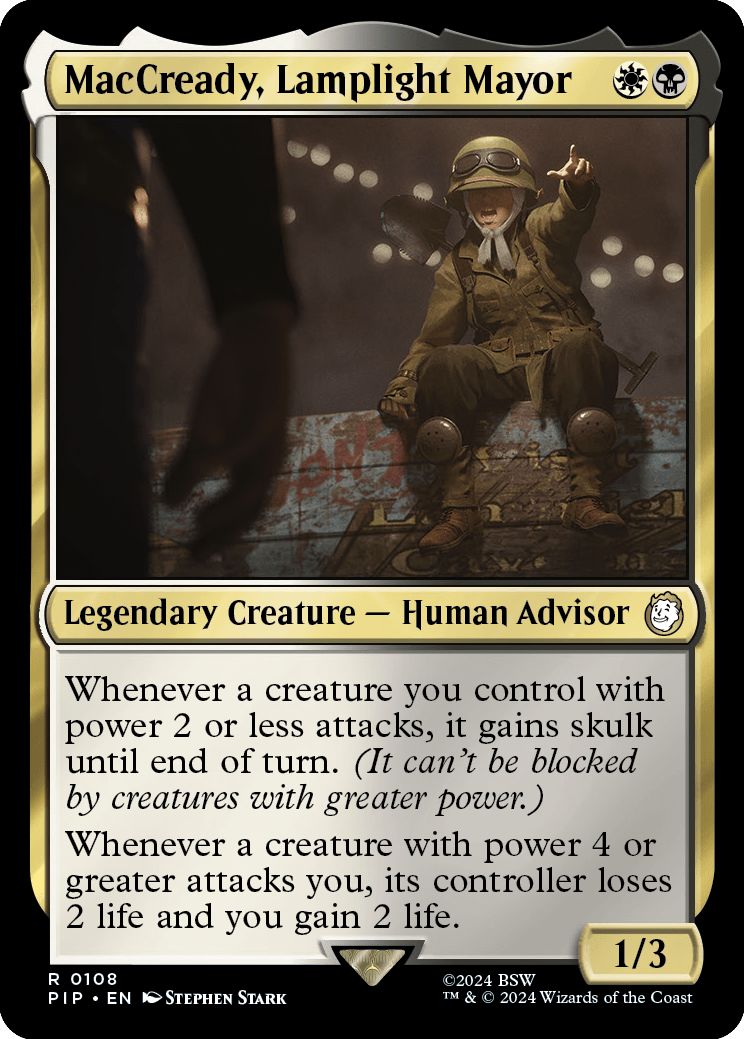
MacCready, Lamplight Mayor
{W}{B}
Legendary Creature — Human Advisor
1/3
Whenever a creature you control with power 2 or less attacks, it gains skulk until end of turn. (It can't be blocked by creatures with greater power.)
Whenever a creature with power 4 or greater attacks you, its controller loses 2 life and you gain 2 life.
- The power of your attacking creature is checked only when MacCready's first ability triggers. Once it triggers, the creature will gain skulk until end of turn when the ability resolves, regardless of whether or not its power is still 2 or less at that time.
- Similarly, the power of the creature attacking you is checked only when MacCready's second ability triggers. Once it triggers, the creature's controller will lose 2 life and you'll gain 2 life when the ability resolves, regardless of whether or not its power is still 4 or greater at that time or whether or not it's still on the battlefield.
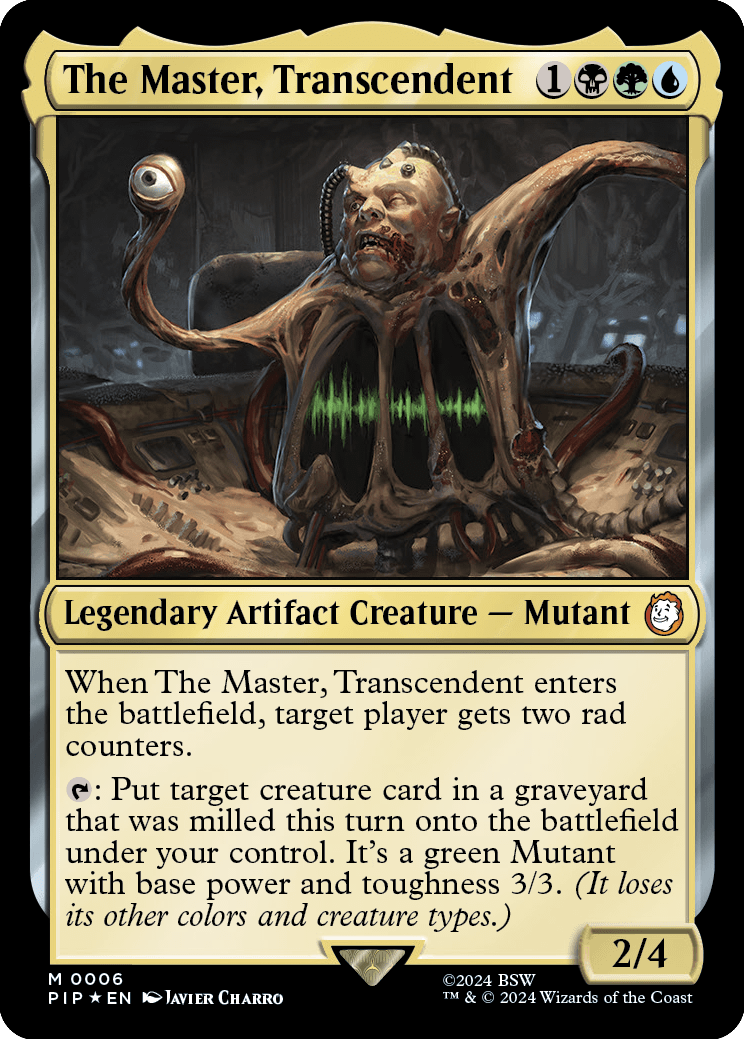
The Master, Transcendent
{1}{B}{G}{U}
Legendary Artifact Creature — Mutant
2/4
When The Master, Transcendent enters the battlefield, target player gets two rad counters.
{T}: Put target creature card in a graveyard that was milled this turn onto the battlefield under your control. It's a green Mutant with base power and toughness 3/3. (It loses its other colors and creature types.)
- If a player is instructed to put a card into their graveyard from their library without using the word "mill," (by the effect of Rowan's Grim Search from Wilds of Eldraine, for example), that card isn't a legal target for The Master's last ability.
- The Master's last ability will override any characteristic-defining abilities the creature has that set its power and/or toughness. For example, if you put a Robobrain War Mind onto the battlefield with The Master's last ability, its base power and toughness will be 3/3, and the number of cards in your hand won't affect its power at all.
- Effects that modify a creature's power and/or toughness will still apply to the creature as normal. The same is true for any counters that change its power and/or toughness.
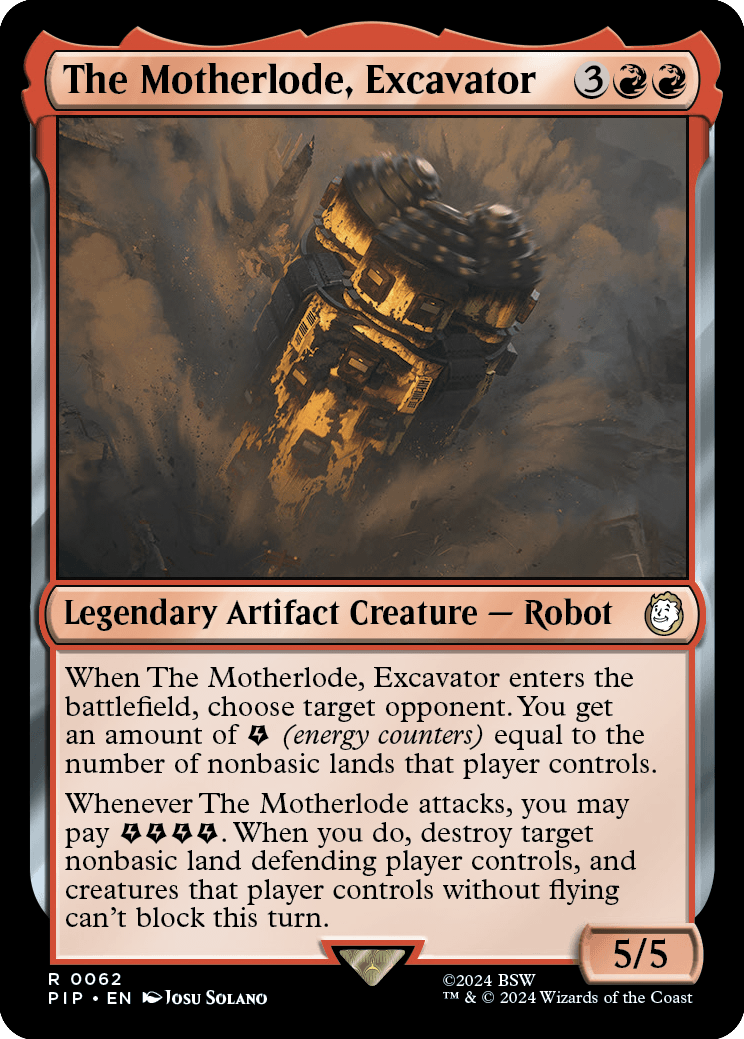
The Motherlode, Excavator
{3}{R}{R}
Legendary Artifact Creature — Robot
5/5
When The Motherlode, Excavator enters the battlefield, choose target opponent. You get an amount of {E} (energy counters) equal to the number of nonbasic lands that player controls.
Whenever The Motherlode attacks, you may pay {E}{E}{E}{E}. When you do, destroy target nonbasic land defending player controls, and creatures that player controls without flying can't block this turn.
- Use the number of nonbasic lands the target opponent controls when The Motherlode's first ability resolves to determine the number of energy counters you get.
- You don't choose a target nonbasic land at the time The Motherlode's last ability triggers. Rather, a second "reflexive" ability triggers when you pay {E}{E}{E}{E} this way. You choose a target for that ability as it goes on the stack. Each player may respond to this triggered ability as normal.
- The Motherlode's reflexive triggered ability prevents all creatures without flying that player controls from blocking that turn, including creatures that lose flying after the ability resolves as well as creatures without flying that enter the battlefield or come under that player's control later in the turn.
- If the target nonbasic land is an illegal target as The Motherlode's reflexive triggered ability tries to resolve, it won't resolve and none of its effects happen. Creatures defending player controls without flying will still be able to block this turn.
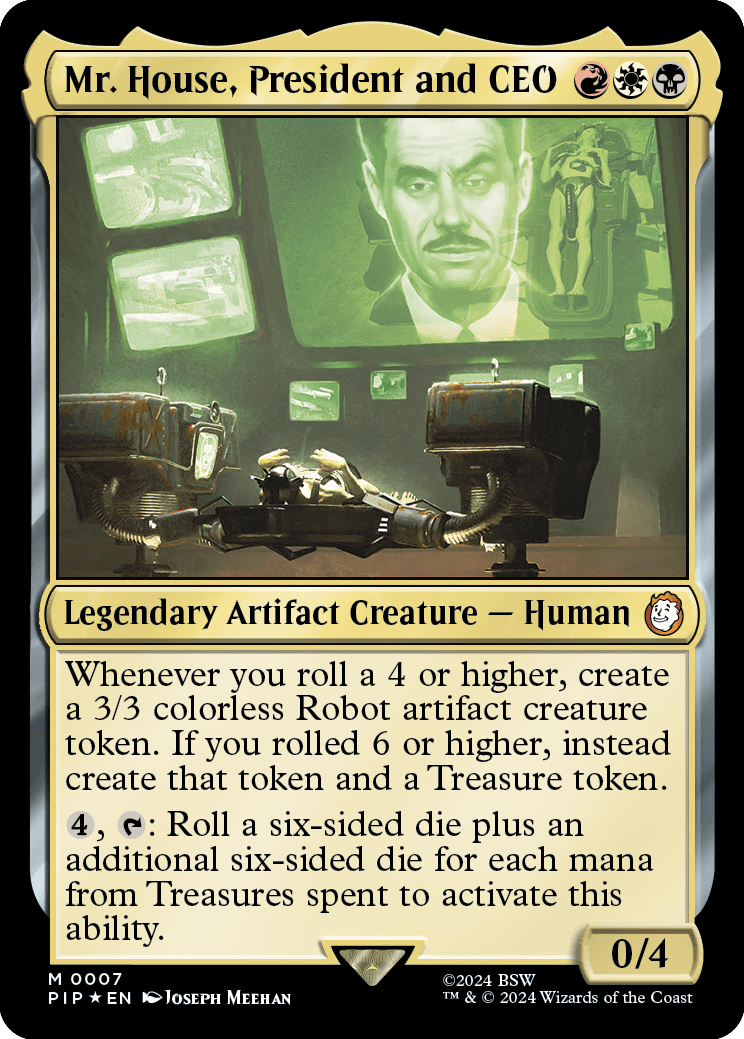
Mr. House, President and CEO
{R}{W}{B}
Legendary Artifact Creature — Human
0/4
Whenever you roll a 4 or higher, create a 3/3 colorless Robot artifact creature token. If you rolled 6 or higher, instead create that token and a Treasure token.
{4}, {T}: Roll a six-sided die plus an additional six-sided die for each mana from Treasures spent to activate this ability.
- Some cards from other releases may instruct you to roll dice other than six-sided dice. Results of 4 or higher on those dice cause Mr. House's first ability to trigger.
- The die rolls caused by Mr. House's last ability have no inherent effect. Abilities that trigger whenever you roll dice or whenever you roll a certain result, such as Mr. House's first ability, will trigger as appropriate.
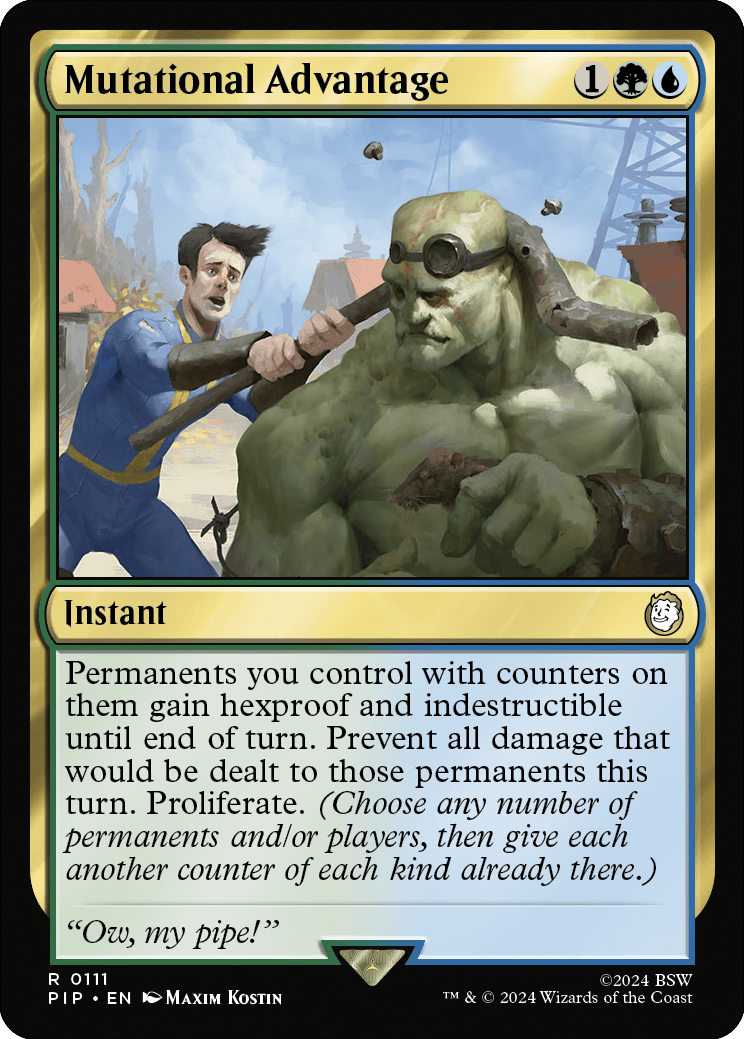
Mutational Advantage
{1}{G}{U}
Instant
Permanents you control with counters on them gain hexproof and indestructible until end of turn. Prevent all damage that would be dealt to those permanents this turn. Proliferate. (Choose any number of permanents and/or players, then give each another counter of each kind already there.)
- The set of permanents affected by Mutational Advantage is determined at the time Mutational Advantage resolves. Permanents that gain counters later in the turn won't become affected by this effect, and permanents that lose all of their counters later in the turn won't stop being affected.
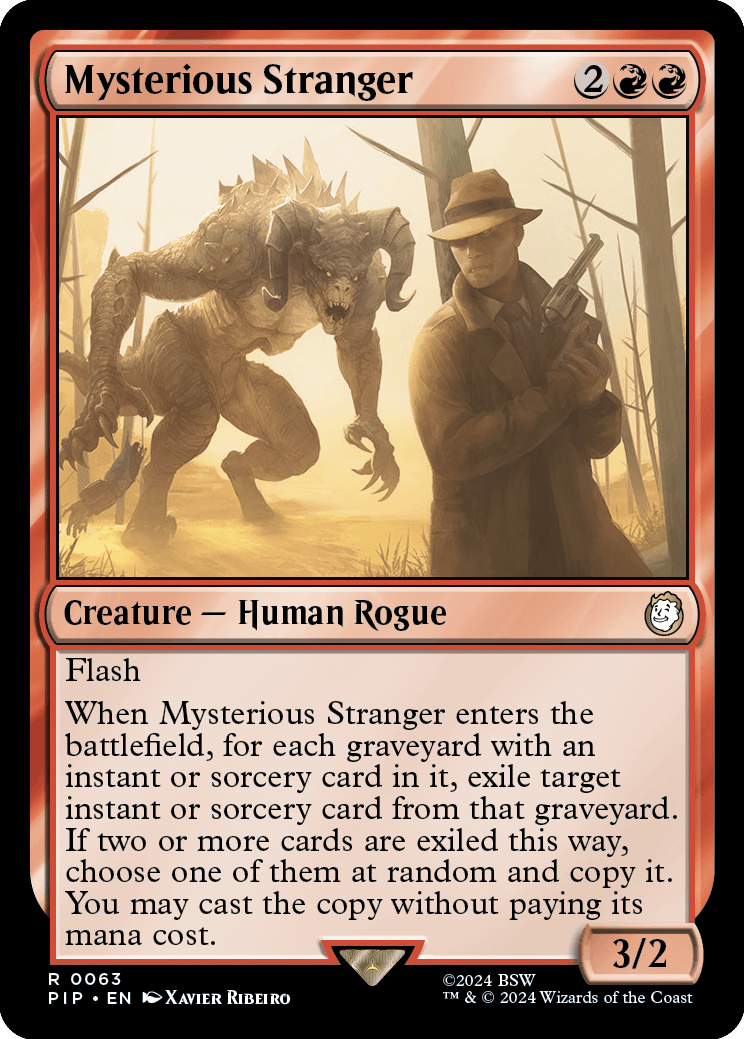
Mysterious Stranger
{2}{R}{R}
Creature — Human Rogue
3/2
Flash
When Mysterious Stranger enters the battlefield, for each graveyard with an instant or sorcery card in it, exile target instant or sorcery card from that graveyard. If two or more cards are exiled this way, choose one of them at random and copy it. You may cast the copy without paying its mana cost.
- You cast the copy while Mysterious Stranger's last ability is resolving and still on the stack. You can't wait to cast it later in the turn.
- If a spell has {X} in its mana cost, you must choose 0 as the value of X when casting it without paying its mana cost.
- If you cast a spell "without paying its mana cost," you can't choose to cast it for any alternative costs. You can, however, pay additional costs. If the spell has any mandatory additional costs, those must be paid to cast the card.
- If you don't want to cast the copy, you can choose not to; the copy ceases to exist the next time state-based actions are checked.
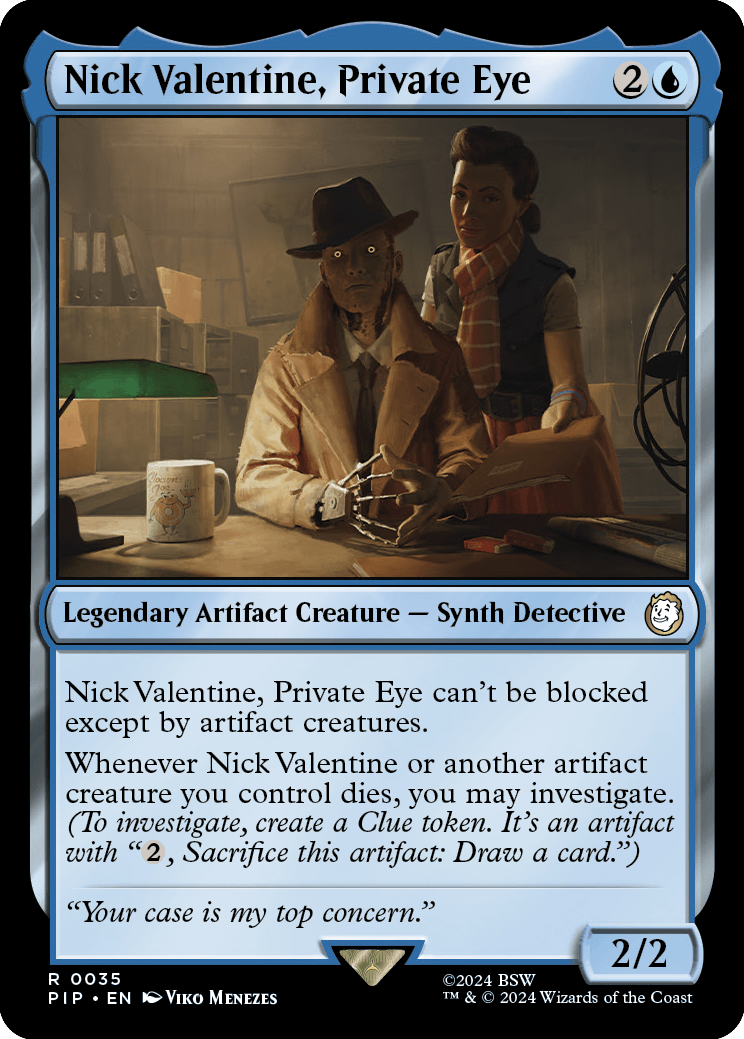
Nick Valentine, Private Eye
{2}{U}
Legendary Artifact Creature — Synth Detective
2/2
Nick Valentine, Private Eye can't be blocked except by artifact creatures.
Whenever Nick Valentine or another artifact creature you control dies, you may investigate. (To investigate, create a Clue token. It's an artifact with "{2}, Sacrifice this artifact: Draw a card.")
- Once Nick Valentine has been blocked, making the blocking creature stop being an artifact won't cause Nick Valentine to become unblocked.
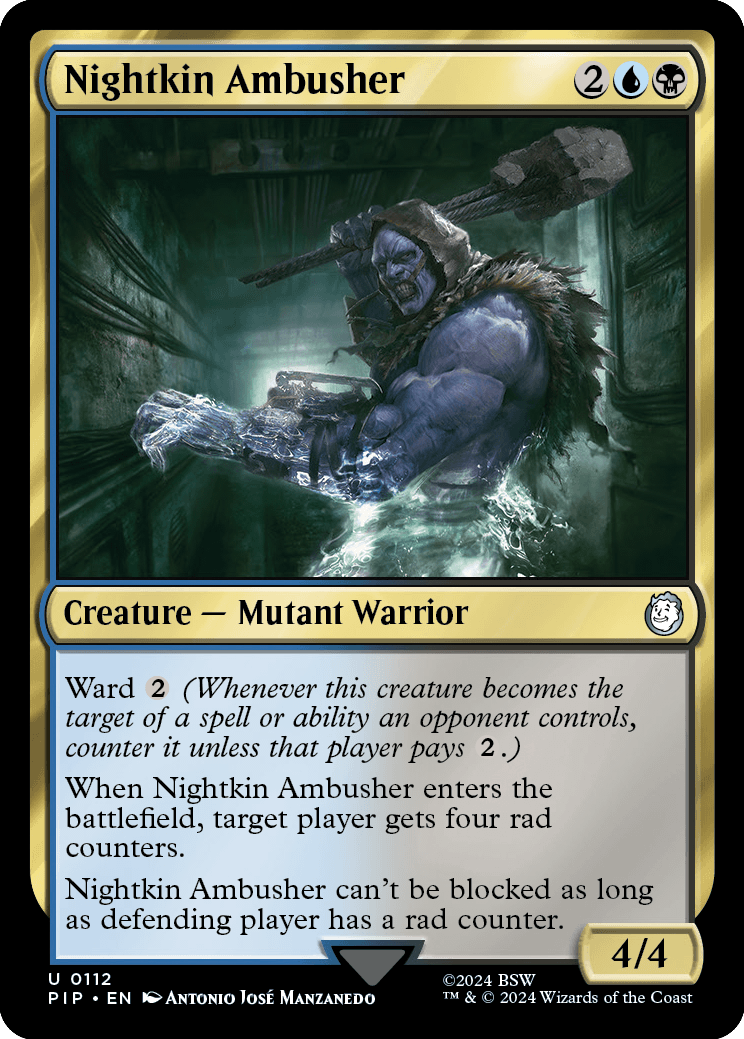
Nightkin Ambusher
{2}{U}{B}
Creature — Mutant Warrior
4/4
Ward {2} (Whenever this creature becomes the target of a spell or ability an opponent controls, counter it unless that player pays {2}.)
When Nightkin Ambusher enters the battlefield, target player gets four rad counters.
Nightkin Ambusher can't be blocked as long as defending player has a rad counter.
- Once Nightkin Ambusher has been blocked, giving the defending player a rad counter won't cause Nightkin Ambusher to become unblocked.
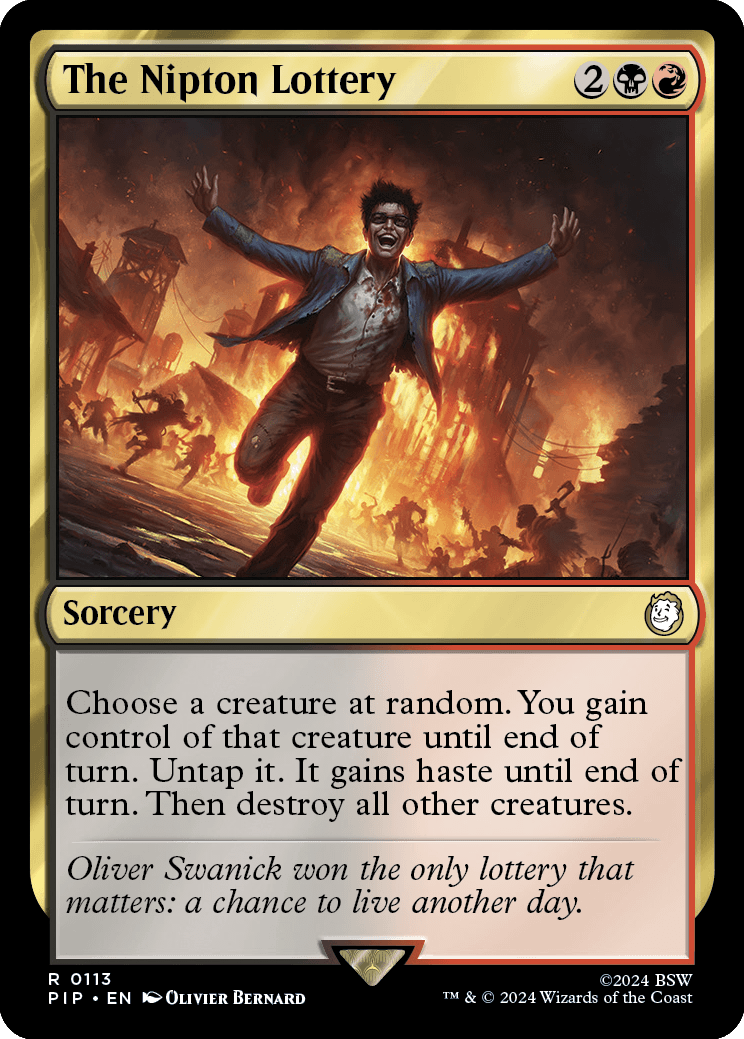
The Nipton Lottery
{2}{B}{R}
Sorcery
Choose a creature at random. You gain control of that creature until end of turn. Untap it. It gains haste until end of turn. Then destroy all other creatures.
- The creature chosen at random isn't targeted, so a creature with shroud or an opponent's creature with hexproof can be chosen this way.
- Players can't take actions between the time the creature is randomly chosen and the time at which the rest of the effects occur.
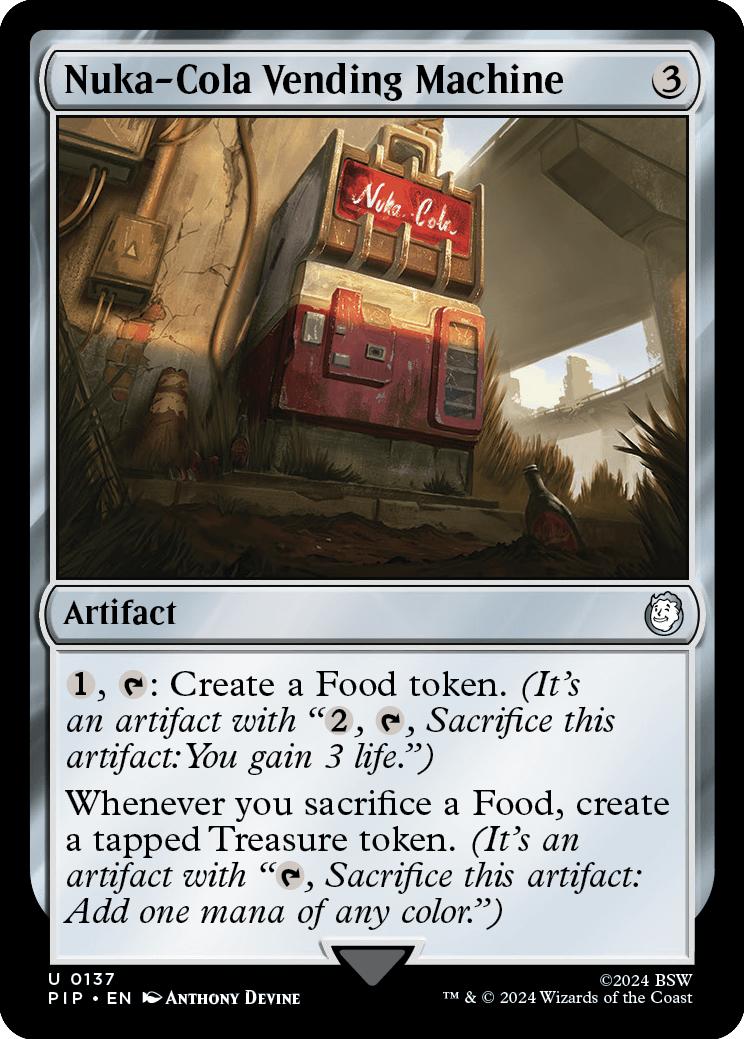
Nuka-Cola Vending Machine
{3}
Artifact
{1}, {T}: Create a Food token. (It's an artifact with "{2}, {T}, Sacrifice this artifact: You gain 3 life.")
Whenever you sacrifice a Food, create a tapped Treasure token. (It's an artifact with "{T}, Sacrifice this artifact: Add one mana of any color.")
- If an effect refers to a Food, it means any Food artifact, not just a Food artifact token. For example, if you sacrifice a nontoken Food artifact, such as Candy Trail from the Wilds of Eldraine set, Nuka-Cola Vending Machine's last ability will trigger.
- Nuka-Cola Vending Machine's last ability triggers whenever you sacrifice a Food for any reason, not just to activate a Food's activated ability.
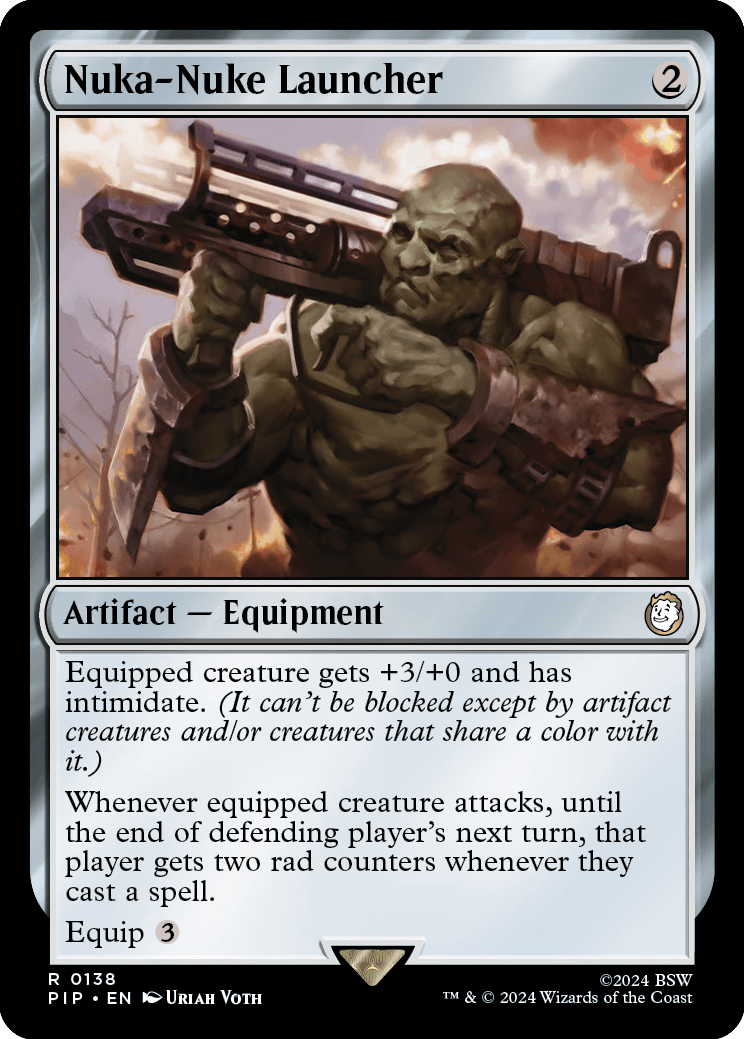
Nuka-Nuke Launcher
{2}
Artifact — Equipment
Equipped creature gets +3/+0 and has intimidate. (It can't be blocked except by artifact creatures and/or creatures that share a color with it.)
Whenever equipped creature attacks, until the end of defending player's next turn, that player gets two rad counters whenever they cast a spell.
Equip {3}
- Once the equipped creature has been blocked, changing its color or the blocking creature's color or stopping the blocking creature from being an artifact won't cause the equipped creature to become unblocked.
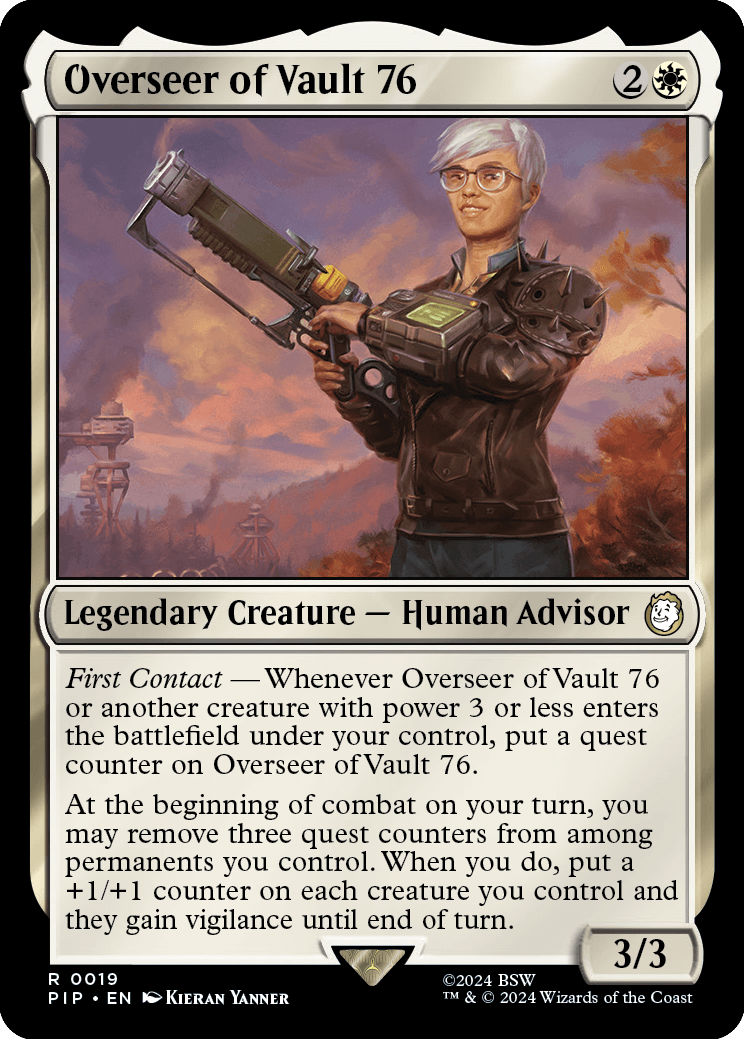
Overseer of Vault 76
{2}{W}
Legendary Creature — Human Advisor
3/3
First Contact — Whenever Overseer of Vault 76 or another creature with power 3 or less enters the battlefield under your control, put a quest counter on Overseer of Vault 76.
At the beginning of combat on your turn, you may remove three quest counters from among permanents you control. When you do, put a +1/+1 counter on each creature you control and they gain vigilance until end of turn.
- If Overseer of Vault 76 and one or more other creatures with power 3 or less enter the battlefield under your control at the same time, Overseer of Vault 76's first ability will trigger for each of them.
- Overseer of Vault 76's last ability lets you choose to remove exactly three quest counters from among permanents you control when it resolves. You can't remove more quest counters to multiply the effect.
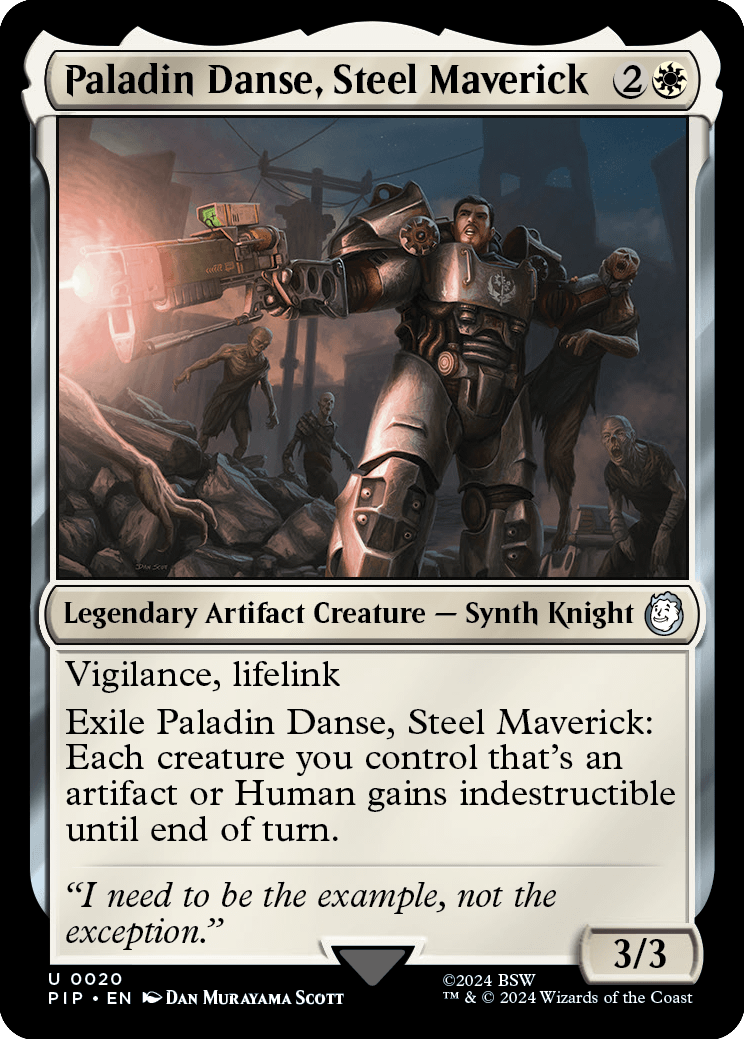
Paladin Danse, Steel Maverick
{2}{W}
Legendary Artifact Creature — Synth Knight
3/3
Vigilance, lifelink
Exile Paladin Danse, Steel Maverick: Each creature you control that's an artifact or Human gains indestructible until end of turn.
- The set of creatures affected by Paladin Danse's last ability is determined as the ability resolves. Artifact creatures and Human creatures you begin to control later in the turn and permanents you control that become artifact creatures or Human creatures later in the turn won't gain indestructible.
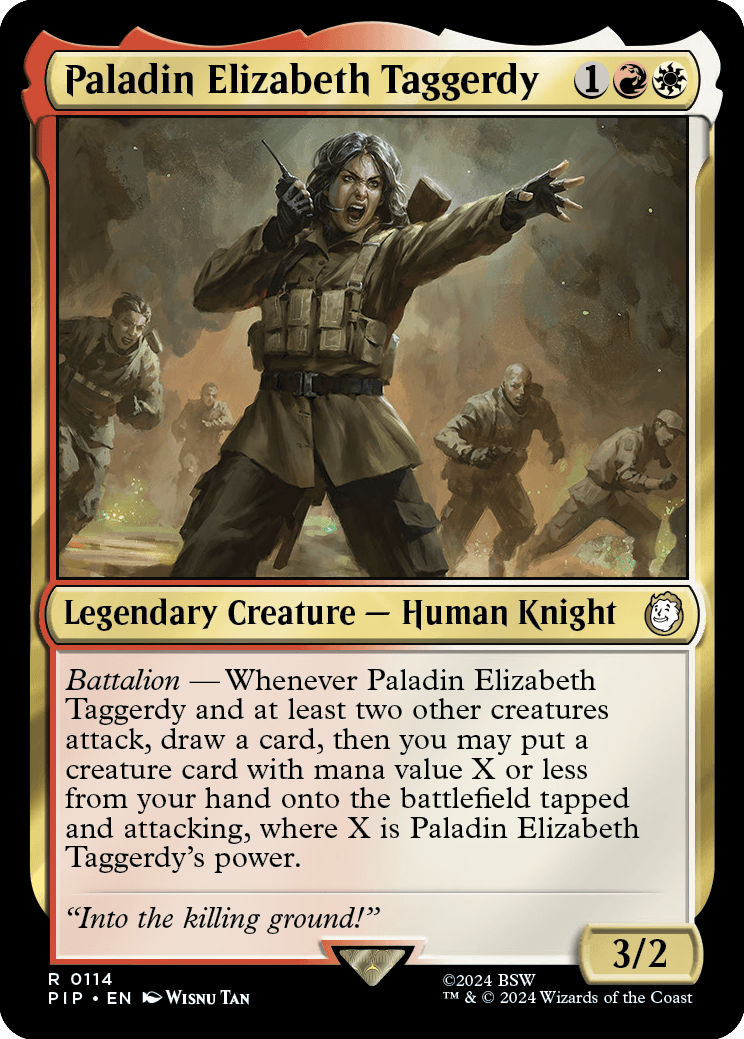
Paladin Elizabeth Taggerdy
{1}{R}{W}
Legendary Creature — Human Knight
3/2
Battalion — Whenever Paladin Elizabeth Taggerdy and at least two other creatures attack, draw a card, then you may put a creature card with mana value X or less from your hand onto the battlefield tapped and attacking, where X is Paladin Elizabeth Taggerdy's power.
- The three attacking creatures don't have to be attacking the same player, planeswalker, or battle.
- Once Paladin Elizabeth Taggerdy's battalion ability has triggered, it doesn't matter how many creatures are still attacking when that ability resolves.
- If Paladin Elizabeth Taggerdy is no longer on the battlefield when its battalion ability resolves, use its power as it last existed on the battlefield to determine the value of X.
- Although the creature you put onto the battlefield is attacking, it was never declared as an attacking creature. This means that abilities that trigger whenever a creature attacks won't trigger when it enters the battlefield attacking.
- You choose which player, planeswalker, or battle the creature you put onto the battlefield is attacking as it enters the battlefield. It doesn't have to be attacking the same player, planeswalker, or battle that Paladin Elizabeth Taggerdy is attacking.
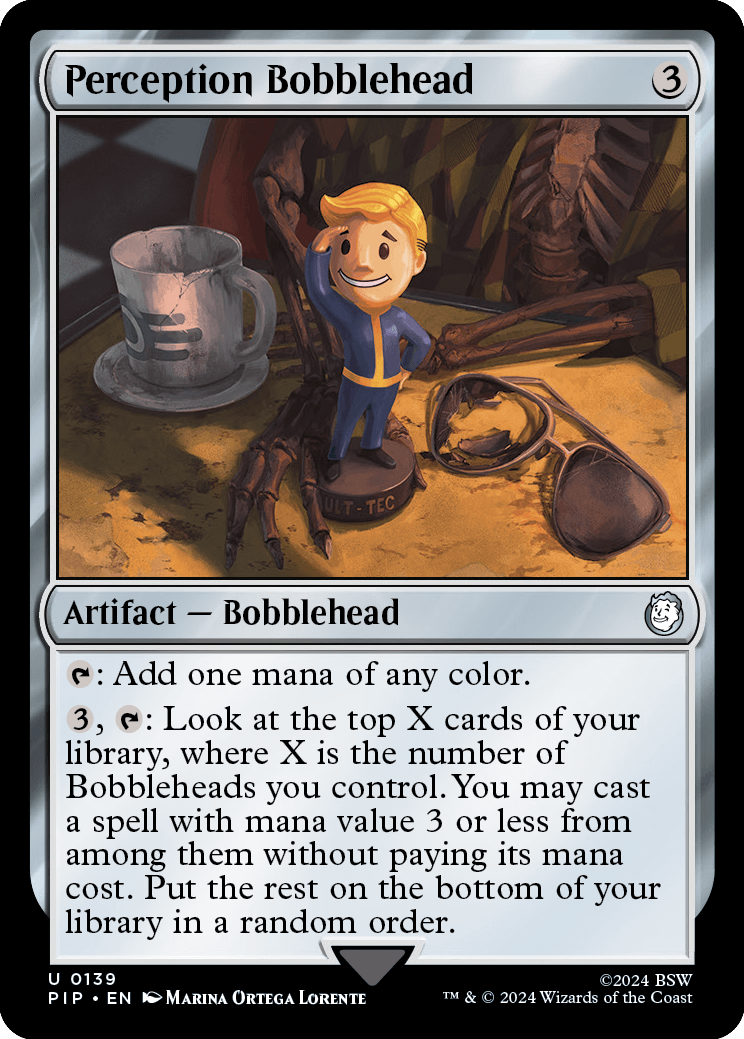
Perception Bobblehead
{3}
Artifact — Bobblehead
{T}: Add one mana of any color.
{3}, {T}: Look at the top X cards of your library, where X is the number of Bobbleheads you control. You may cast a spell with mana value 3 or less from among them without paying its mana cost. Put the rest on the bottom of your library in a random order.
- The value of X is determined only once, as Perception Bobblehead's last ability resolves.
- You choose whether to cast a spell from among the cards you're looking at as Perception Bobblehead's last ability resolves. You can't wait to cast one later in the turn. Timing restrictions based on the card's types are ignored.
- If you cast a spell "without paying its mana cost," you can't choose to cast it for any alternative costs. You can, however, pay additional costs, such as kicker costs. If the card has any mandatory additional costs, those must be paid to cast the spell.
- If a spell you cast has {X} in its mana cost, you must choose 0 as the value of X when casting it without paying its mana cost.
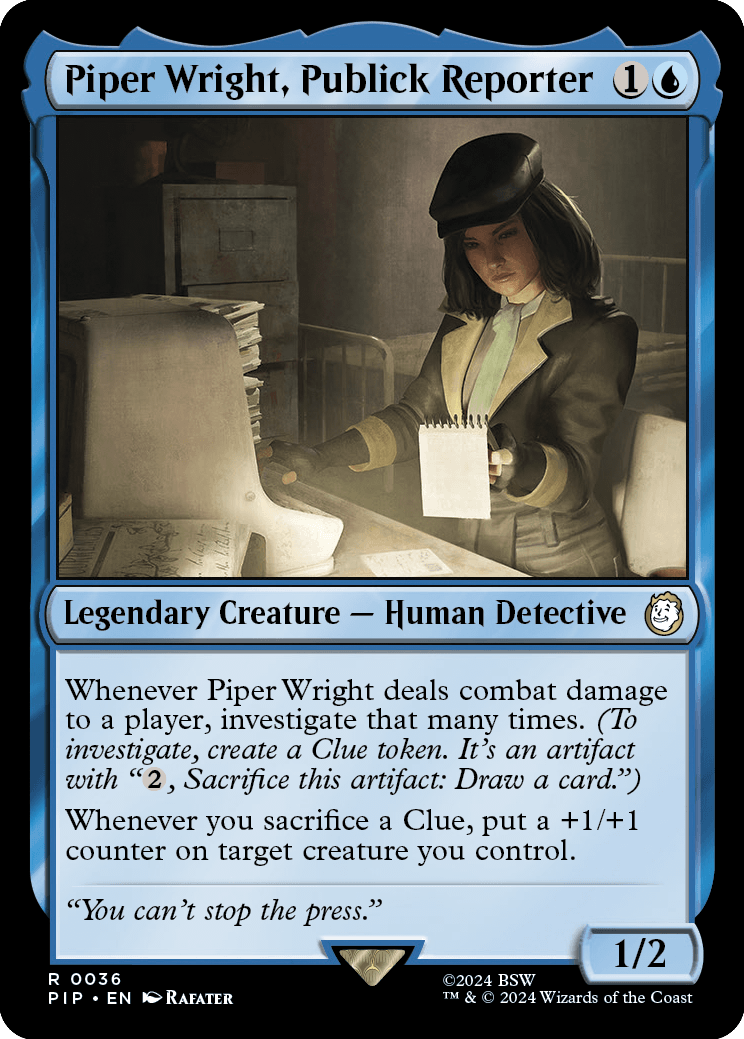
Piper Wright, Publick Reporter
{1}{U}
Legendary Creature — Human Detective
1/2
Whenever Piper Wright deals combat damage to a player, investigate that many times. (To investigate, create a Clue token. It's an artifact with "{2}, Sacrifice this artifact: Draw a card.")
Whenever you sacrifice a Clue, put a +1/+1 counter on target creature you control.
- If an effect refers to a Clue, it means any Clue artifact, not just a Clue artifact token. For example, if you sacrifice a nontoken Clue artifact, such as Candy Trail from the Wilds of Eldraine set, Piper Wright's last ability will trigger.
- Piper Wright's last ability triggers whenever you sacrifice a Clue for any reason, not just to activate a Clue's activated ability.
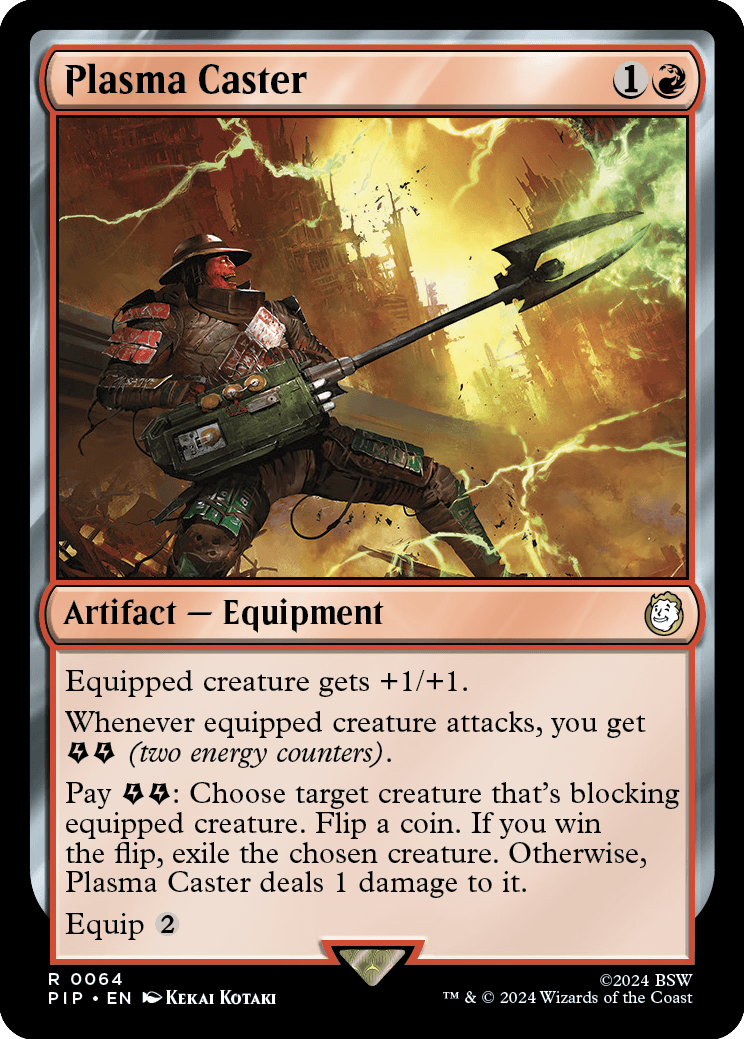
Plasma Caster
{1}{R}
Artifact — Equipment
Equipped creature gets +1/+1.
Whenever equipped creature attacks, you get {E}{E} (two energy counters).
Pay {E}{E}: Choose target creature that's blocking equipped creature. Flip a coin. If you win the flip, exile the chosen creature. Otherwise, Plasma Caster deals 1 damage to it.
Equip {2}
- If the target creature is no longer on the battlefield or no longer blocking the equipped creature when Plasma Caster's third ability tries to resolve, it won't resolve and none of its effects happen. You won't flip a coin.
- If Plasma Caster is no longer on the battlefield or no longer attached to the same creature when its third ability resolves, the ability will still resolve as normal.
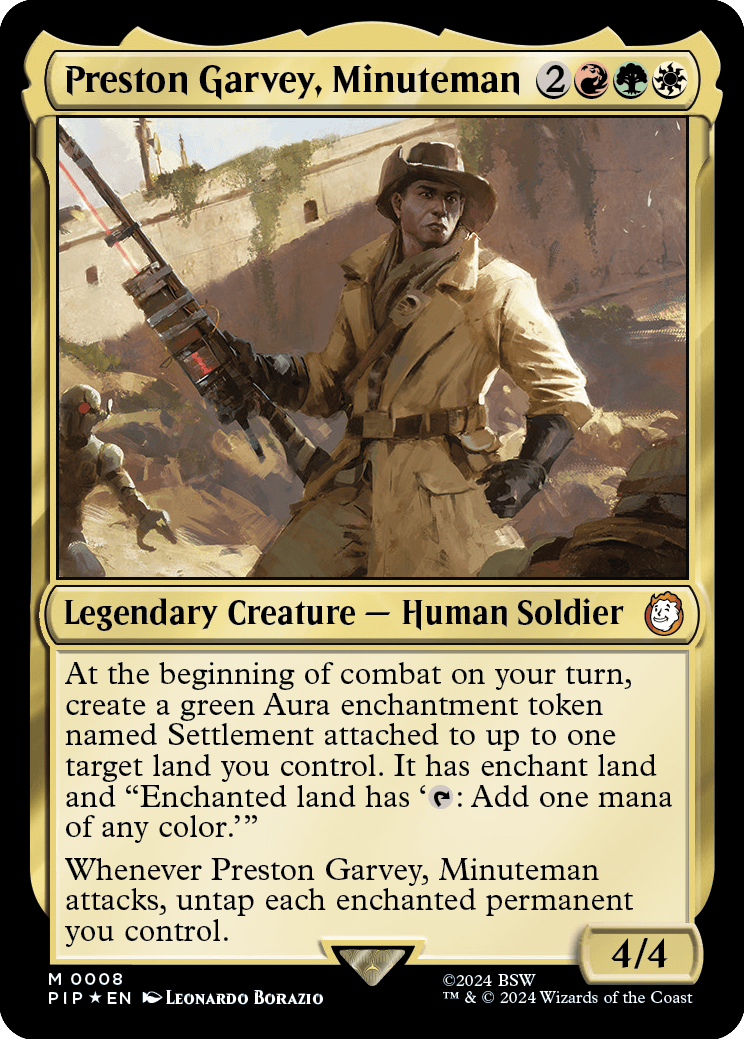
Preston Garvey, Minuteman
{2}{R}{G}{W}
Legendary Creature — Human Soldier
4/4
At the beginning of combat on your turn, create a green Aura enchantment token named Settlement attached to up to one target land you control. It has enchant land and "Enchanted land has '{T}: Add one mana of any color.'"
Whenever Preston Garvey, Minuteman attacks, untap each enchanted permanent you control.
- If the target land is an illegal target as Preston Garvey's first ability tries to resolve, it won't resolve and none of its effects happen. The Settlement token won't be created.
- In the rare case that the target land is a legal target as Preston Garvey's first ability resolves but the target land can't legally be enchanted by the Settlement token, the token won't be created at all.
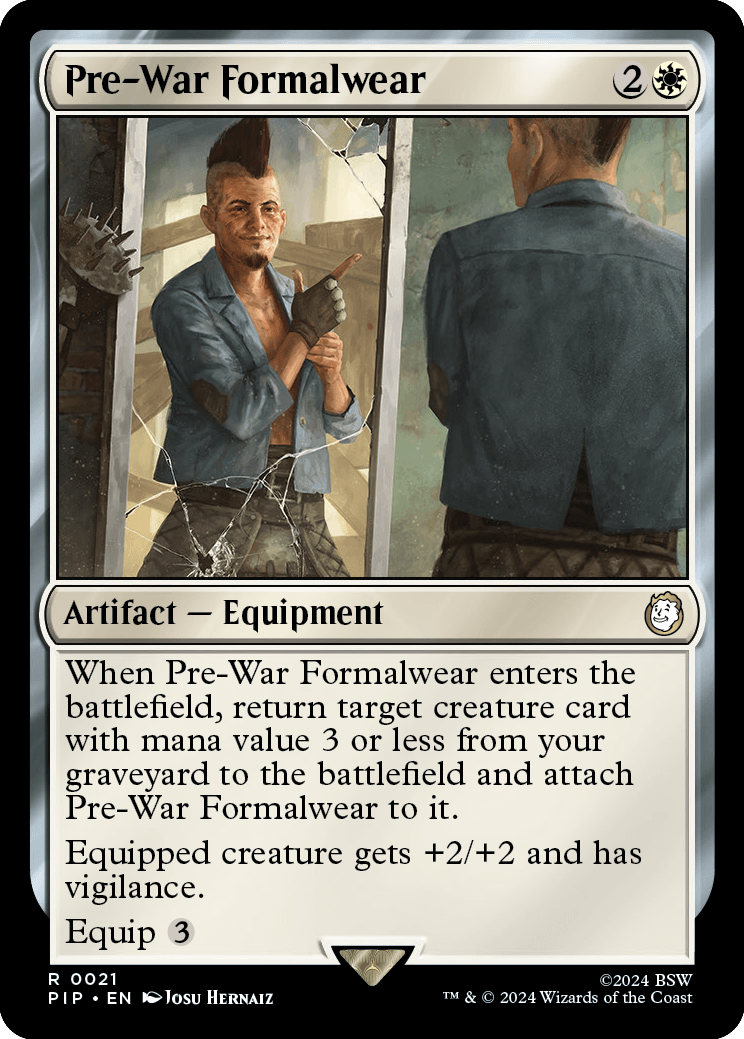
Pre-War Formalwear
{2}{W}
Artifact — Equipment
When Pre-War Formalwear enters the battlefield, return target creature card with mana value 3 or less from your graveyard to the battlefield and attach Pre-War Formalwear to it.
Equipped creature gets +2/+2 and has vigilance.
Equip {3}
- If Pre-War Formalwear can't be attached to the permanent returned to the battlefield by its first ability (perhaps because it's not currently a creature), Pre-War Formalwear will remain on the battlefield unattached.
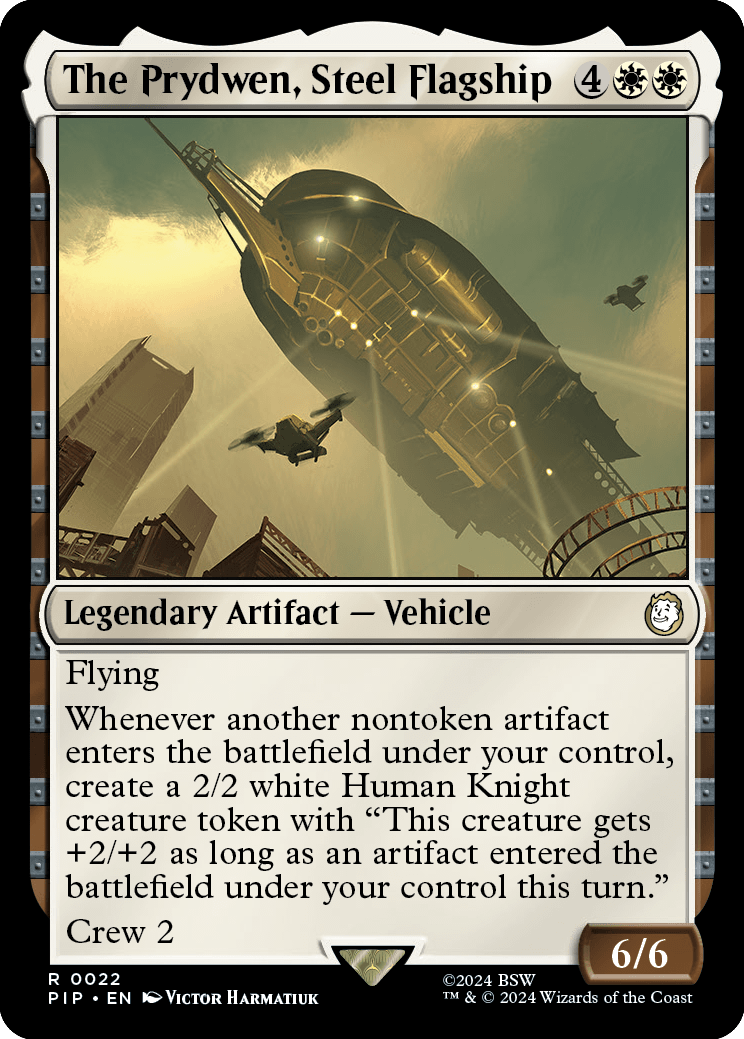
The Prydwen, Steel Flagship
{4}{W}{W}
Legendary Artifact — Vehicle
6/6
Flying
Whenever another nontoken artifact enters the battlefield under your control, create a 2/2 white Human Knight creature token with "This creature gets +2/+2 as long as an artifact entered the battlefield under your control this turn."
Crew 2
- Once an artifact enters the battlefield under your control in a given turn, it doesn't matter what happens to it later. A Knight token created by The Prydwen, Steel Flagship's second ability will still get +2/+2 for the rest of that turn.
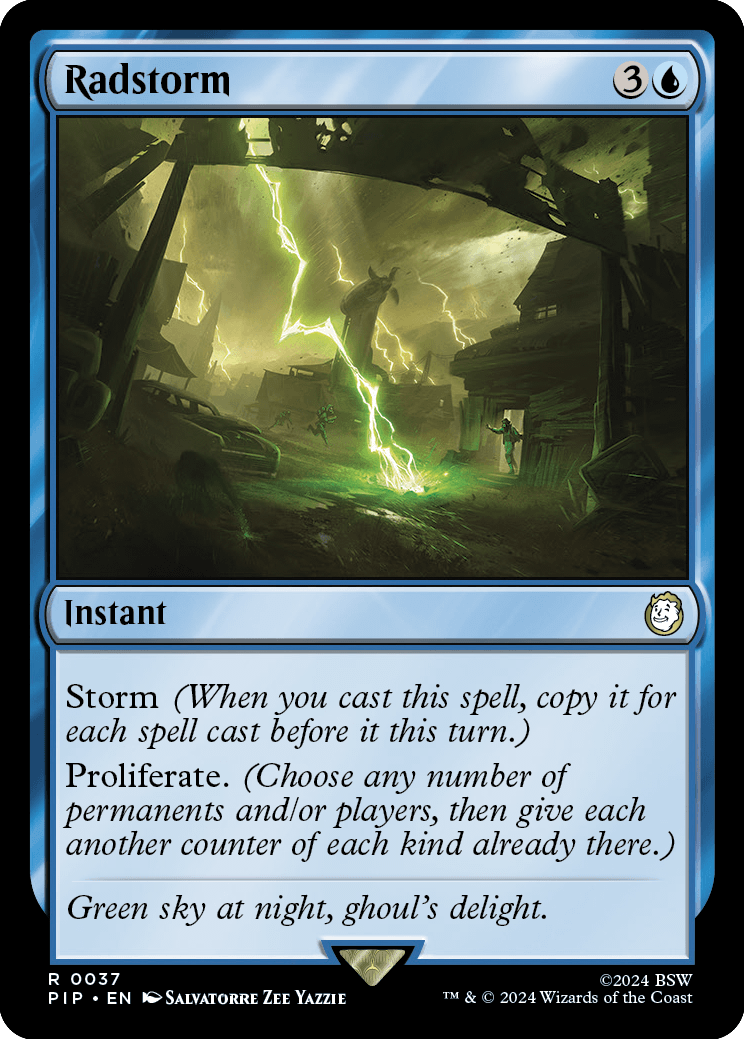
Radstorm
{3}{U}
Instant
Storm (When you cast this spell, copy it for each spell cast before it this turn.)
Proliferate. (Choose any number of permanents and/or players, then give each another counter of each kind already there.)
- The copies of Radstorm created by its storm ability are put directly onto the stack. They aren't cast and won't be counted by other spells with storm cast later in the turn.
- Spells cast from zones other than a player's hand and spells that were countered or otherwise failed to resolve are counted by the storm ability.
- A copy of a spell can be countered like any other spell, but it must be countered individually. Countering a spell with storm won't affect the copies.
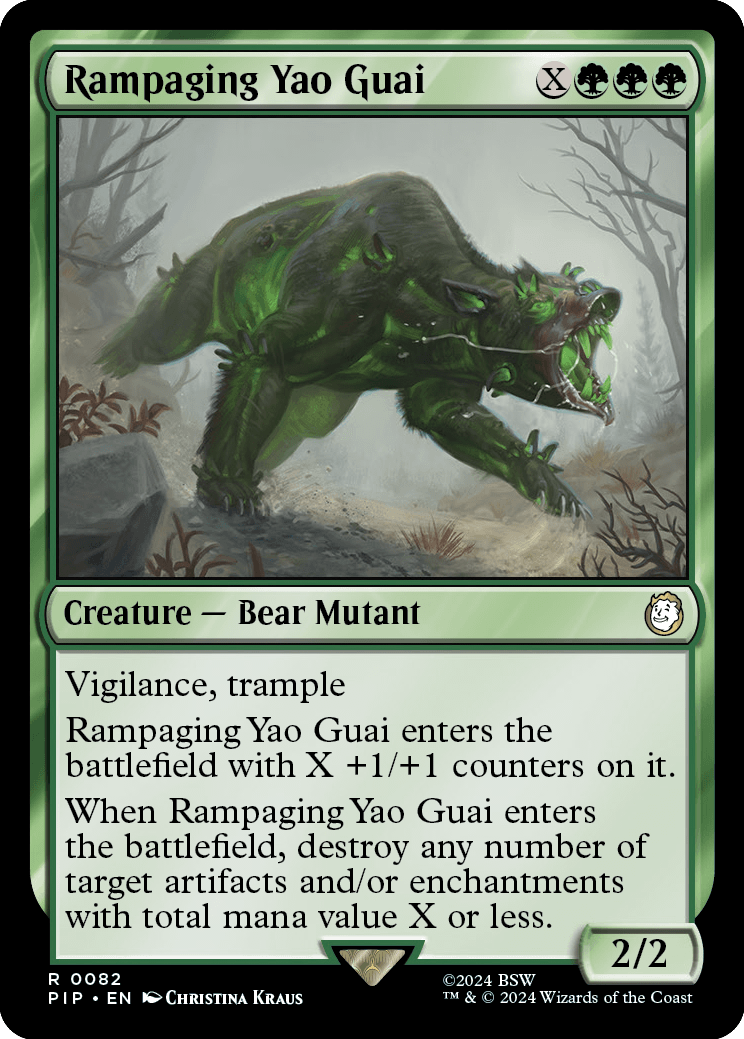
Rampaging Yao Guai
{X}{G}{G}{G}
Creature — Bear Mutant
2/2
Vigilance, trample
Rampaging Yao Guai enters the battlefield with X +1/+1 counters on it.
When Rampaging Yao Guai enters the battlefield, destroy any number of target artifacts and/or enchantments with total mana value X or less.
- If a permanent has {X} in its mana cost, X is 0 when determining its mana value.
- A token that's not a copy of something else normally won't have a mana cost. Anything without a mana cost normally has a mana value of 0.
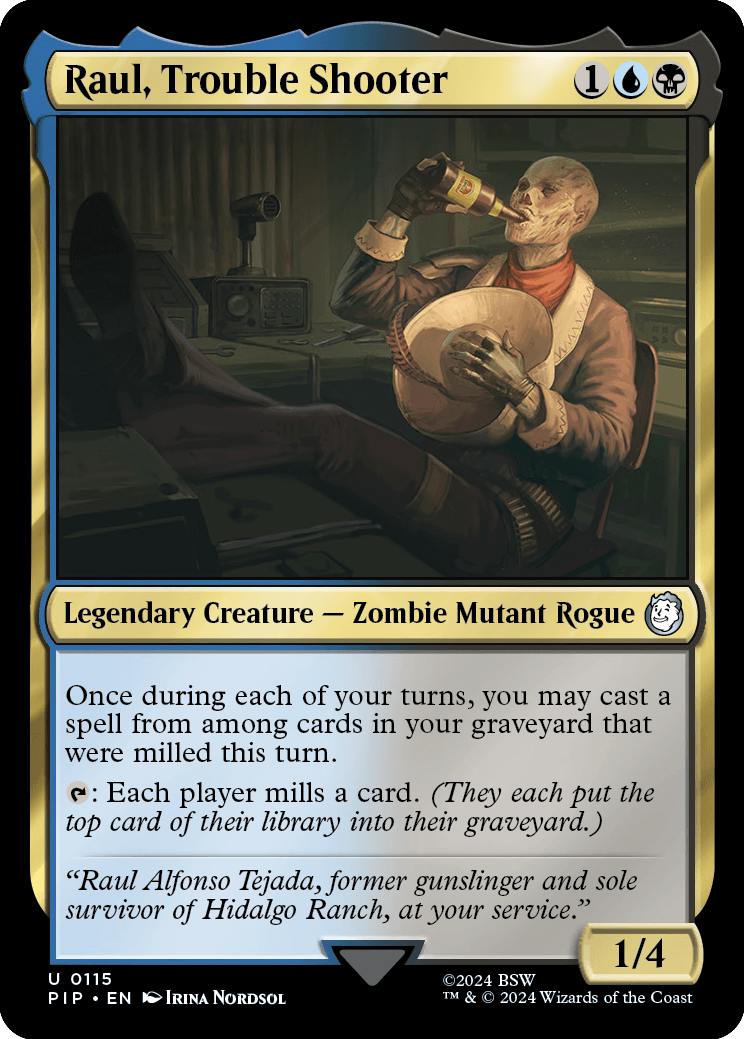
Raul, Trouble Shooter
{1}{U}{B}
Legendary Creature — Zombie Mutant Rogue
1/4
Once during each of your turns, you may cast a spell from among cards in your graveyard that were milled this turn.
{T}: Each player mills a card. (They each put the top card of their library into their graveyard.)
- If you are instructed to put a card into your graveyard from your library without using the word "mill," (by the effect of Rowan's Grim Search from Wilds of Eldraine, for example), Raul's first ability won't allow you to cast it.
- You must follow the normal timing permissions and restrictions of the spell you cast from your graveyard.
- You must pay the costs to cast that spell. If it has an alternative cost, you may cast it for that cost instead.
- Once you begin to cast the spell, losing control of Raul won't affect the spell.
- If you cast a spell from among cards in your graveyard that were milled this turn using another permission, Raul's effect doesn't apply. You can cast another spell among cards in your graveyard that were milled this turn using the permission granted by Raul's first ability.
- If you cast a spell from among cards in your graveyard that were milled this turn using the permission granted by Raul's first ability and then have a new Raul, Trouble Shooter come under your control in the same turn, you may cast another spell from among cards in your graveyard that were milled this turn.
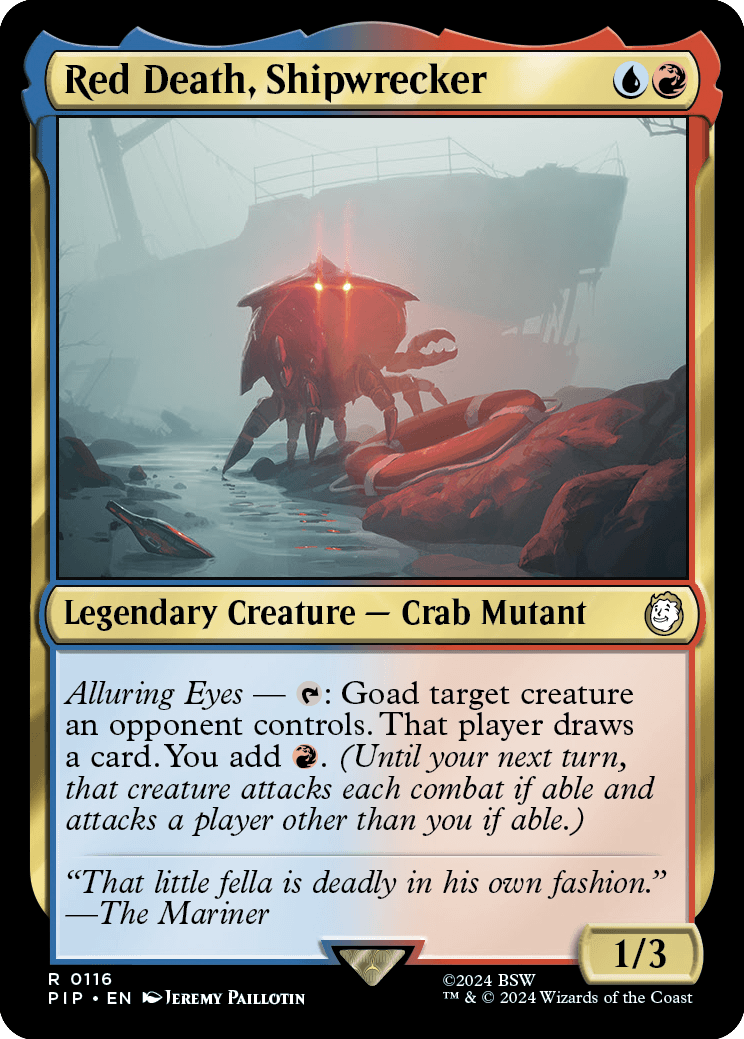
Red Death, Shipwrecker
{U}{R}
Legendary Creature — Crab Mutant
1/3
Alluring Eyes — {T}: Goad target creature an opponent controls. That player draws a card. You add {R}. (Until your next turn, that creature attacks each combat if able and attacks a player other than you if able.)
- If the target creature is an illegal target as Red Death's ability tries to resolve, it won't resolve and none of its effects happen. You won't add any mana, and the creature's controller won't draw a card.
- Red Death's ability isn't a mana ability even though it causes you to add mana. It uses the stack and can be responded to.
- If, during a player's declare attackers step, a creature that player controls that's been goaded is tapped, is affected by a spell or ability that says it can't attack, or hasn't been under that player's control continuously since the turn began (and doesn't have haste), then it doesn't attack. If there's a cost associated with having a creature attack a player, its controller isn't forced to pay that cost, so it doesn't have to attack that player.
- If the creature doesn't meet any of the above exceptions and can attack, it must attack a player other than the controller of the spell or ability that goaded it if able. If the creature can't attack any of those players but could otherwise attack, it must attack a planeswalker an opponent controls, a battle an opponent protects, or the player that goaded it.
- Being goaded isn't an ability the creature has. Once it's been goaded, it must attack as detailed above even if it loses all abilities.
- Attacking with a goaded creature doesn't cause it to stop being goaded. If there is an additional combat phase that turn, or if another player gains control of it before it stops being goaded, it must attack again if able.

Rex, Cyber-Hound
{1}{W}{U}
Legendary Artifact Creature — Robot Dog
2/2
Whenever Rex, Cyber-Hound deals combat damage to a player, they mill two cards and you get {E}{E} (two energy counters).
Pay {E}{E}: Choose target creature card in a graveyard. Exile it with a brain counter on it. Activate only as a sorcery.
Rex has all activated abilities of all cards in exile with brain counters on them.
- Rex gains only activated abilities. It doesn't gain triggered abilities or static abilities. Activated abilities contain a colon. They're generally written "[Cost]: [Effect]." Some keywords are activated abilities and may have colons in their reminder text.
- If an activated ability of a card in exile with a brain counter on it references the card it's printed on by name, treat Rex's version of that ability as though it referenced Rex, Cyber-Hound instead. For example, say Arcade Gannon (which has the ability "{T}: Draw a card, then discard a card. Put a quest counter on Arcade Gannon.") is in exile with a brain counter on it. You would treat Rex's version of the ability as though it said "{T}: Draw a card, then discard a card. Put a quest counter on Rex, Cyber-Hound."
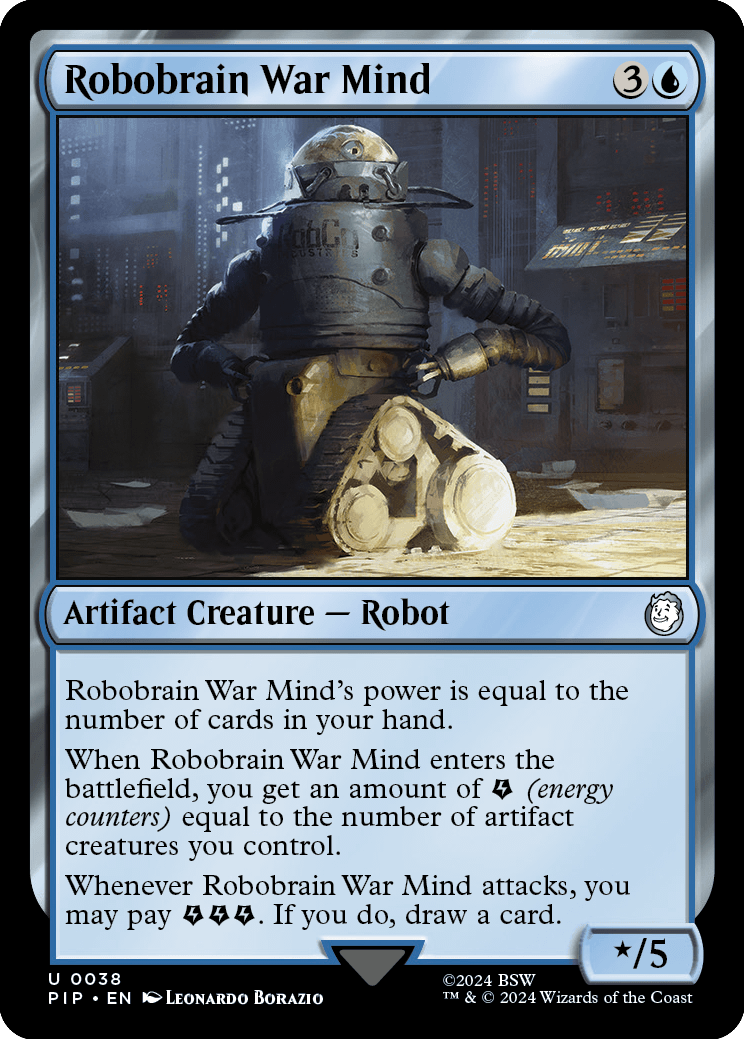
Robobrain War Mind
{3}{U}
Artifact Creature — Robot
*/5
Robobrain War Mind's power is equal to the number of cards in your hand.
When Robobrain War Mind enters the battlefield, you get an amount of {E} (energy counters) equal to the number of artifact creatures you control.
Whenever Robobrain War Mind attacks, you may pay {E}{E}{E}. If you do, draw a card.
- The ability that defines Robobrain War Mind's power functions in all zones, not just the battlefield.
- Use the number of artifact creatures you control when Robobrain War Mind's second ability resolves, including Robobrain War Mind itself if it's still on the battlefield, to determine the number of energy counters you get.
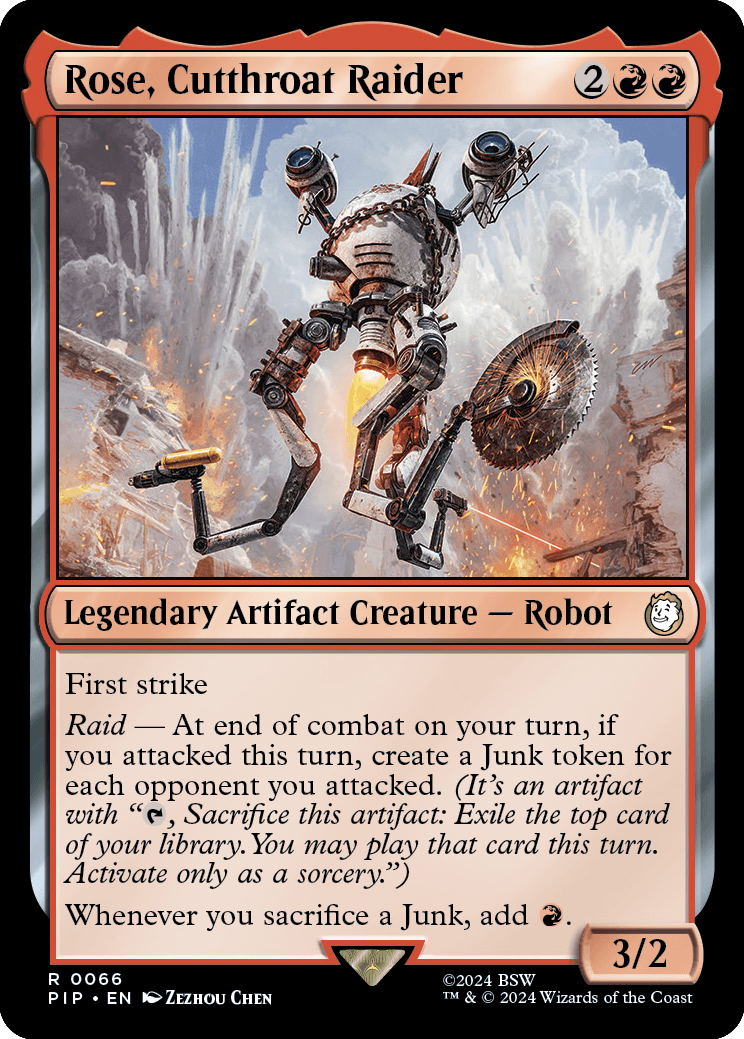
Rose, Cutthroat Raider
{2}{R}{R}
Legendary Artifact Creature — Robot
3/2
First strike
Raid — At end of combat on your turn, if you attacked this turn, create a Junk token for each opponent you attacked. (It's an artifact with "{T}, Sacrifice this artifact: Exile the top card of your library. You may play that card this turn. Activate only as a sorcery.")
Whenever you sacrifice a Junk, add {R}.
- Rose's raid ability cares only that you attacked with at least one creature this turn. It doesn't matter whether or not the creature or creatures are still on the battlefield or whether the players or permanents they attacked are still in the game or on the battlefield.
- Rose's last ability triggers when you sacrifice a Junk for any reason, not just to activate a Junk's activated ability.
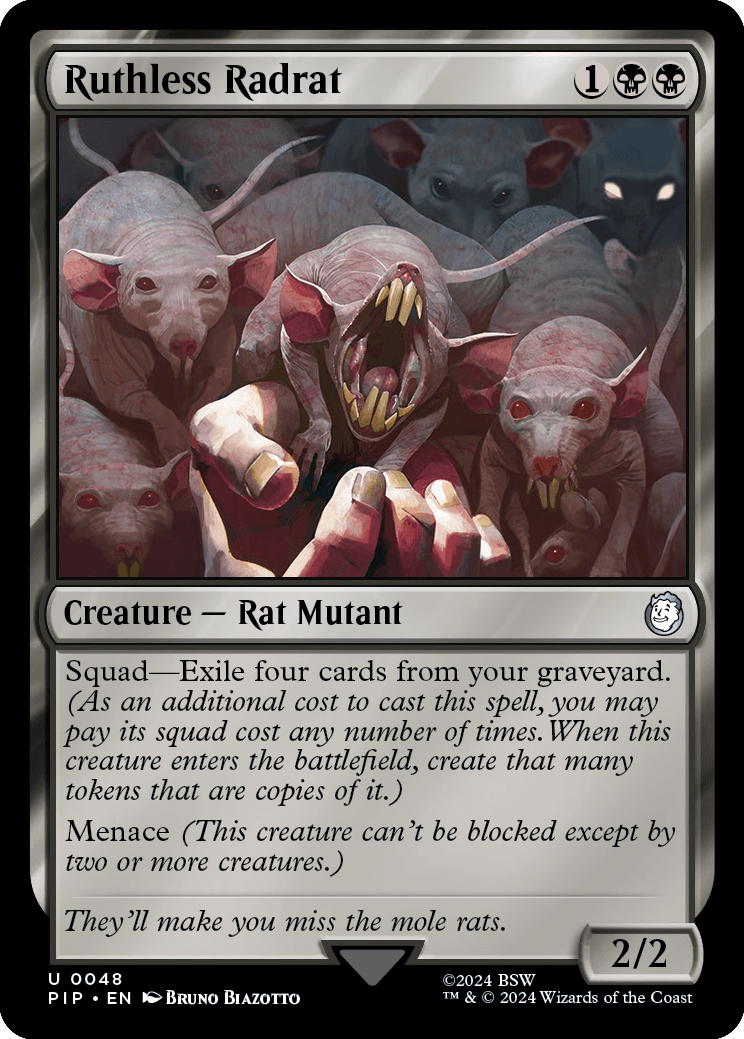
Ruthless Radrat
{1}{B}{B}
Creature — Rat Mutant
2/2
Squad—Exile four cards from your graveyard. (As an additional cost to cast this spell, you may pay its squad cost any number of times. When this creature enters the battlefield, create that many tokens that are copies of it.)
Menace (This creature can't be blocked except by two or more creatures.)
- Once you announce that you're casting Ruthless Radrat, no player may take actions until you're done casting it. Notably, opponents can't try to remove cards from your graveyard to stop you from paying Ruthless Radrat's squad cost.
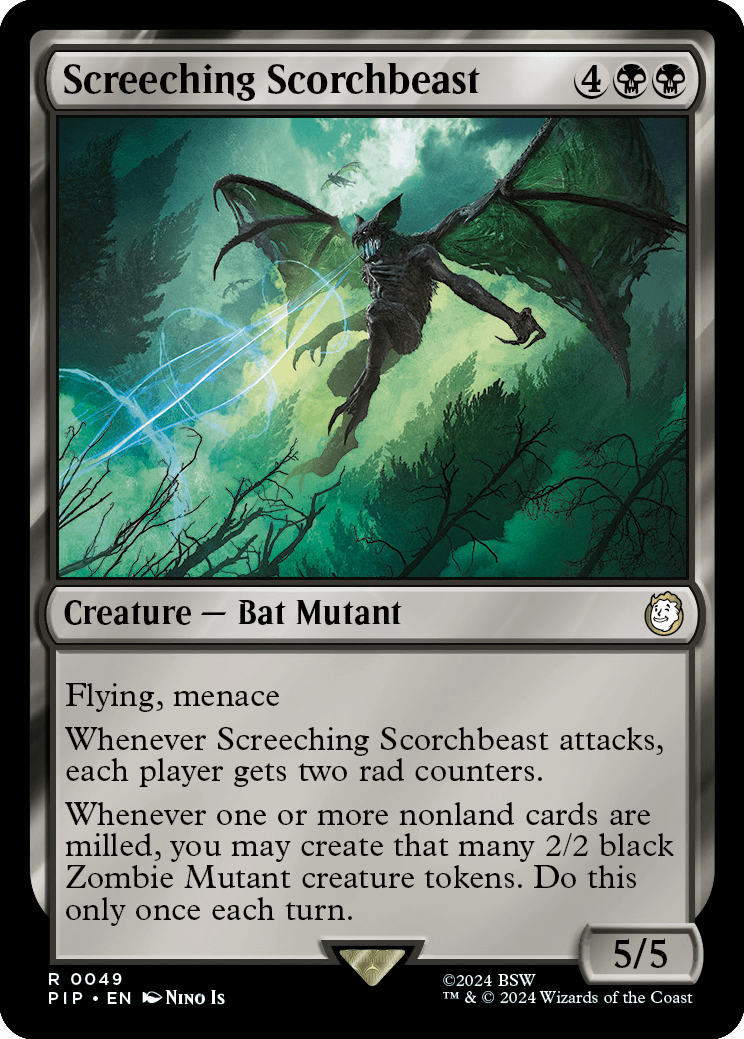
Screeching Scorchbeast
{4}{B}{B}
Creature — Bat Mutant
5/5
Flying, menace
Whenever Screeching Scorchbeast attacks, each player gets two rad counters.
Whenever one or more nonland cards are milled, you may create that many 2/2 black Zombie Mutant creature tokens. Do this only once each turn.
- If more than one player is instructed to mill at the same time (by the activated ability of Raul, Trouble Shooter, for example), as long as at least one nonland card is milled, Screeching Scorchbeast's last ability will trigger just once.
- "Do this only once each turn" lets you choose whether or not to create the appropriate number of 2/2 black Zombie Mutant creature tokens as the triggered ability resolves. If you choose not to create tokens, the ability will trigger again the next time the condition is met. Once you choose to do so, the ability will no longer trigger for the rest of the turn.
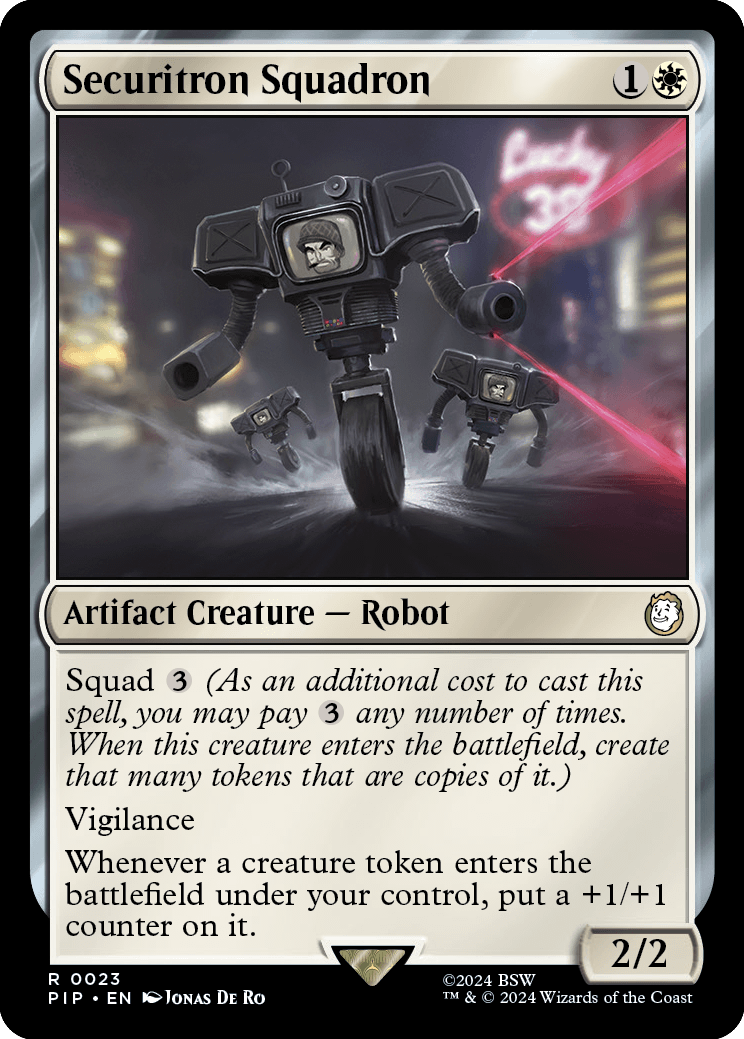
Securitron Squadron
{1}{W}
Artifact Creature — Robot
2/2
Squad {3} (As an additional cost to cast this spell, you may pay {3} any number of times. When this creature enters the battlefield, create that many tokens that are copies of it.)
Vigilance
Whenever a creature token enters the battlefield under your control, put a +1/+1 counter on it.
- If Securitron Squadron enters the battlefield at the same time as one or more creature tokens, its last ability will trigger for each of those creature tokens. If that Securitron Squadron is itself a creature token, its last ability will trigger when it enters the battlefield as well.
- For example, if you pay Securitron Squadron's squad cost three times, then you'll create three token copies of Securitron Squadron when its squad ability resolves. Each of those tokens will enter the battlefield simultaneously. When they enter, their last abilities will each trigger three times (once for each of the other two tokens, and once for itself.) If the original Securitron Squadron is still on the battlefield, its last ability will trigger three times as well. After all of the triggered abilities resolve, each of the three token copies of Securitron Squadron will have four +1/+1 counters on it.

Sentinel Sarah Lyons
{3}{R}{W}
Legendary Creature — Human Knight
4/4
Haste
As long as an artifact entered the battlefield under your control this turn, creatures you control get +2/+2.
Battalion — Whenever Sentinel Sarah Lyons and at least two other creatures attack, Sentinel Sarah Lyons deals damage equal to the number of artifacts you control to target player.
- Sentinel Sarah Lyons's second ability only cares if one or more artifacts entered the battlefield under your control this turn. Your creatures won't get more powerful if more than one artifact entered the battlefield under your control this turn.
- Once an artifact enters the battlefield under your control in a given turn, it doesn't matter what happens to it later. Creatures you control will still get +2/+2 that turn as long as Sentinel Sarah Lyons is on the battlefield under your control.
- Sentinel Sarah Lyons doesn't have to have been on the battlefield at the point in the turn where an artifact entered the battlefield under your control. If an artifact enters the battlefield under your control and then Sentinel Sarah Lyons enters the battlefield under your control later in that turn, creatures you control will still get +2/+2 that turn as long as Sentinel Sarah Lyons remains on the battlefield and under your control.
- The three attacking creatures don't have to be attacking the same player, planeswalker, or battle.
- Once Sentinel Sarah Lyons's battalion ability has triggered, it doesn't matter how many creatures are still attacking when that ability resolves. It also doesn't matter whether or not Sentinel Sarah Lyons is still attacking or on the battlefield.
- Use the number of artifacts you control at the time Sentinel Sarah Lyons's battalion ability resolves to determine how much damage to deal.

Sentry Bot
{4}{W}
Artifact Creature — Robot
2/5
Flash
This spell costs {1} less to cast for each creature attacking you.
When Sentry Bot enters the battlefield, you get {E} for each creature attacking you.
At the beginning of combat on your turn, you may pay {E}{E}{E}. If you do, put a +1/+1 counter on each creature you control.
- The cost-reduction ability of Sentry Bot doesn't change its mana cost or mana value, only the total cost you pay. Specifically, the mana value of Sentry Bot is always 5.
- Once you announce that you're casting Sentry Bot, no player may take actions until you're done casting it. Notably, opponents can't remove creatures from combat to try to change Sentry Bot's total cost.
- Use the number of creatures attacking you as Sentry Bot's third ability resolves to determine the number of energy counters you get.
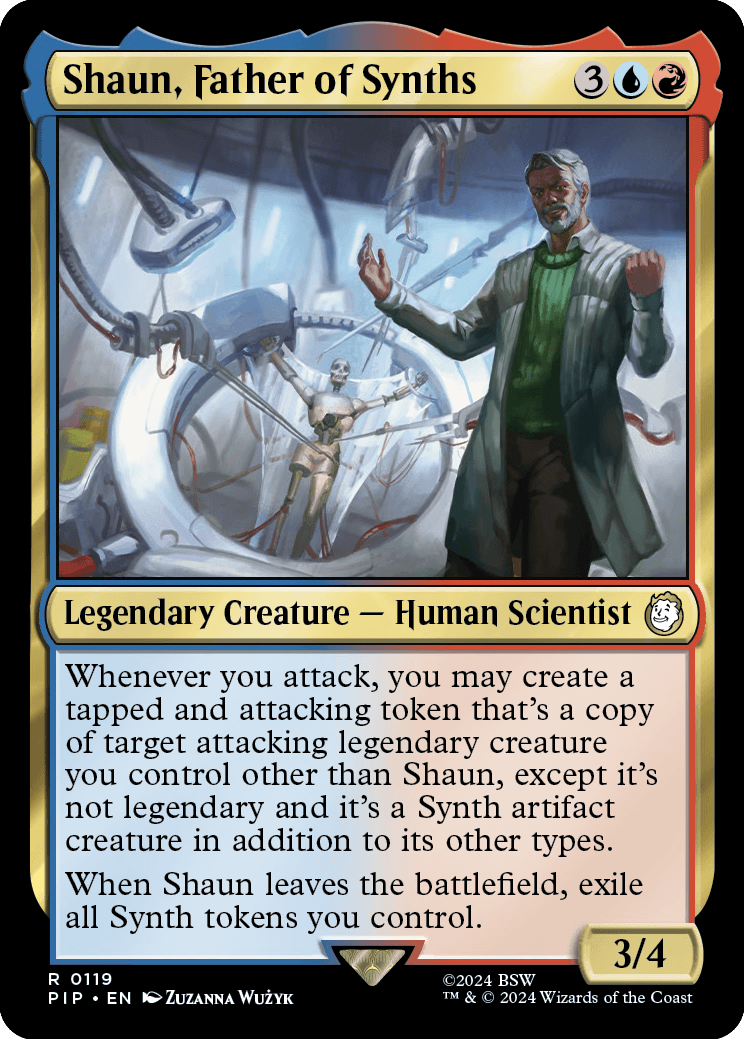
Shaun, Father of Synths
{3}{U}{R}
Legendary Creature — Human Scientist
3/4
Whenever you attack, you may create a tapped and attacking token that's a copy of target attacking legendary creature you control other than Shaun, except it's not legendary and it's a Synth artifact creature in addition to its other types.
When Shaun leaves the battlefield, exile all Synth tokens you control.
- Except for the noted exceptions, the token copies exactly what was printed on the original creature and nothing else (unless that creature is copying something else or is a token; see below). It doesn't copy whether that creature is tapped or untapped, whether it has any counters on it or Auras and Equipment attached to it, or any non-copy effects that have changed its power, toughness, types, color, and so on.
- If the copied creature has {X} in its mana cost, X is 0.
- If the copied creature is a token, the token that's created copies the original characteristics of that token as stated by the effect that created that token, with the noted exceptions.
- If the copied creature is copying something else, then the token enters the battlefield as whatever that creature copied, with the noted exceptions.
- Any enters-the-battlefield abilities of the copied creature will trigger when the token enters the battlefield. Any "as [this creature] enters the battlefield" or "[this creature] enters the battlefield with" abilities of the copied creature will also work.
- Although the token is attacking, it was never declared as an attacking creature. This means that abilities that trigger whenever a creature attacks won't trigger when it enters the battlefield attacking.
- You declare which player, planeswalker, or battle the token is attacking as you put it onto the battlefield. It doesn't have to be attacking the same player, planeswalker, or battle that Shaun is attacking.
- Shaun's last ability will exile all Synth tokens you control, not just Synth tokens created by its first ability.
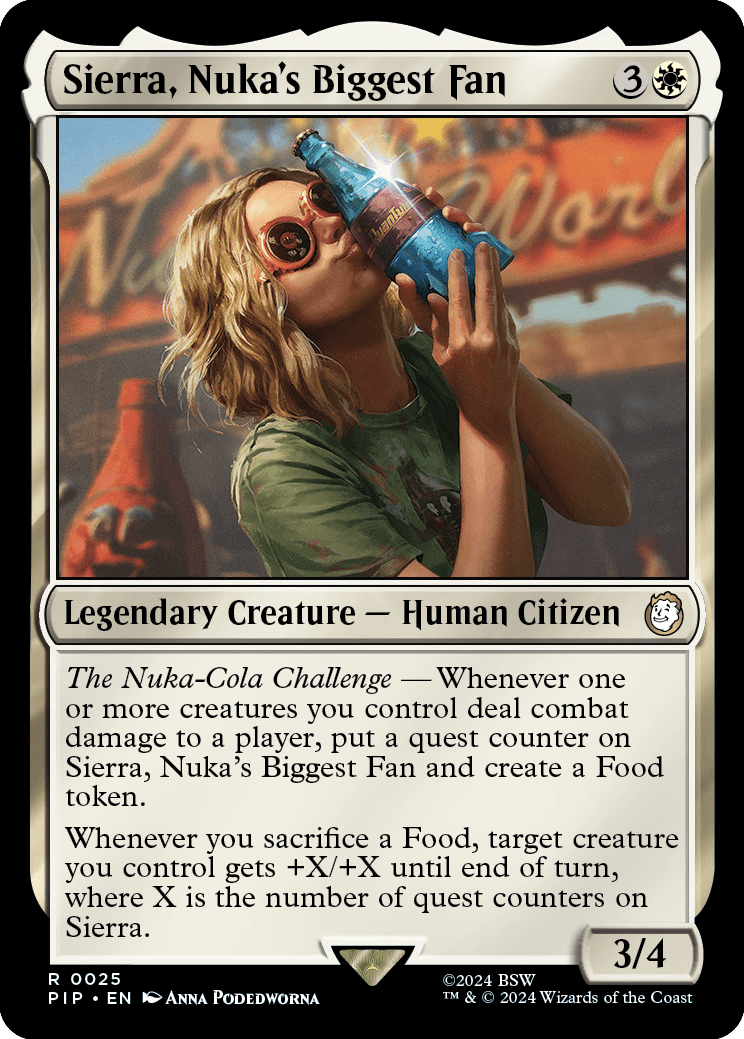
Sierra, Nuka's Biggest Fan
{3}{W}
Legendary Creature — Human Citizen
3/4
The Nuka-Cola Challenge — Whenever one or more creatures you control deal combat damage to a player, put a quest counter on Sierra, Nuka's Biggest Fan and create a Food token.
Whenever you sacrifice a Food, target creature you control gets +X/+X until end of turn, where X is the number of quest counters on Sierra.
- If an effect refers to a Food, it means any Food artifact, not just a Food artifact token. For example, if you sacrifice a nontoken Food artifact, such as Candy Trail from the Wilds of Eldraine set, Sierra's last ability will trigger.
- Sierra's last ability triggers whenever you sacrifice a Food for any reason, not just to activate a Food's activated ability.
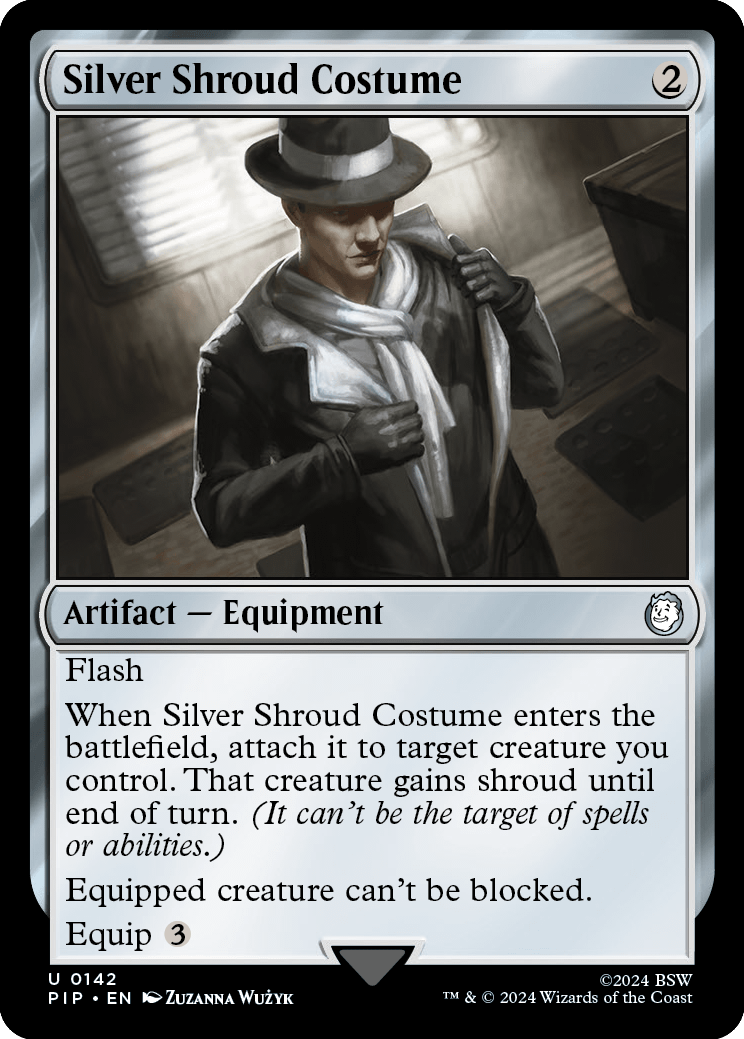
Silver Shroud Costume
{2}
Artifact — Equipment
Flash
When Silver Shroud Costume enters the battlefield, attach it to target creature you control. That creature gains shroud until end of turn. (It can't be the target of spells or abilities.)
Equipped creature can't be blocked.
Equip {3}
- Attaching Silver Shroud Costume to a creature that has already been blocked won't cause it to become unblocked.
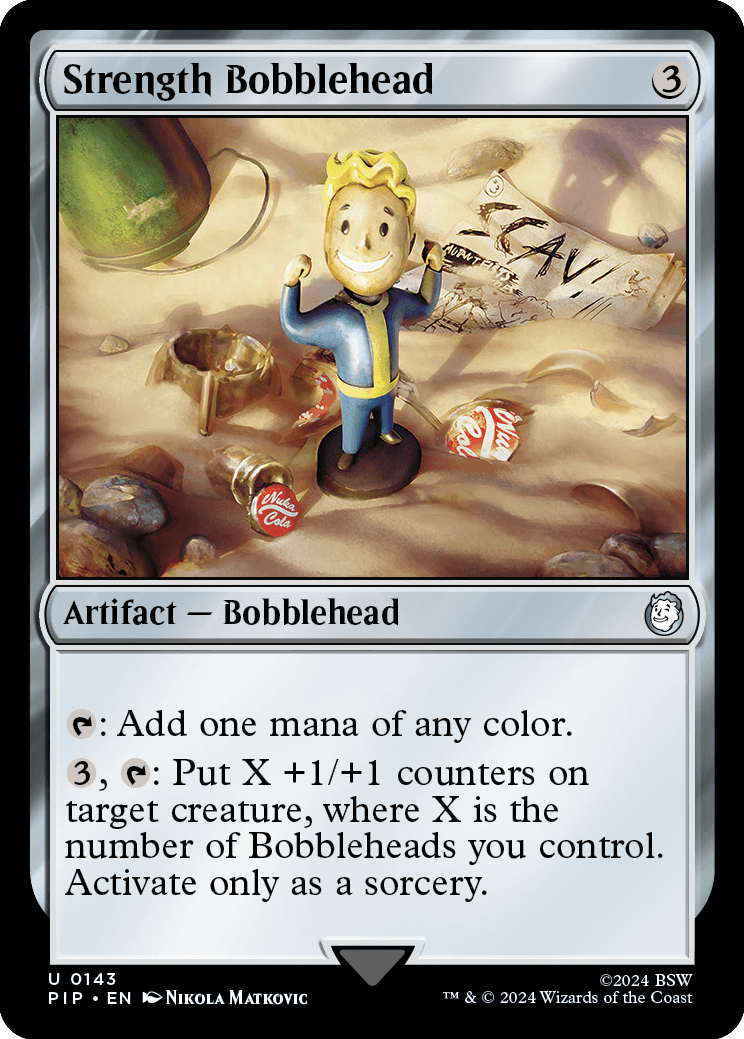
Strength Bobblehead
{3}
Artifact — Bobblehead
{T}: Add one mana of any color.
{3}, {T}: Put X +1/+1 counters on target creature, where X is the number of Bobbleheads you control. Activate only as a sorcery.
- The value of X is determined only once, as Strength Bobblehead's last ability resolves.
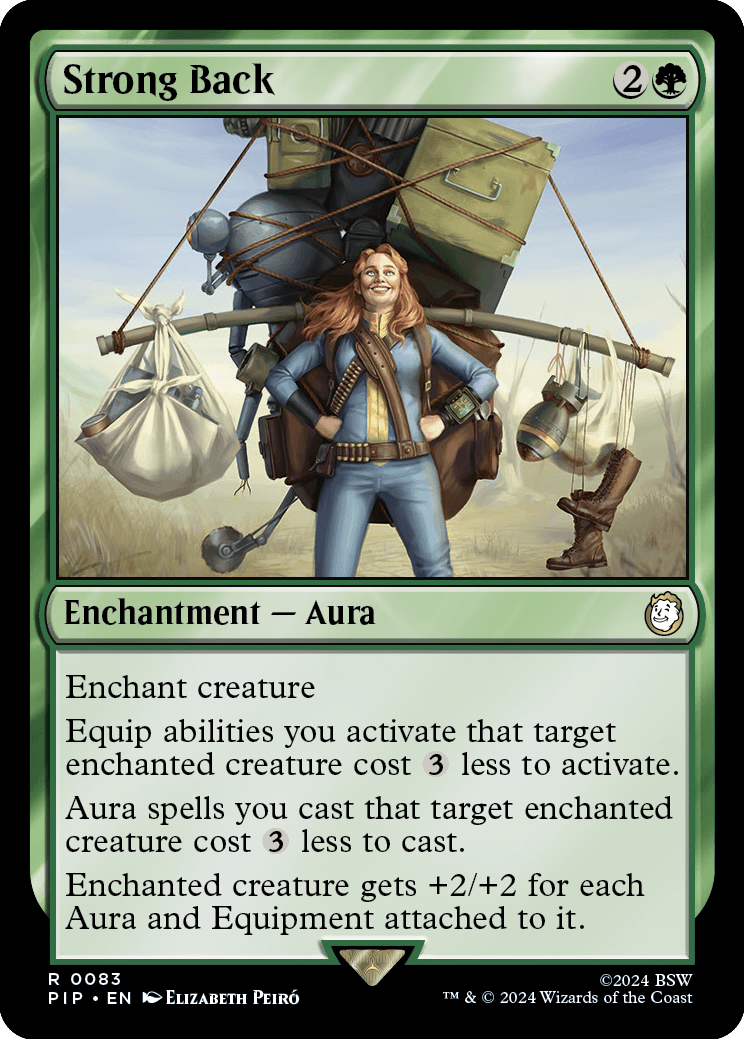
Strong Back
{2}{G}
Enchantment — Aura
Enchant creature
Equip abilities you activate that target enchanted creature cost {3} less to activate.
Aura spells you cast that target enchanted creature cost {3} less to cast.
Enchanted creature gets +2/+2 for each Aura and Equipment attached to it.
- Strong Back's abilities reduce only the amount of generic mana in equip abilities that target the enchanted creature and in the total cost of Aura spells that target the enchanted creature. For example, it will reduce the total cost of Animal Friend from {1}{G} to {G}.
- Strong Back's third ability won't reduce its own cost.
- Some Equipment creature cards in other sets have reconfigure, a different ability that attaches them to a creature. Reconfigure is not an equip ability, and reconfigure costs are not reduced by Strong Back's second ability. Equip variants or equip abilities with restrictions, like the "equip Citizen" ability of Ceremonial Groundbreaker from the Streets of New Capenna set, are still equip abilities, and their costs will be reduced by Strong Back's second ability.
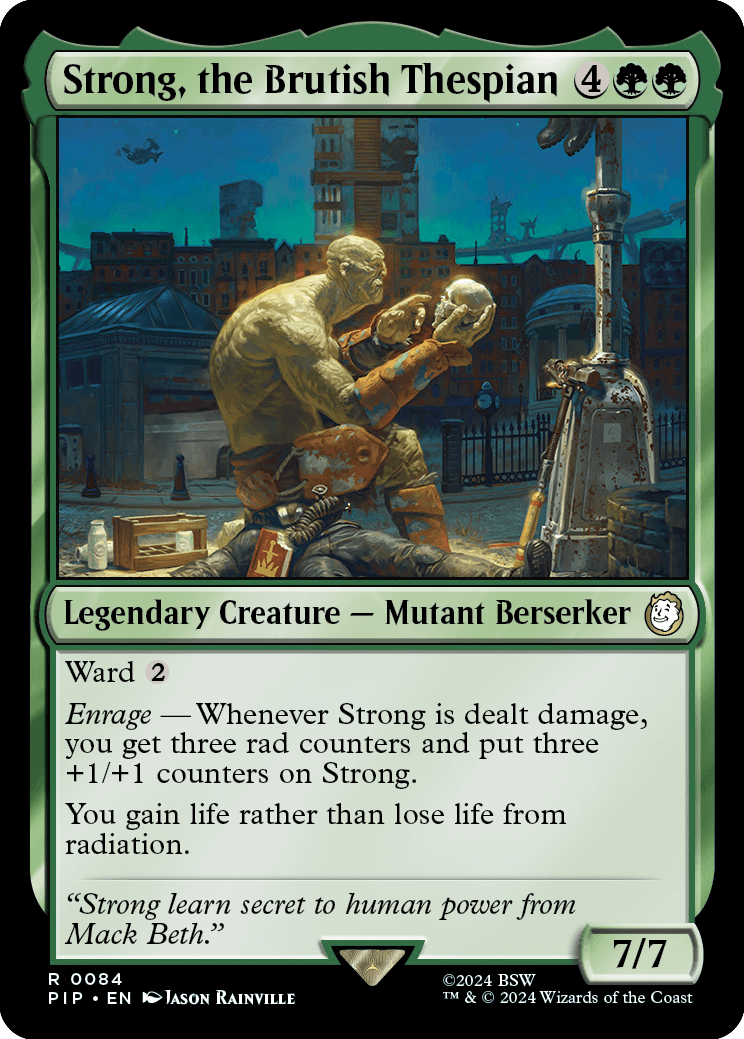
Strong, the Brutish Thespian
{4}{G}{G}
Legendary Creature — Mutant Berserker
7/7
Ward {2}
Enrage — Whenever Strong is dealt damage, you get three rad counters and put three +1/+1 counters on Strong.
You gain life rather than lose life from radiation.
- If multiple sources deal damage to Strong at the same time, most likely because multiple creatures blocked it, its enrage ability will trigger only once.
- If lethal damage is dealt to Strong, its enrage ability triggers. Strong leaves the battlefield before that ability resolves, so you won't put three +1/+1 counters on it. In this or any other case where Strong is no longer on the battlefield when its enrage ability resolves, you'll still get three rad counters.
- Strong's last ability changes what happens when the inherent triggered ability associated with having rad counters resolves. You'll still mill cards equal to the number of rad counters you have, and you'll still remove a rad counter from yourself for each nonland card you milled, but instead of losing life, you'll gain 1 life for each nonland card you milled.

Struggle for Project Purity
{3}{U}
Enchantment
As Struggle for Project Purity enters the battlefield, choose Brotherhood or Enclave.
• Brotherhood — At the beginning of your upkeep, each opponent draws a card. You draw a card for each card drawn this way.
• Enclave — Whenever a player attacks you with one or more creatures, that player gets twice that many rad counters.)
- The number of rad counters the attacking player gets when the "Enclave" triggered ability resolves is based on the number of creatures they declared as attackers. Removing creatures from combat won't reduce the number of rad counters they get. Similarly, creatures that enter the battlefield attacking but weren't declared as attackers won't increase the number of rad counters they get.
- If you somehow control Struggle for Project Purity and no choice was made for it (perhaps because another permanent on the battlefield became a copy of it), it has neither of the two triggered abilities.
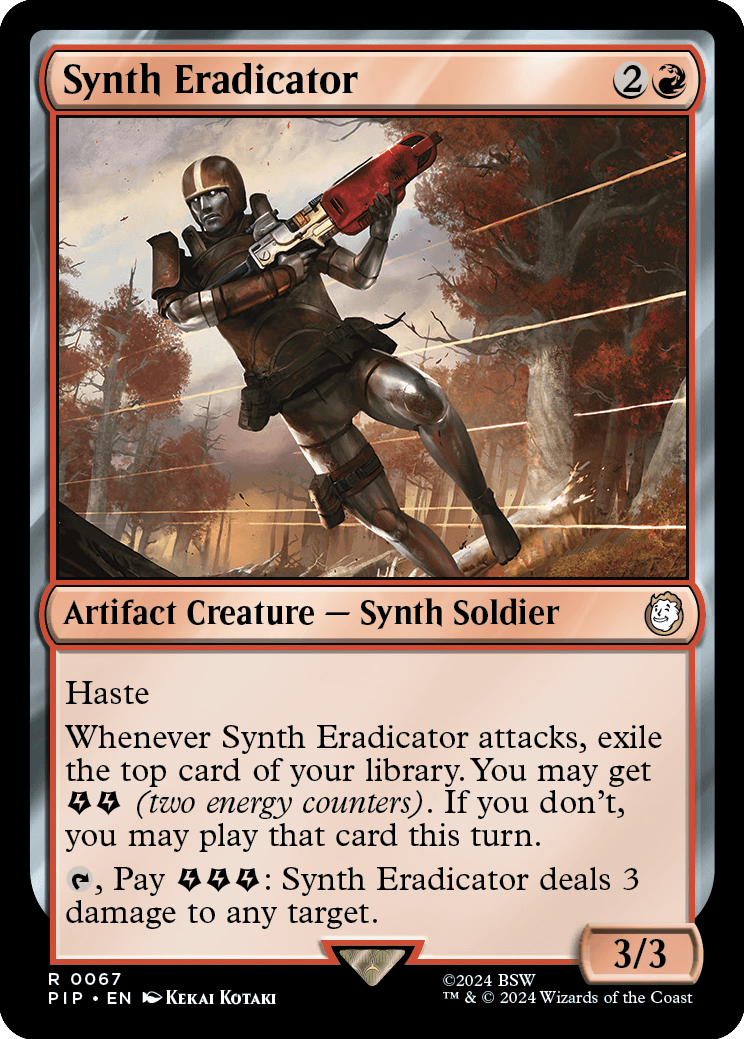
Synth Eradicator
{2}{R}
Artifact Creature — Synth Soldier
3/3
Haste
Whenever Synth Eradicator attacks, exile the top card of your library. You may get {E}{E} (two energy counters). If you don't, you may play that card this turn.
{T}, Pay {E}{E}{E}: Synth Eradicator deals 3 damage to any target.
- You pay all costs and follow all normal timing rules for the card played from exile with Synth Eradicator's second ability. For example, if the exiled card is a land card, you may play it only during your main phase while the stack is empty.

Synth Infiltrator
{3}{U}{U}
Artifact Creature — Synth
0/0
Improvise (Your artifacts can help cast this spell. Each artifact you tap after you're done activating mana abilities pays for {1}.)
You may have Synth Infiltrator enter the battlefield as a copy of any creature on the battlefield, except it's a Synth artifact creature in addition to its other types.
- Improvise doesn't change Synth Infiltrator's mana cost or mana value, and it can't reduce Synth Infiltrator's cost below {U}{U}.
- Except for being a Synth artifact creature in addition to its other types, Synth Infiltrator copies exactly what was printed on the original creature and nothing else (unless that creature is copying something else or is a token; see below). It doesn't copy whether that creature is tapped or untapped, whether it has any counters on it or Auras and Equipment attached to it, or any non-copy effects that have changed its power, toughness, types, color, and so on.
- If the copied creature has {X} in its mana cost, X is 0.
- If the copied creature is a token, Synth Infiltrator copies the original characteristics of that token as stated by the effect that created that token, with the noted exceptions.
- If the copied creature is copying something else, then Synth Infiltrator enters the battlefield as whatever that creature copied, with the noted exceptions.
- Any enters-the-battlefield abilities of the copied creature will trigger when Synth Infiltrator enters the battlefield. Any "as [this creature] enters the battlefield" or "[this creature] enters the battlefield with" abilities of the copied creature will also work.
- You can choose not to have Synth Infiltrator enter the battlefield as a copy of another creature. If you do, it will probably die due to having 0 toughness. (This is probably not the kind of innovation the Institute would approve of.)

T-45 Power Armor
{2}
Artifact — Equipment
When T-45 Power Armor enters the battlefield, you get {E}{E} (two energy counters).
Equipped creature gets +3/+3 and doesn't untap during its controller's untap step.
At the beginning of your upkeep, you may pay {E}. If you do, untap equipped creature, then put your choice of a menace, trample, or lifelink counter on it.
Equip {3}
- Multiple instances of menace are redundant. The same is true for trample and lifelink.
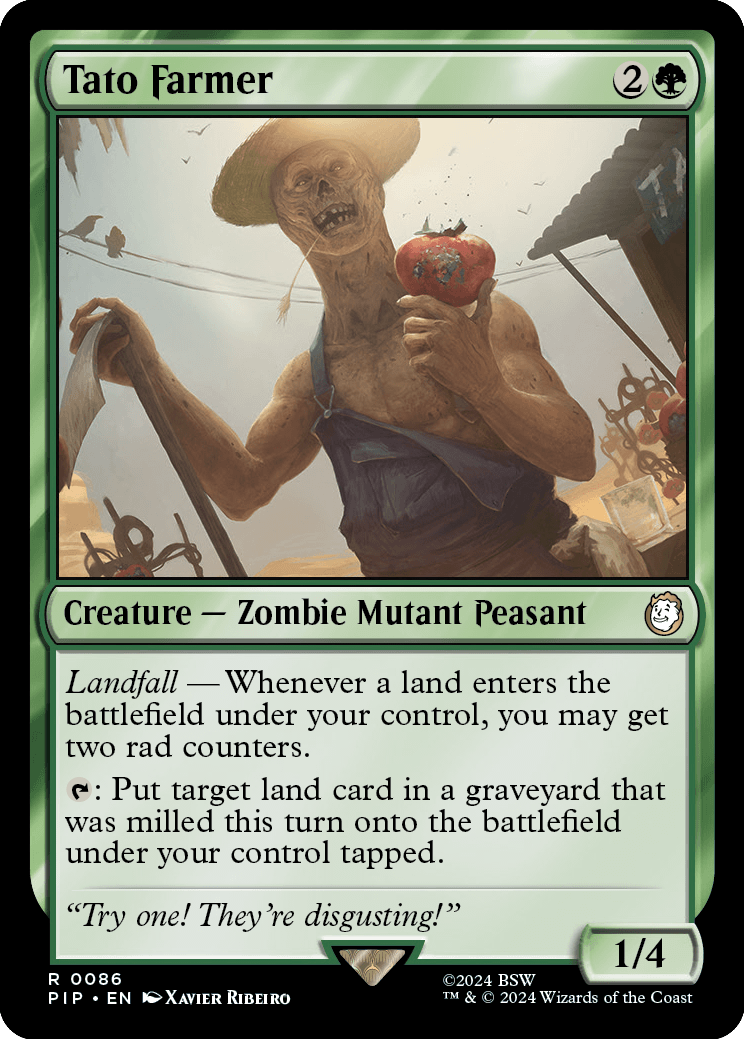
Tato Farmer
{2}{G}
Creature — Zombie Mutant Peasant
1/4
Landfall — Whenever a land enters the battlefield under your control, you may get two rad counters.
{T}: Put target land card in a graveyard that was milled this turn onto the battlefield under your control tapped.
- If a player is instructed to put a card into their graveyard from their library without using the word "mill," (by the effect of Rowan's Grim Search from Wilds of Eldraine, for example), that card isn't a legal target for Tato Farmer's last ability.
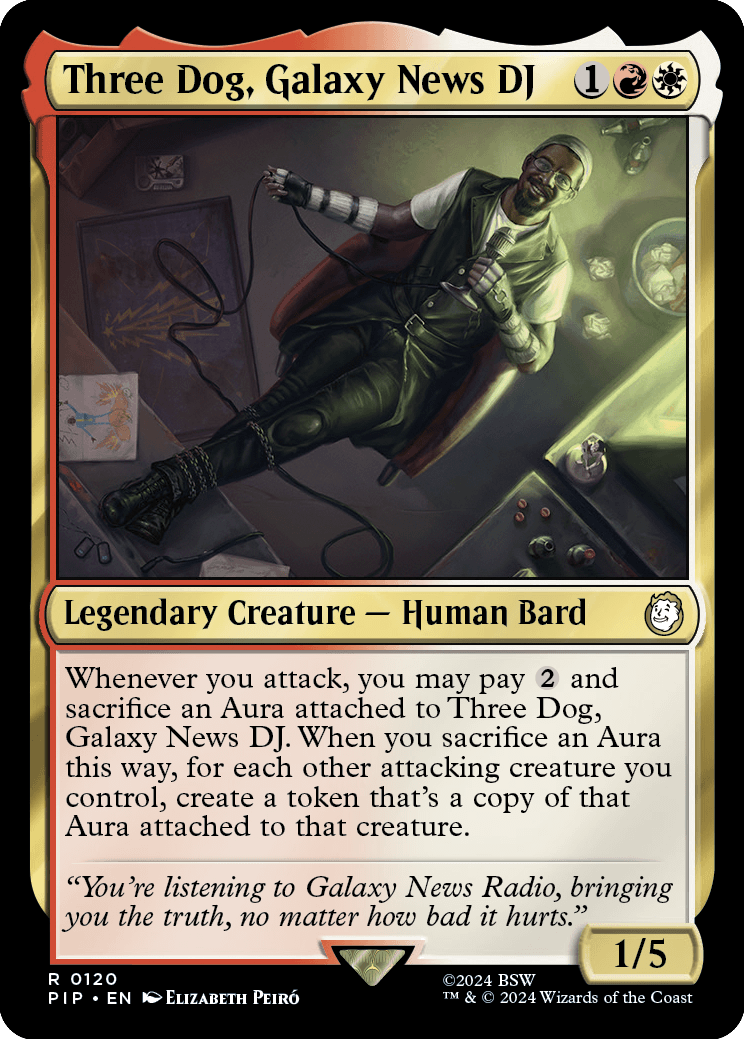
Three Dog, Galaxy News DJ
{1}{R}{W}
Legendary Creature — Human Bard
1/5
Whenever you attack, you may pay {2} and sacrifice an Aura attached to Three Dog, Galaxy News DJ. When you sacrifice an Aura this way, for each other attacking creature you control, create a token that's a copy of that Aura attached to that creature.
- Since Three Dog's reflexive triggered ability doesn't target, Aura tokens created by that ability will be attached to attacking creatures you control with shroud.
- If one of the Aura tokens being created couldn't legally be attached to the appropriate attacking creature (because of an ability like protection from enchantments), that Aura token won't be created.
- The tokens copy exactly what was printed on the original Aura and nothing else (unless that Aura was itself copying something else; see below). It doesn't copy whether that Aura was tapped or untapped, whether it had any counters on it or Auras attached to it, or any non-copy effects that changed its types, color, and so on.
- If the copied Aura was copying something else, the tokens enter the battlefield as whatever that Aura was copying.
- If the copied Aura had {X} in its mana cost, X is 0.
- Any enters-the-battlefield abilities of the copied Aura will trigger when the tokens enter the battlefield. Any "as [this Aura] enters the battlefield" or "[this Aura] enters the battlefield with" abilities of the Aura will also work.
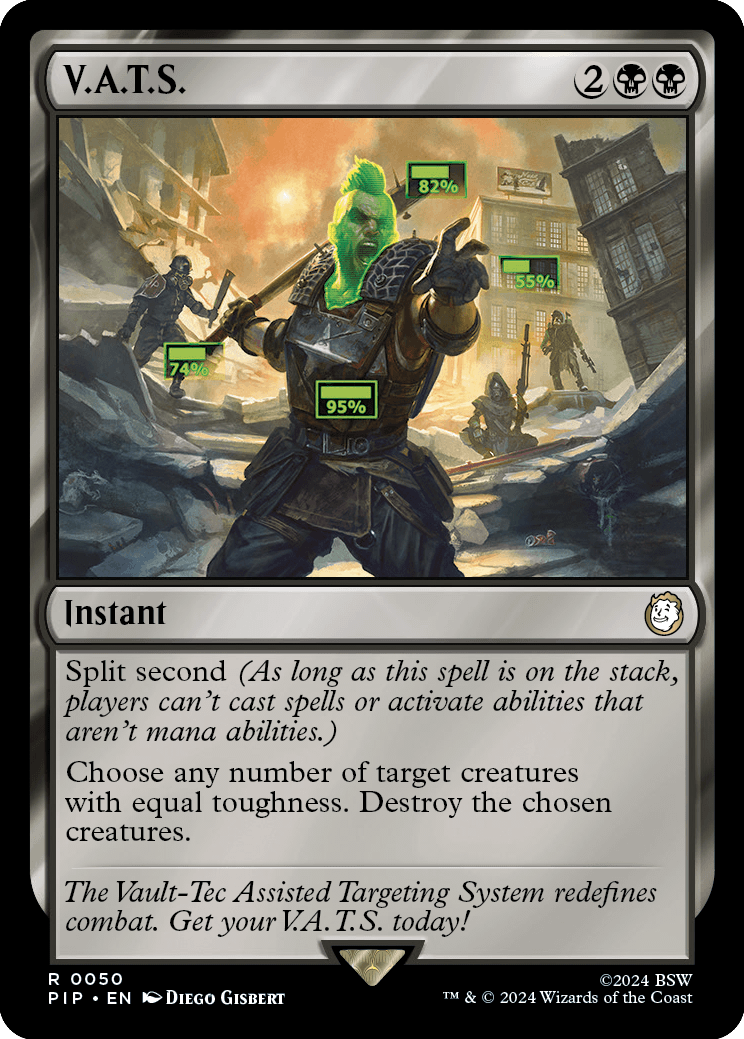
V.A.T.S.
{2}{B}{B}
Instant
Split second (As long as this spell is on the stack, players can't cast spells or activate abilities that aren't mana abilities.)
Choose any number of target creatures with equal toughness. Destroy the chosen creatures.
- Players still get priority while a spell with split second is on the stack; their options are just limited to mana abilities and certain special actions.
- Players may turn face-down creatures face up while a spell with split second is on the stack.
- Split second doesn't stop triggered abilities from triggering. If one does, its controller puts it on the stack and chooses targets for it, if any. Those abilities will resolve as normal.
- Casting a spell with split second won't affect spells and abilities that are already on the stack.
- If the resolution of a triggered ability involves casting a spell, that spell can't be cast if a spell with split second is on the stack.
- After a spell with split second resolves (or otherwise leaves the stack), players may again cast spells and activate abilities before the next object on the stack resolves.
- If you choose just one target for V.A.T.S., that creature will be destroyed when V.A.T.S. resolves as long as it's still a legal target, regardless of whether or not its toughness has changed since V.A.T.S. was cast.
- In the rare case where the legal targets no longer all have equal toughness (probably because of a triggered ability or special action) when V.A.T.S. tries to resolve, it won't resolve. None of the chosen creatures will be destroyed.

Vault 11: Voter's Dilemma
{2}{W}{B}
Enchantment — Saga
(As this Saga enters and after your draw step, add a lore counter. Sacrifice after III.)
I — For each opponent, you create a 1/1 white Human Soldier creature token.
II, III — Each player secretly votes for up to one creature, then those votes are revealed. If no creature got votes, each player draws a card. Otherwise, destroy each creature with the most votes or tied for most votes.
- To secretly vote, each player writes down their chosen option without showing it to anyone else. Each player then keeps their vote secret until all players simultaneously reveal their votes.
- Before secret votes are revealed, players may announce how they intend to vote, but they can't reveal what they actually wrote down until all votes are simultaneously revealed. Players can lie about how they intend to vote before the votes are revealed.
- Abilities that trigger "whenever players finish voting" trigger once all players have voted or once all secret votes are revealed, but they won't go on the stack until the current spell or ability finishes resolving.
- No player votes until Vault 11's last ability resolves. Any responses to the ability must be made without knowing the outcome of the vote.
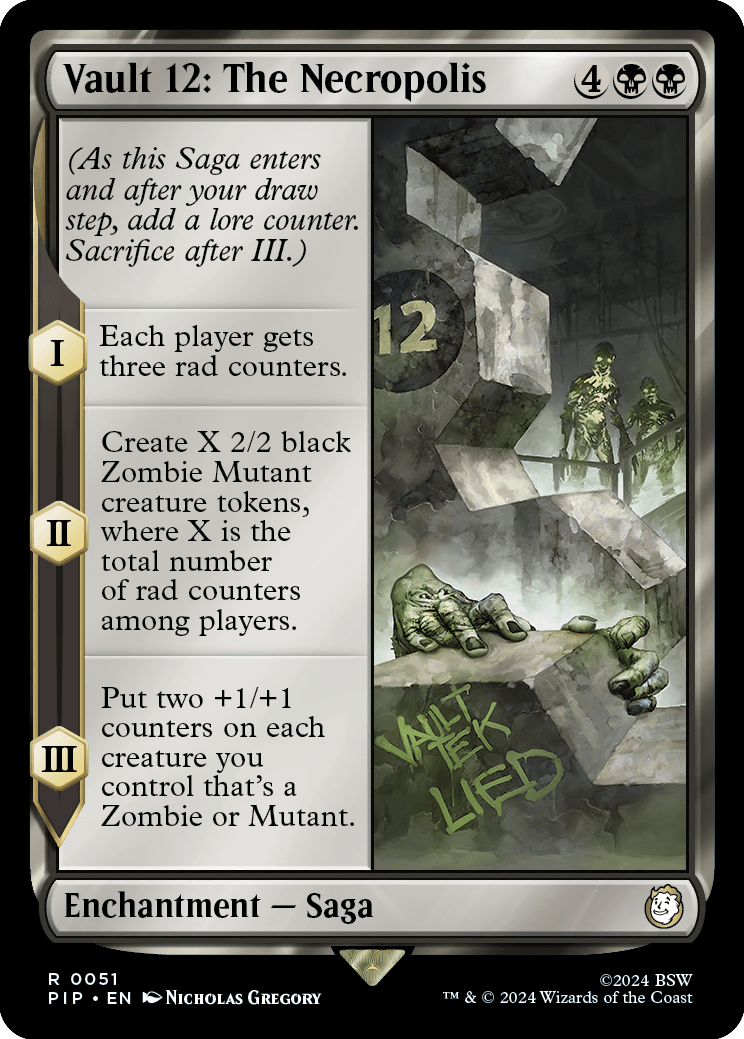
Vault 12: The Necropolis
{4}{B}{B}
Enchantment — Saga
(As this Saga enters and after your draw step, add a lore counter. Sacrifice after III.)
I — Each player gets three rad counters.
II — Create X 2/2 black Zombie Mutant creature tokens, where X is the total number of rad counters among players.
III — Put two +1/+1 counters on each creature you control that's a Zombie or Mutant.
- Use the number of rad counters among all players still in the game when Vault 12's second chapter ability resolves to determine the value of X.
- A creature you control that's both a Zombie and a Mutant will get only two +1/+1 counters from Vault 12's last ability.
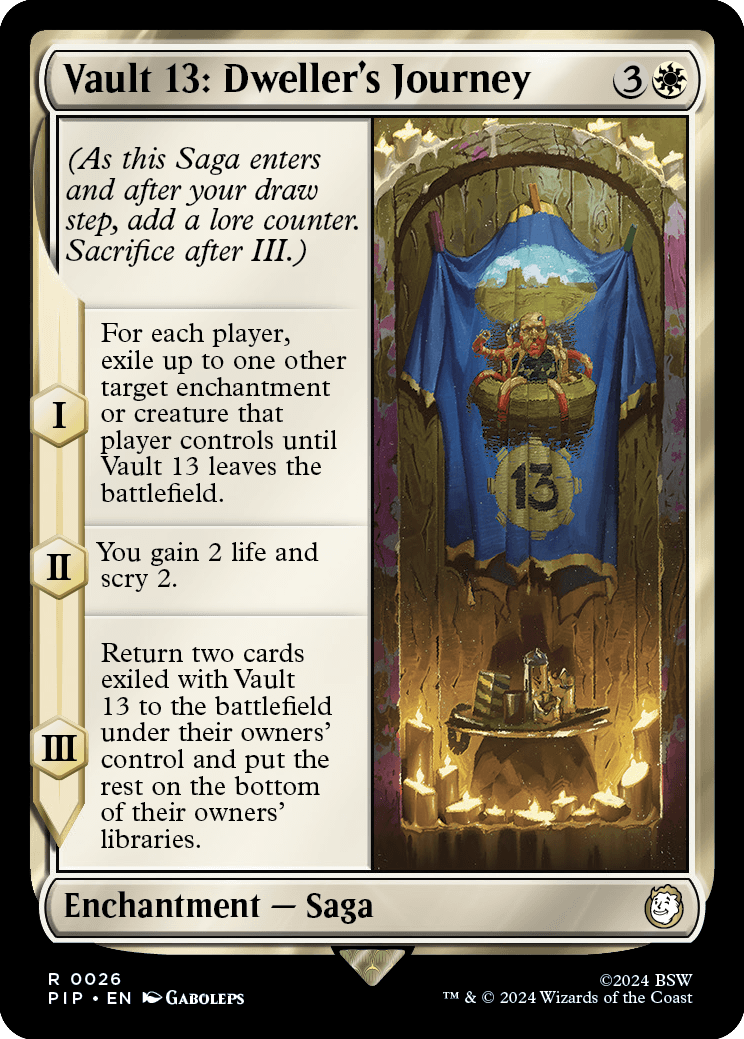
Vault 13: Dweller's Journey
{3}{W}
Enchantment — Saga
(As this Saga enters and after your draw step, add a lore counter. Sacrifice after III.)
I — For each player, exile up to one other target enchantment or creature that player controls until Vault 13 leaves the battlefield.
II — You gain 2 life and scry 2.
III — Return two cards exiled with Vault 13 to the battlefield under their owners' control and put the rest on the bottom of their owners' libraries.
- If Vault 13 leaves the battlefield before its first chapter ability resolves, the target permanents won't be exiled at all.
- In the unusual case where one player owns multiple cards exiled with Vault 13 that are being put on the bottom of their library with its third chapter ability, the owner of those cards chooses the order in which they are put on the bottom of their library.

Vault 21: House Gambit
{1}{R}
Enchantment — Saga
(As this Saga enters and after your draw step, add a lore counter. Sacrifice after III.)
I, II — Discard a card, then draw a card.
III — Reveal up to five nonland cards from your hand. For each of those cards that has the same mana value as another card revealed this way, create a Treasure token.
- If a card in your hand has {X} in its mana cost, X is 0.

Vault 87: Forced Evolution
{3}{G}{U}
Enchantment — Saga
(As this Saga enters and after your draw step, add a lore counter. Sacrifice after III.)
I — Gain control of target non-Mutant creature for as long as you control Vault 87.
II — Put a +1/+1 counter on target creature you control. It becomes a Mutant in addition to its other types.
III — Draw cards equal to the greatest power among Mutants you control.
- If Vault 87 leaves the battlefield before its first chapter ability resolves, you won't gain control of the target creature at all.
- The target of Vault 87's first chapter ability only needs to be a non-Mutant when that ability is put onto the stack and when that ability resolves. The control effect won't end if it later becomes a Mutant (perhaps because of the effect of the second chapter ability).
- Use the greatest power among Mutants you control as Vault 87's last ability resolves to determine how many cards to draw.
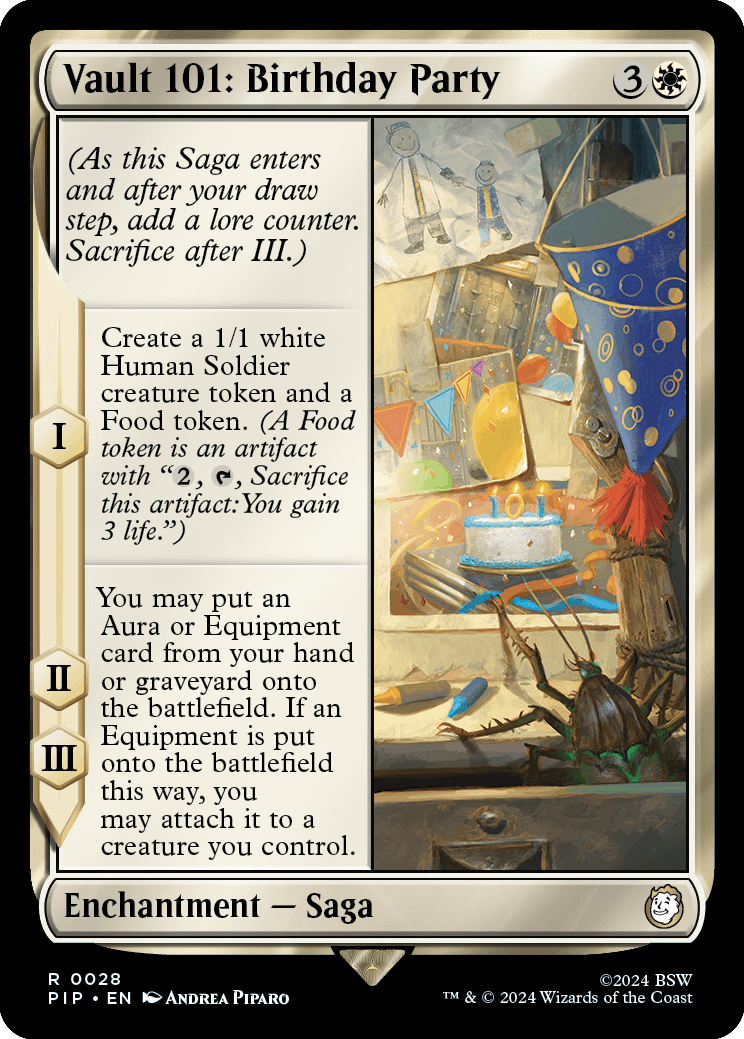
Vault 101: Birthday Party
{3}{W}
Enchantment — Saga
(As this Saga enters and after your draw step, add a lore counter. Sacrifice after III.)
I — Create a 1/1 white Human Soldier creature token and a Food token. (A Food token is an artifact with "{2}, {T}, Sacrifice this artifact: You gain 3 life.")
II, III — You may put an Aura or Equipment card from your hand or graveyard onto the battlefield. If an Equipment is put onto the battlefield this way, you may attach it to a creature you control.
- An Aura put onto the battlefield this way doesn't target anything (so it could be attached to an opponent's permanent with hexproof, for example), but the Aura's enchant ability restricts what it can be attached to. If the Aura can't legally be attached to anything, you can't choose to put it onto the battlefield at all.
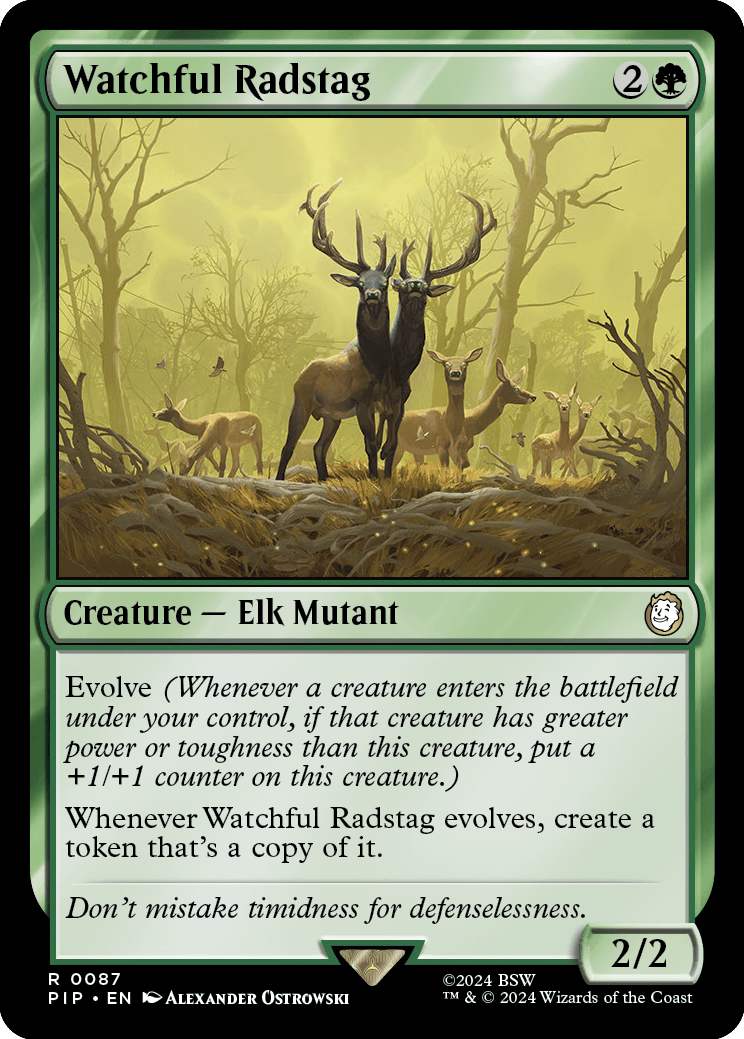
Watchful Radstag
{2}{G}
Creature — Elk Mutant
2/2
Evolve (Whenever a creature enters the battlefield under your control, if that creature has greater power or toughness than this creature, put a +1/+1 counter on this creature.)
Whenever Watchful Radstag evolves, create a token that's a copy of it.
- When comparing the stats of the two creatures for evolve, you always compare power to power and toughness to toughness.
- Whenever a creature enters the battlefield under your control, check its power and toughness against the power and toughness of the creature with evolve. If neither stat of the new creature is greater, evolve won't trigger at all.
- If evolve triggers, the stat comparison will happen again when the ability tries to resolve. If neither stat of the new creature is greater, the ability will do nothing. If the creature that entered the battlefield leaves the battlefield before evolve tries to resolve, use its last known power and toughness to compare the stats.
- If a creature enters the battlefield with +1/+1 counters on it, consider those counters when determining if evolve will trigger. For example, a 1/1 creature that enters the battlefield with two +1/+1 counters on it will cause the evolve ability of a 2/2 creature to trigger.
- If multiple creatures enter the battlefield at the same time, evolve may trigger multiple times, although the stat comparison will take place each time one of those abilities tries to resolve. For example, if you control a 2/2 creature with evolve and two 3/3 creatures enter the battlefield, evolve will trigger twice. The first ability will resolve and put a +1/+1 counter on the creature with evolve. When the second ability tries to resolve, neither the power nor the toughness of the new creature is greater than that of the creature with evolve, so that ability does nothing.
- When comparing the stats as the evolve ability resolves, it's possible that the stat that's greater changes from power to toughness or vice versa. If this happens, the ability will still resolve and you'll put a +1/+1 counter on the creature with evolve. For example, if you control a 2/2 creature with evolve and a 1/3 creature enters the battlefield under your control, its toughness is greater, so evolve will trigger. In response, the 1/3 creature gets +2/-2. When the evolve trigger tries to resolve, its power is greater. You'll put a +1/+1 counter on the creature with evolve.
- Watchful Radstag "evolves" when its evolve ability resolves and a +1/+1 counter is put on it. If a replacement effect causes the evolve ability to put more than one +1/+1 counter on Watchful Radstag, its last ability triggers only once. If no +1/+1 counter is put on it (perhaps because it left the battlefield while its evolve ability was still on the stack), then its last ability doesn't trigger.
- Watchful Radstag's last ability won't trigger if a +1/+1 counter is put on it for any reason other than its evolve ability resolving.
- The token copy will have Watchful Radstag's abilities. It will also be able to create copies of itself.
- The token copy won't copy counters or damage marked on Watchful Radstag, nor will it copy other effects that have changed Watchful Radstag's power, toughness, types, color, and so on. Normally, this means the token will simply be a Watchful Radstag, but if any copy effects have affected the original Watchful Radstag, the token will take those into account.
- If Watchful Radstag leaves the battlefield before its last ability resolves, the token will still enter the battlefield as a copy of Watchful Radstag, using Watchful Radstag's copiable values from when it was last on the battlefield.
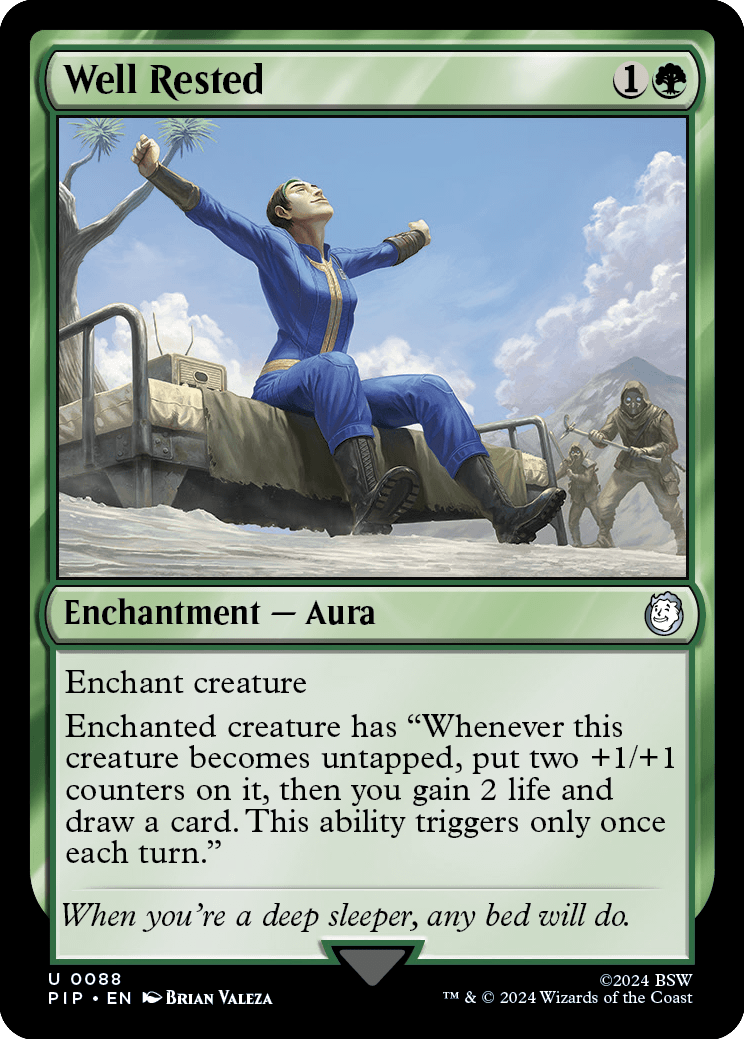
Well Rested
{1}{G}
Enchantment — Aura
Enchant creature
Enchanted creature has "Whenever this creature becomes untapped, put two +1/+1 counters on it, then you gain 2 life and draw a card. This ability triggers only once each turn."
- If the ability granted by Well Rested triggers in an untap step, it goes onto the stack at the beginning of the next step (usually the upkeep).
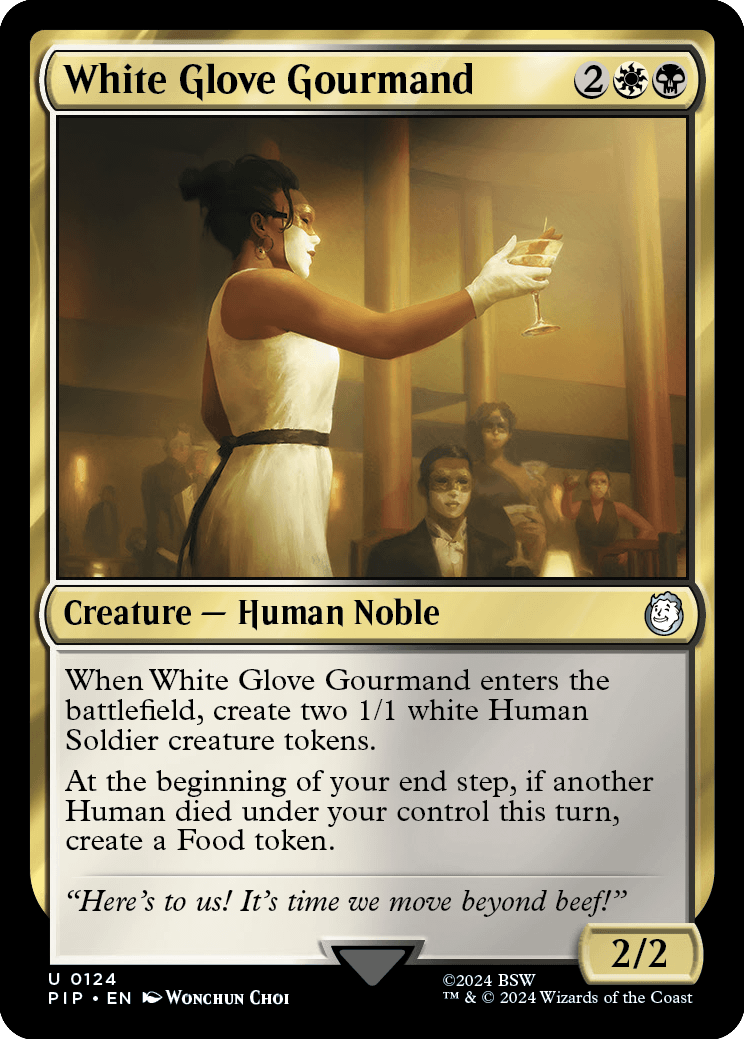
White Glove Gourmand
{2}{W}{B}
Creature — Human Noble
2/2
When White Glove Gourmand enters the battlefield, create two 1/1 white Human Soldier creature tokens.
At the beginning of your end step, if another Human died under your control this turn, create a Food token.
- White Glove Gourmand doesn't need to have been on the battlefield when the Human died. For example, if a Human dies during combat on your turn and you cast White Glove Gourmand during your second main phase, its last ability will trigger at the beginning of your end step.
- White Glove Gourmand's last ability will trigger only once during your end step, no matter how many Humans died under your control this turn. However, if no Humans have died under your control so far this turn as your end step begins, the ability won't trigger at all. It's not possible to cause a Human to die under your control during the end step in time to have the ability trigger.
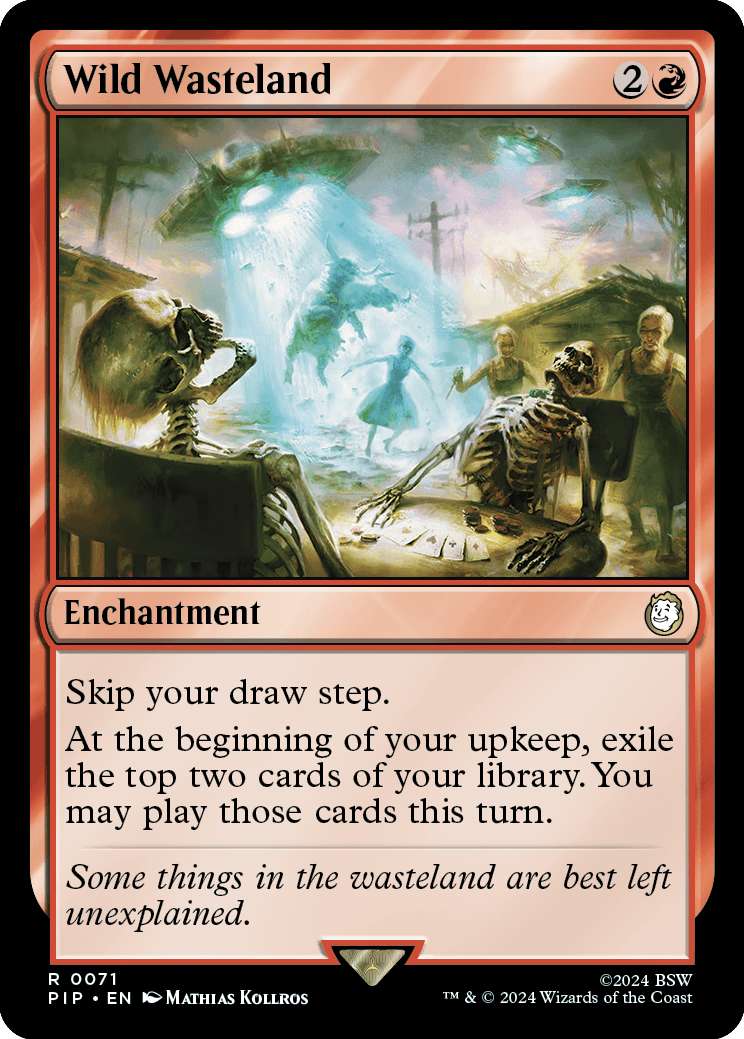
Wild Wasteland
{2}{R}
Enchantment
Skip your draw step.
At the beginning of your upkeep, exile the top two cards of your library. You may play those cards this turn.
- You pay all costs and follow all normal timing rules for cards played from exile with Wild Wasteland's ability. For example, if one of the exiled cards is a land card, you may play it only during your main phase while the stack is empty.
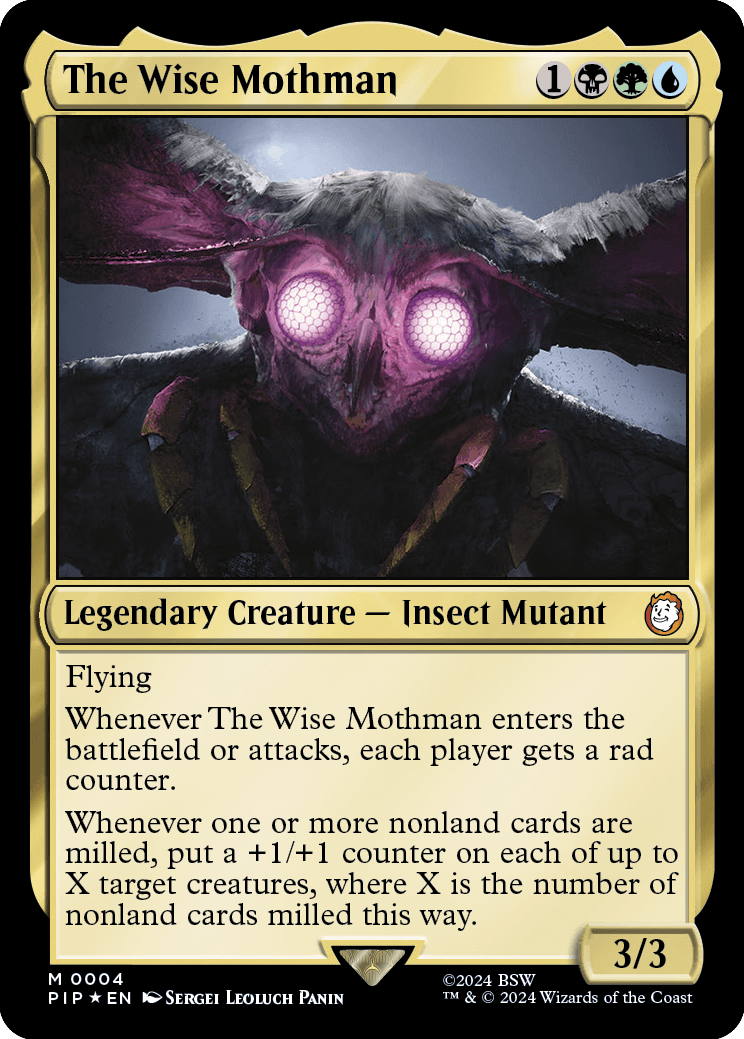
The Wise Mothman
{1}{B}{G}{U}
Legendary Creature — Insect Mutant
3/3
Flying
Whenever The Wise Mothman enters the battlefield or attacks, each player gets a rad counter.
Whenever one or more nonland cards are milled, put a +1/+1 counter on each of up to X target creatures, where X is the number of nonland cards milled this way.
- If more than one player is instructed to mill at the same time (by the activated ability of Raul, Trouble Shooter, for example), as long as at least one nonland card is milled, The Wise Mothman's last ability will trigger just once.
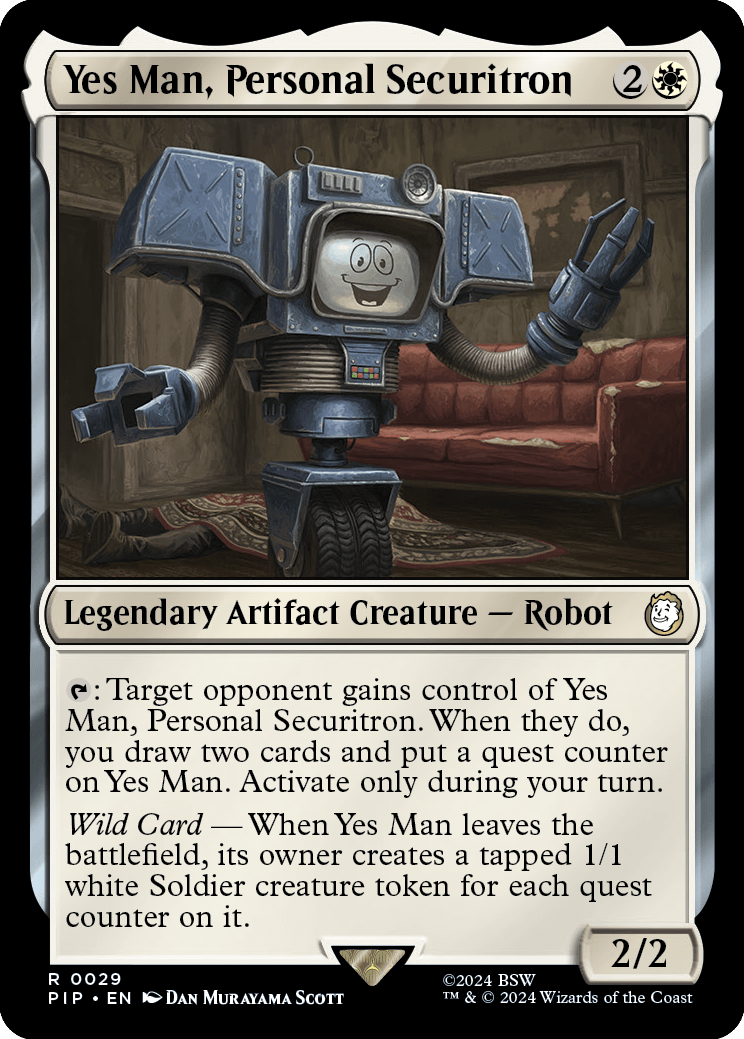
Yes Man, Personal Securitron
{2}{W}
Legendary Artifact Creature — Robot
2/2
{T}: Target opponent gains control of Yes Man, Personal Securitron. When they do, you draw two cards and put a quest counter on Yes Man. Activate only during your turn.
Wild Card — When Yes Man leaves the battlefield, its owner creates a tapped 1/1 white Soldier creature token for each quest counter on it.
- If Yes Man isn't on the battlefield as its first ability resolves, or if the target opponent is an illegal target as the ability tries to resolve, nothing will happen. You won't draw two cards, because that effect is part of a reflexive triggered ability that triggers only if the target opponent gains control of Yes Man.
- When Yes Man's controller leaves the game, if that player wasn't its owner, the effect giving that player control of Yes Man ends. Yes Man will return to the control of the player still in the game who most recently controlled it, ignoring any control effects whose durations have already expired.
- When Yes Man's owner leaves the game, Yes Man leaves the game along with that player. It's just doing what it's told.

Young Deathclaws
{2}{B}{G}
Creature — Lizard Mutant
4/2
Menace (This creature can't be blocked except by two or more creatures.)
Each creature card in your graveyard has scavenge. The scavenge cost is equal to its mana cost. (Exile a creature card from your graveyard and pay its mana cost: Put a number of +1/+1 counters equal to that card's power on target creature. Scavenge only as a sorcery.)
- Exiling the creature card with scavenge is part of the cost of activating the scavenge ability. Once the ability is activated and the cost is paid, it's too late to stop the ability from being activated by trying to remove the creature card from the graveyard.
- While Young Deathclaws is on the battlefield, the scavenge cost of a creature card in your graveyard is equal to its mana cost, including any colored mana requirements.
- The number of counters that a card's scavenge ability puts on a creature is based on the card's power as it last existed in the graveyard.
- If the creature card you scavenge has {X} in its mana cost, X is 0.
- If a creature card has multiple instances of scavenge, you can activate either ability (but not both, as the card will be exiled when you activate one of them). Young Deathclaws's ability doesn't affect the scavenge cost of a creature's other scavenge ability.
Magic: The Gathering, Magic, Zendikar, New Capenna, and Eldraine are property of Wizards in the USA and other countries. ©2024 Wizards.
© 2024 ZeniMax Media Inc. All Rights Reserved.
